Third Party Observations/Demonstrations
VerifiedAdded on 2022/08/24
|44
|6598
|21
AI Summary
Contribute Materials
Your contribution can guide someone’s learning journey. Share your
documents today.
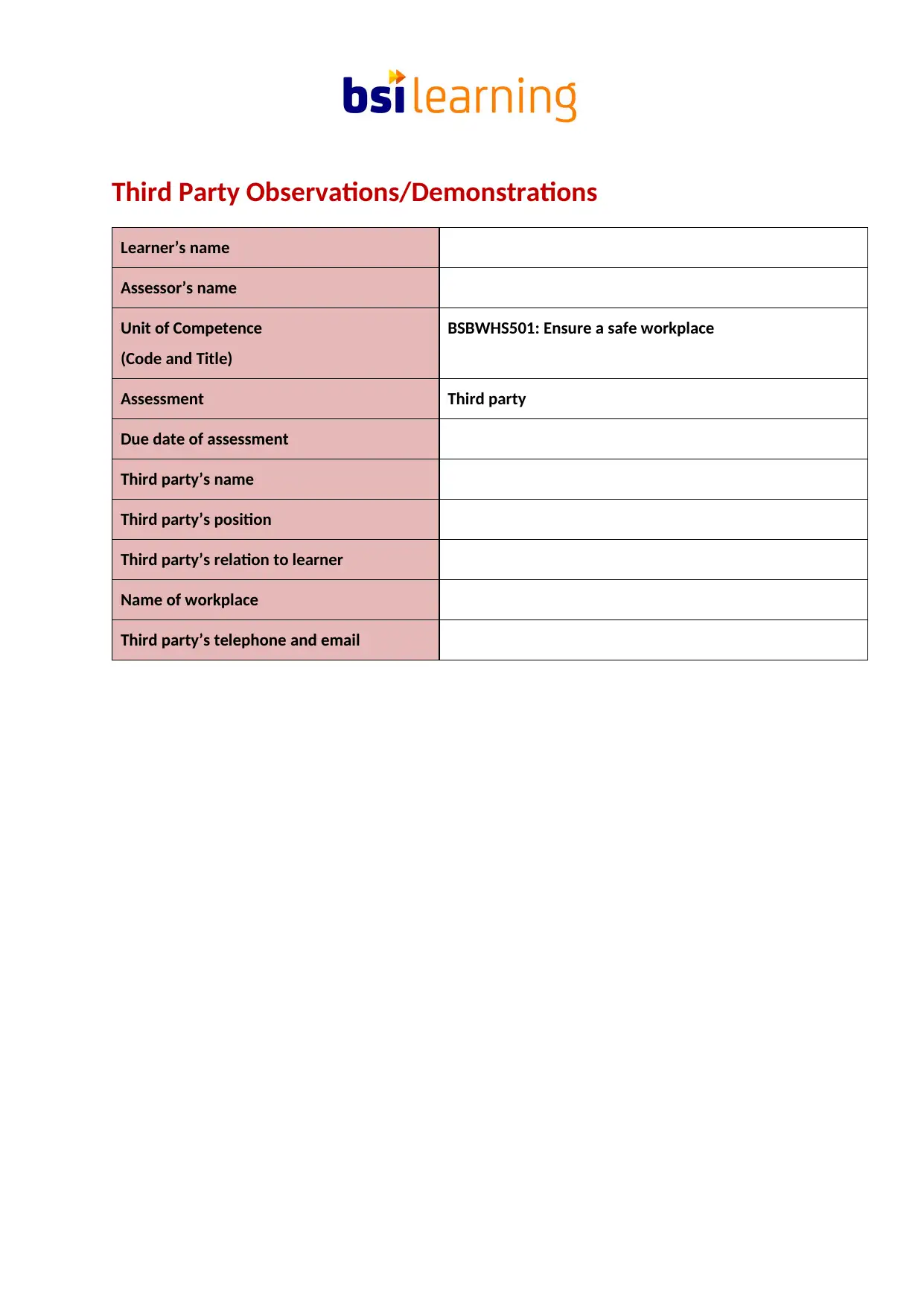
Third Party Observations/Demonstrations
Learner’s name
Assessor’s name
Unit of Competence
(Code and Title)
BSBWHS501: Ensure a safe workplace
Assessment Third party
Due date of assessment
Third party’s name
Third party’s position
Third party’s relation to learner
Name of workplace
Third party’s telephone and email
Learner’s name
Assessor’s name
Unit of Competence
(Code and Title)
BSBWHS501: Ensure a safe workplace
Assessment Third party
Due date of assessment
Third party’s name
Third party’s position
Third party’s relation to learner
Name of workplace
Third party’s telephone and email
Secure Best Marks with AI Grader
Need help grading? Try our AI Grader for instant feedback on your assignments.
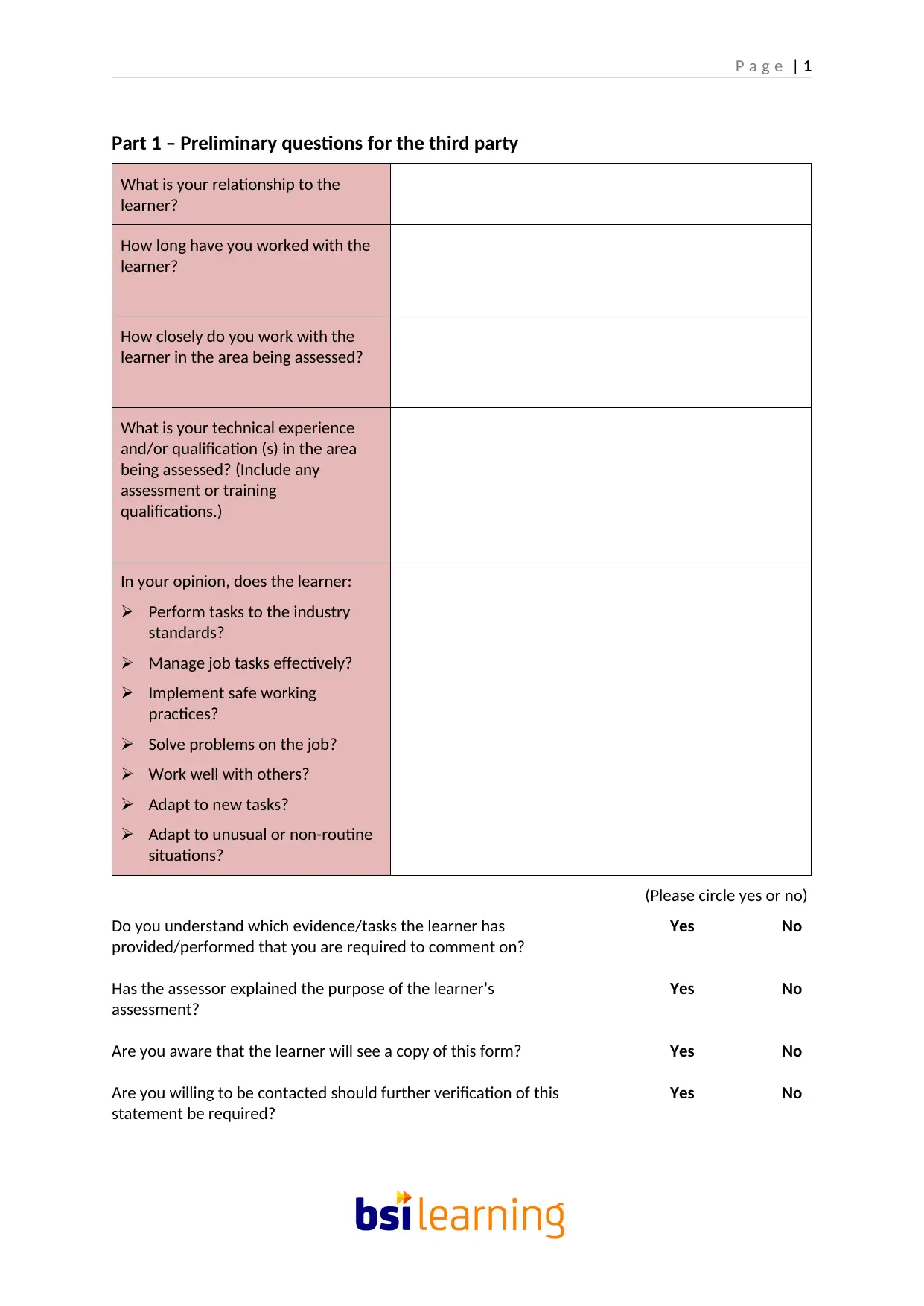
P a g e | 1
Part 1 – Preliminary questions for the third party
What is your relationship to the
learner?
How long have you worked with the
learner?
How closely do you work with the
learner in the area being assessed?
What is your technical experience
and/or qualification (s) in the area
being assessed? (Include any
assessment or training
qualifications.)
In your opinion, does the learner:
Perform tasks to the industry
standards?
Manage job tasks effectively?
Implement safe working
practices?
Solve problems on the job?
Work well with others?
Adapt to new tasks?
Adapt to unusual or non-routine
situations?
(Please circle yes or no)
Do you understand which evidence/tasks the learner has Yes No
provided/performed that you are required to comment on?
Has the assessor explained the purpose of the learner’s Yes No
assessment?
Are you aware that the learner will see a copy of this form? Yes No
Are you willing to be contacted should further verification of this Yes No
statement be required?
Part 1 – Preliminary questions for the third party
What is your relationship to the
learner?
How long have you worked with the
learner?
How closely do you work with the
learner in the area being assessed?
What is your technical experience
and/or qualification (s) in the area
being assessed? (Include any
assessment or training
qualifications.)
In your opinion, does the learner:
Perform tasks to the industry
standards?
Manage job tasks effectively?
Implement safe working
practices?
Solve problems on the job?
Work well with others?
Adapt to new tasks?
Adapt to unusual or non-routine
situations?
(Please circle yes or no)
Do you understand which evidence/tasks the learner has Yes No
provided/performed that you are required to comment on?
Has the assessor explained the purpose of the learner’s Yes No
assessment?
Are you aware that the learner will see a copy of this form? Yes No
Are you willing to be contacted should further verification of this Yes No
statement be required?
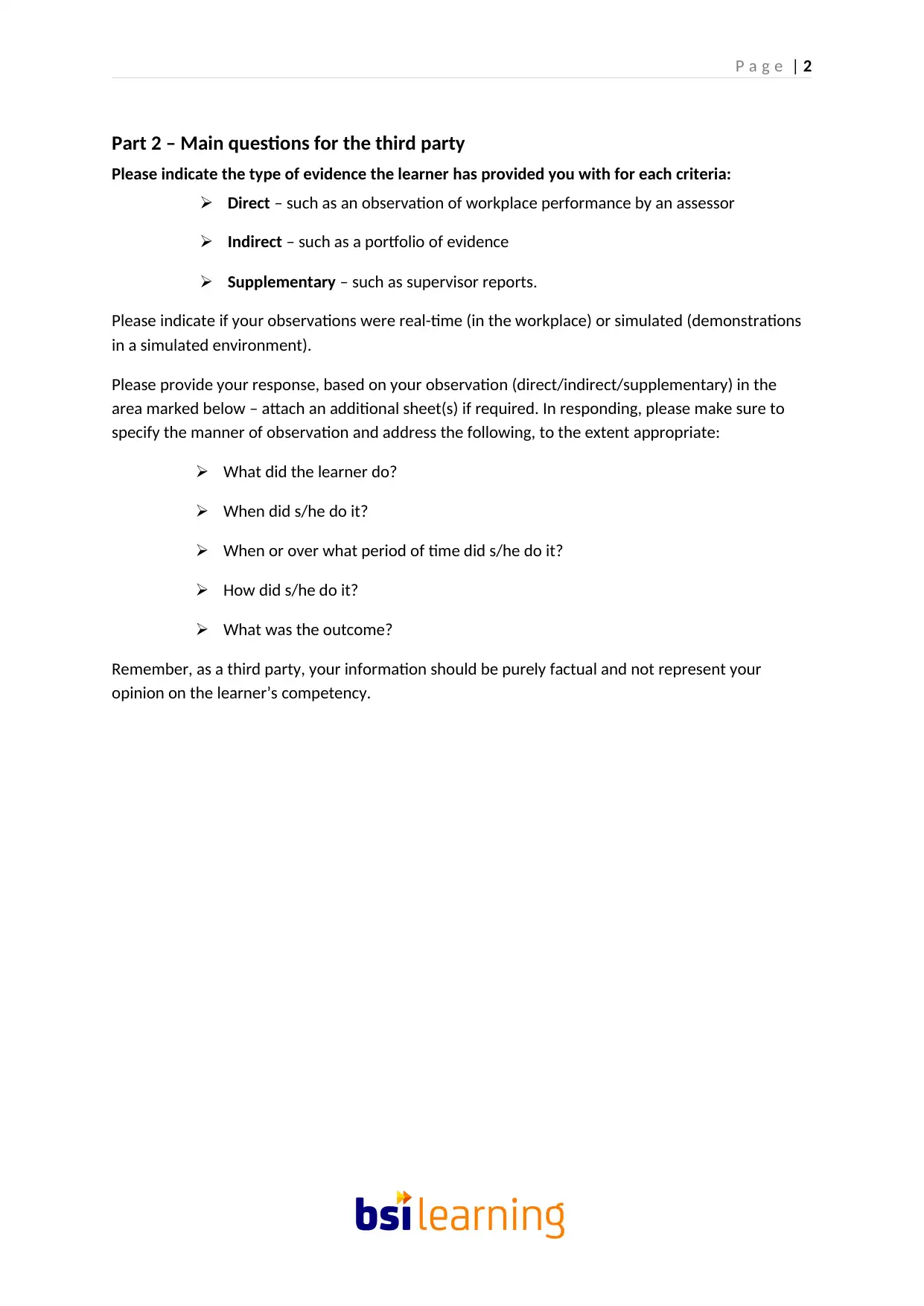
P a g e | 2
Part 2 – Main questions for the third party
Please indicate the type of evidence the learner has provided you with for each criteria:
Direct – such as an observation of workplace performance by an assessor
Indirect – such as a portfolio of evidence
Supplementary – such as supervisor reports.
Please indicate if your observations were real-time (in the workplace) or simulated (demonstrations
in a simulated environment).
Please provide your response, based on your observation (direct/indirect/supplementary) in the
area marked below – attach an additional sheet(s) if required. In responding, please make sure to
specify the manner of observation and address the following, to the extent appropriate:
What did the learner do?
When did s/he do it?
When or over what period of time did s/he do it?
How did s/he do it?
What was the outcome?
Remember, as a third party, your information should be purely factual and not represent your
opinion on the learner’s competency.
Part 2 – Main questions for the third party
Please indicate the type of evidence the learner has provided you with for each criteria:
Direct – such as an observation of workplace performance by an assessor
Indirect – such as a portfolio of evidence
Supplementary – such as supervisor reports.
Please indicate if your observations were real-time (in the workplace) or simulated (demonstrations
in a simulated environment).
Please provide your response, based on your observation (direct/indirect/supplementary) in the
area marked below – attach an additional sheet(s) if required. In responding, please make sure to
specify the manner of observation and address the following, to the extent appropriate:
What did the learner do?
When did s/he do it?
When or over what period of time did s/he do it?
How did s/he do it?
What was the outcome?
Remember, as a third party, your information should be purely factual and not represent your
opinion on the learner’s competency.
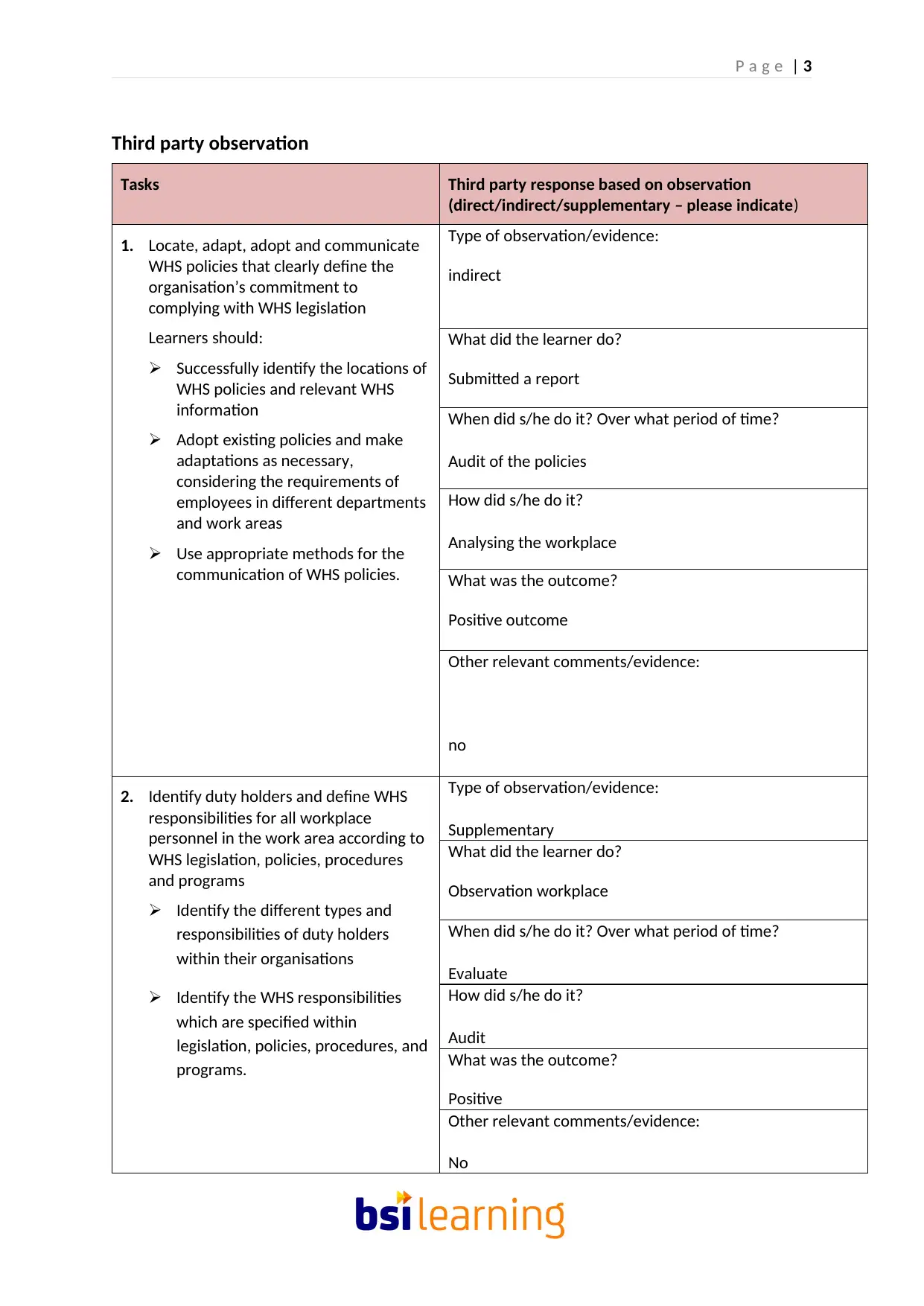
P a g e | 3
Third party observation
Tasks Third party response based on observation
(direct/indirect/supplementary – please indicate)
1. Locate, adapt, adopt and communicate
WHS policies that clearly define the
organisation’s commitment to
complying with WHS legislation
Learners should:
Successfully identify the locations of
WHS policies and relevant WHS
information
Adopt existing policies and make
adaptations as necessary,
considering the requirements of
employees in different departments
and work areas
Use appropriate methods for the
communication of WHS policies.
Type of observation/evidence:
indirect
What did the learner do?
Submitted a report
When did s/he do it? Over what period of time?
Audit of the policies
How did s/he do it?
Analysing the workplace
What was the outcome?
Positive outcome
Other relevant comments/evidence:
no
2. Identify duty holders and define WHS
responsibilities for all workplace
personnel in the work area according to
WHS legislation, policies, procedures
and programs
Identify the different types and
responsibilities of duty holders
within their organisations
Identify the WHS responsibilities
which are specified within
legislation, policies, procedures, and
programs.
Type of observation/evidence:
Supplementary
What did the learner do?
Observation workplace
When did s/he do it? Over what period of time?
Evaluate
How did s/he do it?
Audit
What was the outcome?
Positive
Other relevant comments/evidence:
No
Third party observation
Tasks Third party response based on observation
(direct/indirect/supplementary – please indicate)
1. Locate, adapt, adopt and communicate
WHS policies that clearly define the
organisation’s commitment to
complying with WHS legislation
Learners should:
Successfully identify the locations of
WHS policies and relevant WHS
information
Adopt existing policies and make
adaptations as necessary,
considering the requirements of
employees in different departments
and work areas
Use appropriate methods for the
communication of WHS policies.
Type of observation/evidence:
indirect
What did the learner do?
Submitted a report
When did s/he do it? Over what period of time?
Audit of the policies
How did s/he do it?
Analysing the workplace
What was the outcome?
Positive outcome
Other relevant comments/evidence:
no
2. Identify duty holders and define WHS
responsibilities for all workplace
personnel in the work area according to
WHS legislation, policies, procedures
and programs
Identify the different types and
responsibilities of duty holders
within their organisations
Identify the WHS responsibilities
which are specified within
legislation, policies, procedures, and
programs.
Type of observation/evidence:
Supplementary
What did the learner do?
Observation workplace
When did s/he do it? Over what period of time?
Evaluate
How did s/he do it?
Audit
What was the outcome?
Positive
Other relevant comments/evidence:
No
Secure Best Marks with AI Grader
Need help grading? Try our AI Grader for instant feedback on your assignments.
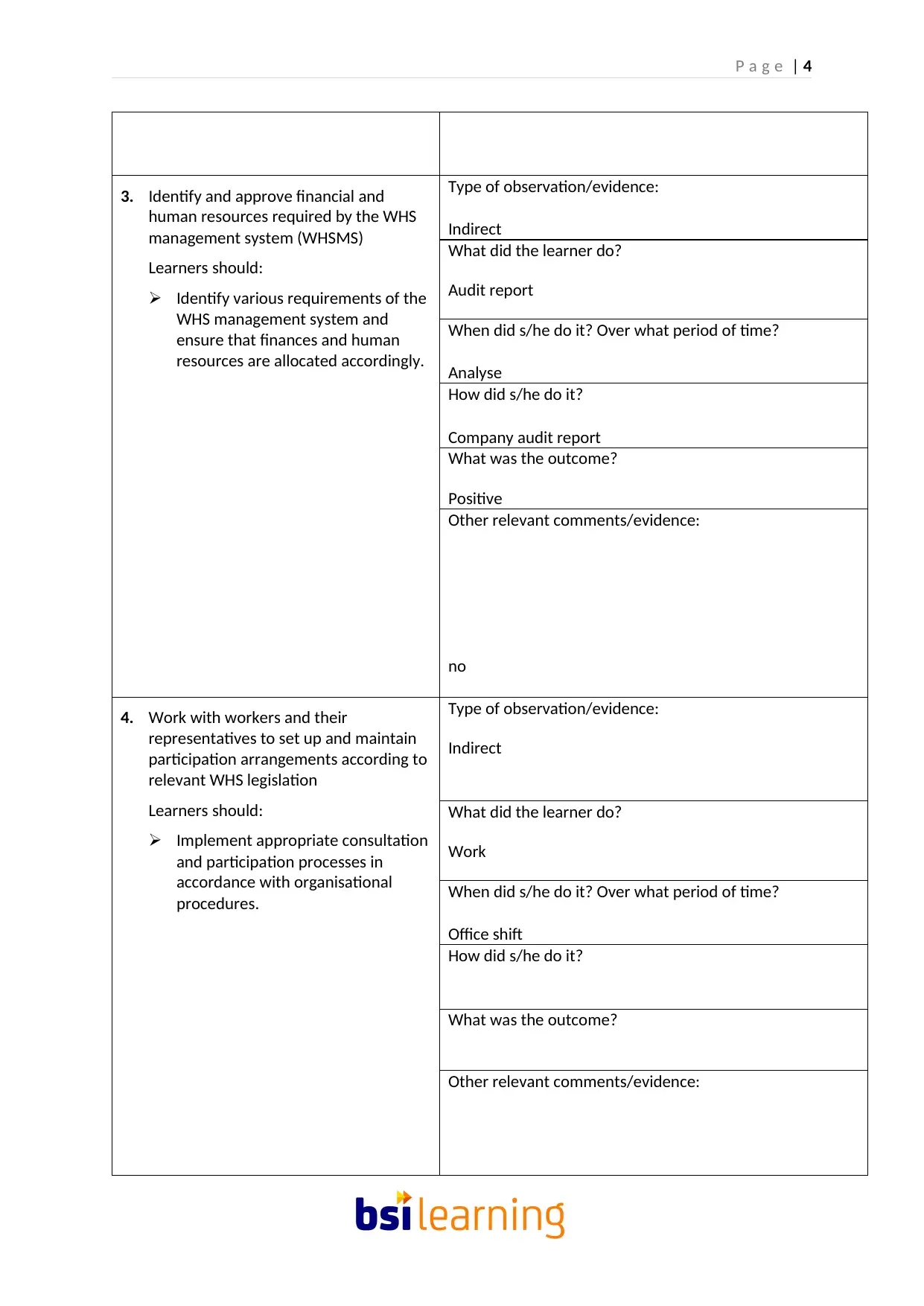
P a g e | 4
3. Identify and approve financial and
human resources required by the WHS
management system (WHSMS)
Learners should:
Identify various requirements of the
WHS management system and
ensure that finances and human
resources are allocated accordingly.
Type of observation/evidence:
Indirect
What did the learner do?
Audit report
When did s/he do it? Over what period of time?
Analyse
How did s/he do it?
Company audit report
What was the outcome?
Positive
Other relevant comments/evidence:
no
4. Work with workers and their
representatives to set up and maintain
participation arrangements according to
relevant WHS legislation
Learners should:
Implement appropriate consultation
and participation processes in
accordance with organisational
procedures.
Type of observation/evidence:
Indirect
What did the learner do?
Work
When did s/he do it? Over what period of time?
Office shift
How did s/he do it?
What was the outcome?
Other relevant comments/evidence:
3. Identify and approve financial and
human resources required by the WHS
management system (WHSMS)
Learners should:
Identify various requirements of the
WHS management system and
ensure that finances and human
resources are allocated accordingly.
Type of observation/evidence:
Indirect
What did the learner do?
Audit report
When did s/he do it? Over what period of time?
Analyse
How did s/he do it?
Company audit report
What was the outcome?
Positive
Other relevant comments/evidence:
no
4. Work with workers and their
representatives to set up and maintain
participation arrangements according to
relevant WHS legislation
Learners should:
Implement appropriate consultation
and participation processes in
accordance with organisational
procedures.
Type of observation/evidence:
Indirect
What did the learner do?
Work
When did s/he do it? Over what period of time?
Office shift
How did s/he do it?
What was the outcome?
Other relevant comments/evidence:
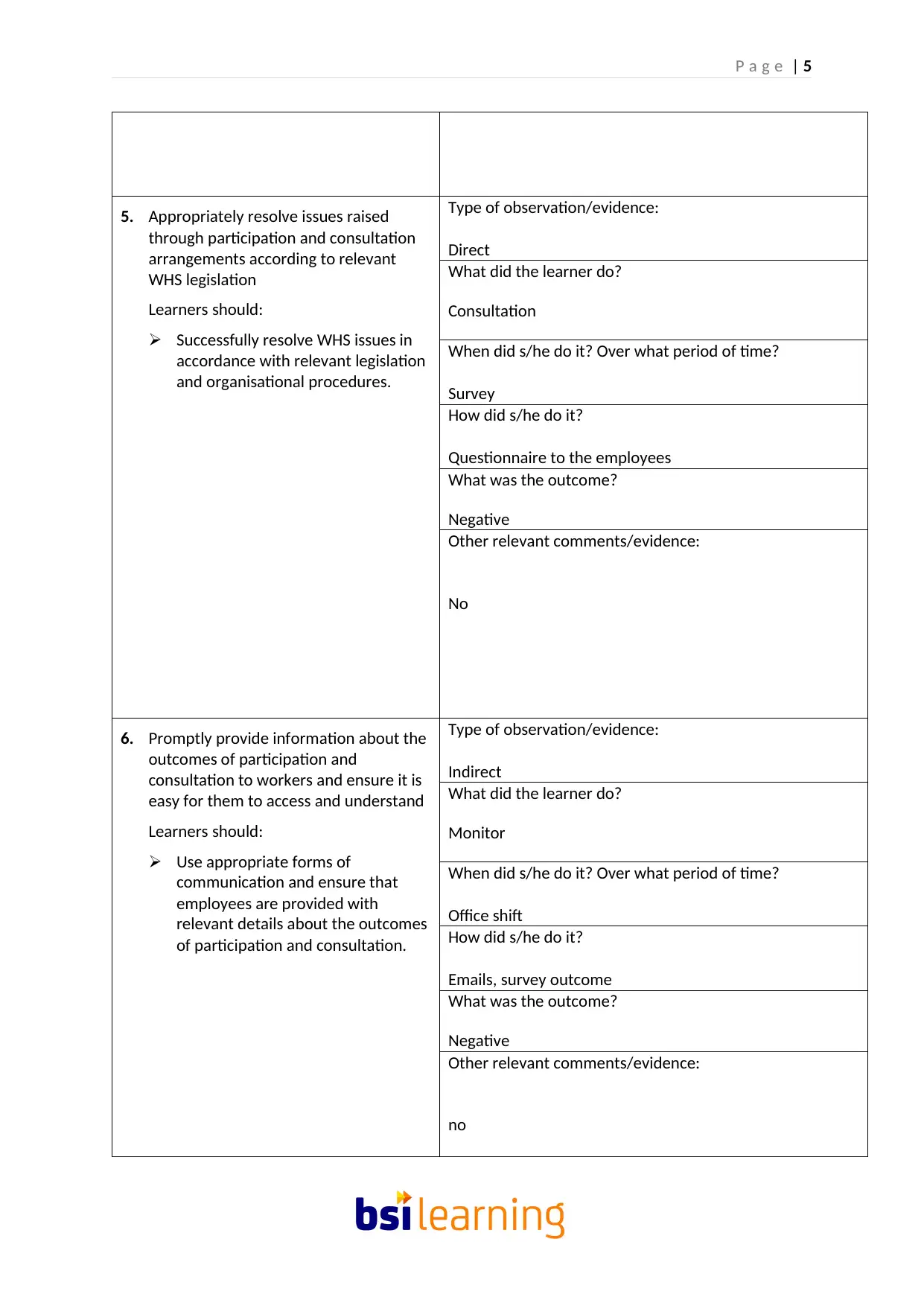
P a g e | 5
5. Appropriately resolve issues raised
through participation and consultation
arrangements according to relevant
WHS legislation
Learners should:
Successfully resolve WHS issues in
accordance with relevant legislation
and organisational procedures.
Type of observation/evidence:
Direct
What did the learner do?
Consultation
When did s/he do it? Over what period of time?
Survey
How did s/he do it?
Questionnaire to the employees
What was the outcome?
Negative
Other relevant comments/evidence:
No
6. Promptly provide information about the
outcomes of participation and
consultation to workers and ensure it is
easy for them to access and understand
Learners should:
Use appropriate forms of
communication and ensure that
employees are provided with
relevant details about the outcomes
of participation and consultation.
Type of observation/evidence:
Indirect
What did the learner do?
Monitor
When did s/he do it? Over what period of time?
Office shift
How did s/he do it?
Emails, survey outcome
What was the outcome?
Negative
Other relevant comments/evidence:
no
5. Appropriately resolve issues raised
through participation and consultation
arrangements according to relevant
WHS legislation
Learners should:
Successfully resolve WHS issues in
accordance with relevant legislation
and organisational procedures.
Type of observation/evidence:
Direct
What did the learner do?
Consultation
When did s/he do it? Over what period of time?
Survey
How did s/he do it?
Questionnaire to the employees
What was the outcome?
Negative
Other relevant comments/evidence:
No
6. Promptly provide information about the
outcomes of participation and
consultation to workers and ensure it is
easy for them to access and understand
Learners should:
Use appropriate forms of
communication and ensure that
employees are provided with
relevant details about the outcomes
of participation and consultation.
Type of observation/evidence:
Indirect
What did the learner do?
Monitor
When did s/he do it? Over what period of time?
Office shift
How did s/he do it?
Emails, survey outcome
What was the outcome?
Negative
Other relevant comments/evidence:
no
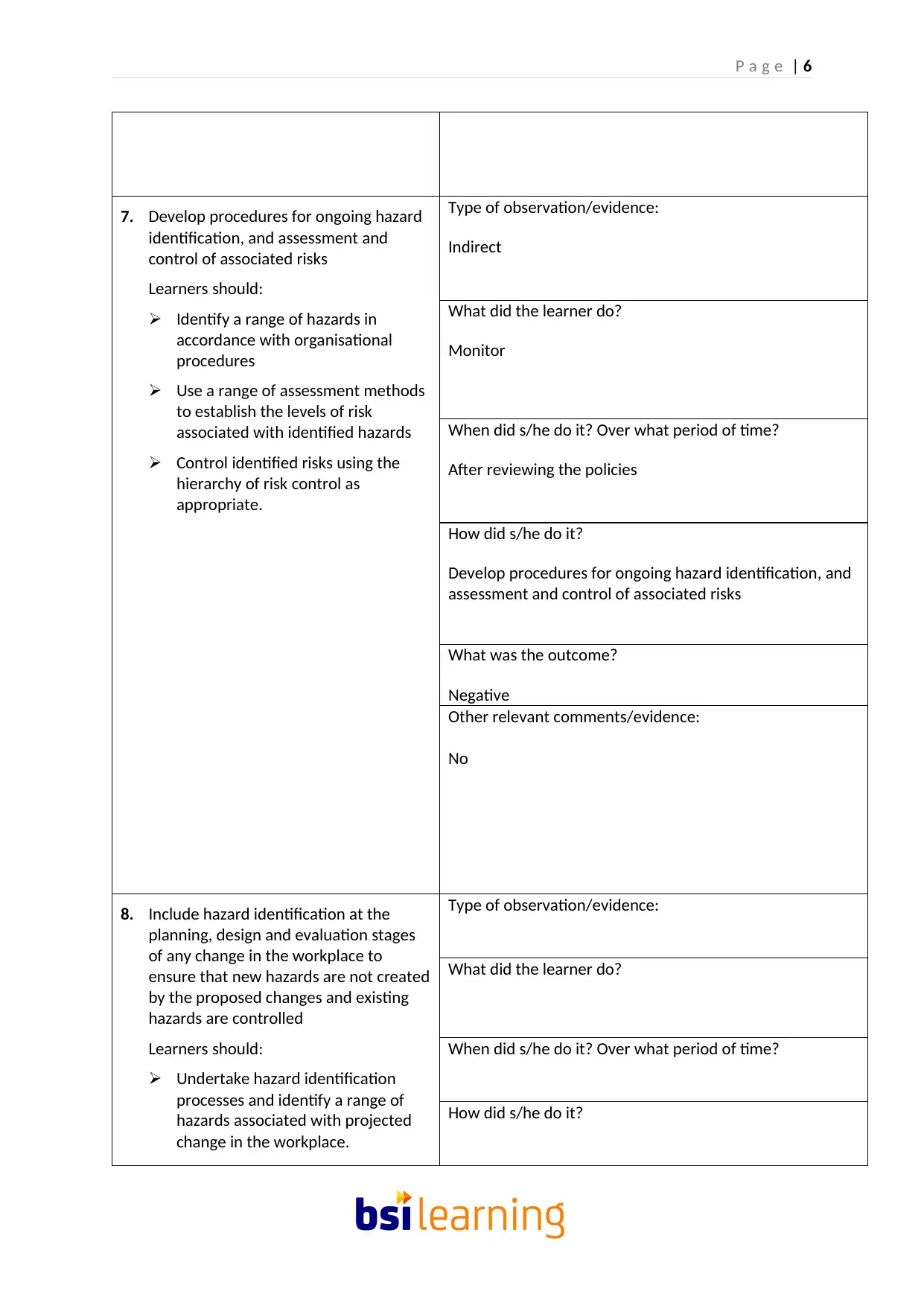
P a g e | 6
7. Develop procedures for ongoing hazard
identification, and assessment and
control of associated risks
Learners should:
Identify a range of hazards in
accordance with organisational
procedures
Use a range of assessment methods
to establish the levels of risk
associated with identified hazards
Control identified risks using the
hierarchy of risk control as
appropriate.
Type of observation/evidence:
Indirect
What did the learner do?
Monitor
When did s/he do it? Over what period of time?
After reviewing the policies
How did s/he do it?
Develop procedures for ongoing hazard identification, and
assessment and control of associated risks
What was the outcome?
Negative
Other relevant comments/evidence:
No
8. Include hazard identification at the
planning, design and evaluation stages
of any change in the workplace to
ensure that new hazards are not created
by the proposed changes and existing
hazards are controlled
Learners should:
Undertake hazard identification
processes and identify a range of
hazards associated with projected
change in the workplace.
Type of observation/evidence:
What did the learner do?
When did s/he do it? Over what period of time?
How did s/he do it?
7. Develop procedures for ongoing hazard
identification, and assessment and
control of associated risks
Learners should:
Identify a range of hazards in
accordance with organisational
procedures
Use a range of assessment methods
to establish the levels of risk
associated with identified hazards
Control identified risks using the
hierarchy of risk control as
appropriate.
Type of observation/evidence:
Indirect
What did the learner do?
Monitor
When did s/he do it? Over what period of time?
After reviewing the policies
How did s/he do it?
Develop procedures for ongoing hazard identification, and
assessment and control of associated risks
What was the outcome?
Negative
Other relevant comments/evidence:
No
8. Include hazard identification at the
planning, design and evaluation stages
of any change in the workplace to
ensure that new hazards are not created
by the proposed changes and existing
hazards are controlled
Learners should:
Undertake hazard identification
processes and identify a range of
hazards associated with projected
change in the workplace.
Type of observation/evidence:
What did the learner do?
When did s/he do it? Over what period of time?
How did s/he do it?
Paraphrase This Document
Need a fresh take? Get an instant paraphrase of this document with our AI Paraphraser
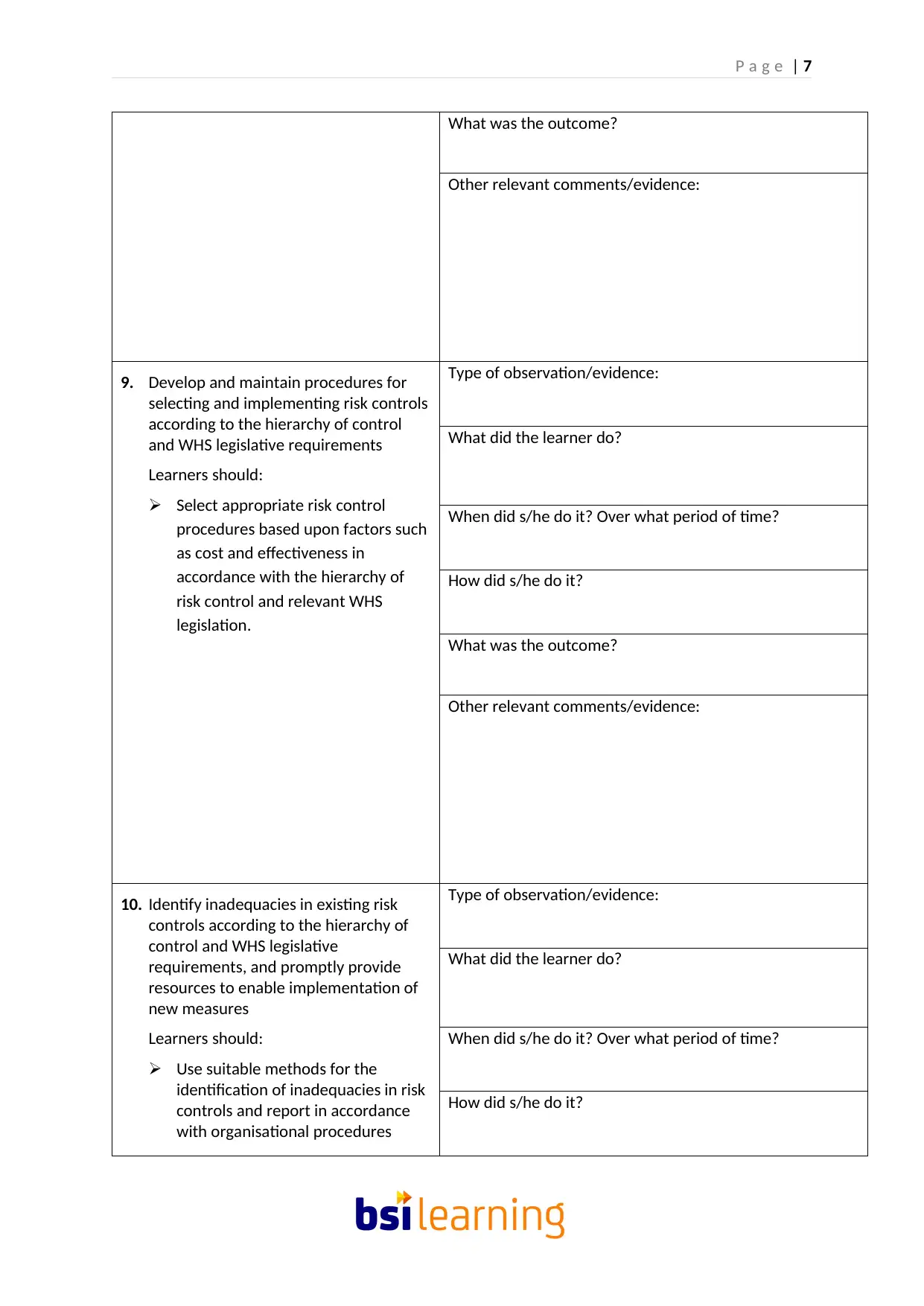
P a g e | 7
What was the outcome?
Other relevant comments/evidence:
9. Develop and maintain procedures for
selecting and implementing risk controls
according to the hierarchy of control
and WHS legislative requirements
Learners should:
Select appropriate risk control
procedures based upon factors such
as cost and effectiveness in
accordance with the hierarchy of
risk control and relevant WHS
legislation.
Type of observation/evidence:
What did the learner do?
When did s/he do it? Over what period of time?
How did s/he do it?
What was the outcome?
Other relevant comments/evidence:
10. Identify inadequacies in existing risk
controls according to the hierarchy of
control and WHS legislative
requirements, and promptly provide
resources to enable implementation of
new measures
Learners should:
Use suitable methods for the
identification of inadequacies in risk
controls and report in accordance
with organisational procedures
Type of observation/evidence:
What did the learner do?
When did s/he do it? Over what period of time?
How did s/he do it?
What was the outcome?
Other relevant comments/evidence:
9. Develop and maintain procedures for
selecting and implementing risk controls
according to the hierarchy of control
and WHS legislative requirements
Learners should:
Select appropriate risk control
procedures based upon factors such
as cost and effectiveness in
accordance with the hierarchy of
risk control and relevant WHS
legislation.
Type of observation/evidence:
What did the learner do?
When did s/he do it? Over what period of time?
How did s/he do it?
What was the outcome?
Other relevant comments/evidence:
10. Identify inadequacies in existing risk
controls according to the hierarchy of
control and WHS legislative
requirements, and promptly provide
resources to enable implementation of
new measures
Learners should:
Use suitable methods for the
identification of inadequacies in risk
controls and report in accordance
with organisational procedures
Type of observation/evidence:
What did the learner do?
When did s/he do it? Over what period of time?
How did s/he do it?
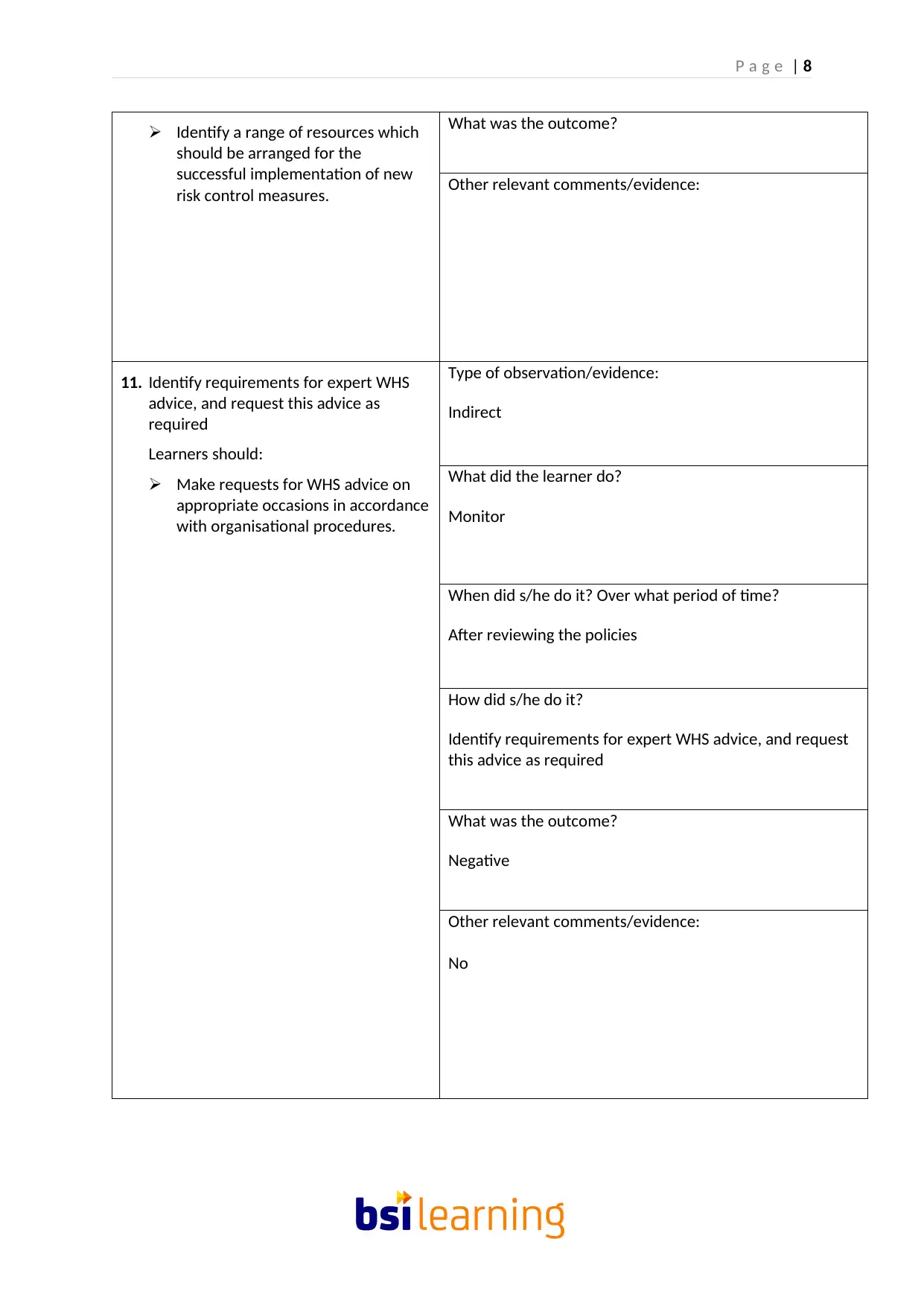
P a g e | 8
Identify a range of resources which
should be arranged for the
successful implementation of new
risk control measures.
What was the outcome?
Other relevant comments/evidence:
11. Identify requirements for expert WHS
advice, and request this advice as
required
Learners should:
Make requests for WHS advice on
appropriate occasions in accordance
with organisational procedures.
Type of observation/evidence:
Indirect
What did the learner do?
Monitor
When did s/he do it? Over what period of time?
After reviewing the policies
How did s/he do it?
Identify requirements for expert WHS advice, and request
this advice as required
What was the outcome?
Negative
Other relevant comments/evidence:
No
Identify a range of resources which
should be arranged for the
successful implementation of new
risk control measures.
What was the outcome?
Other relevant comments/evidence:
11. Identify requirements for expert WHS
advice, and request this advice as
required
Learners should:
Make requests for WHS advice on
appropriate occasions in accordance
with organisational procedures.
Type of observation/evidence:
Indirect
What did the learner do?
Monitor
When did s/he do it? Over what period of time?
After reviewing the policies
How did s/he do it?
Identify requirements for expert WHS advice, and request
this advice as required
What was the outcome?
Negative
Other relevant comments/evidence:
No
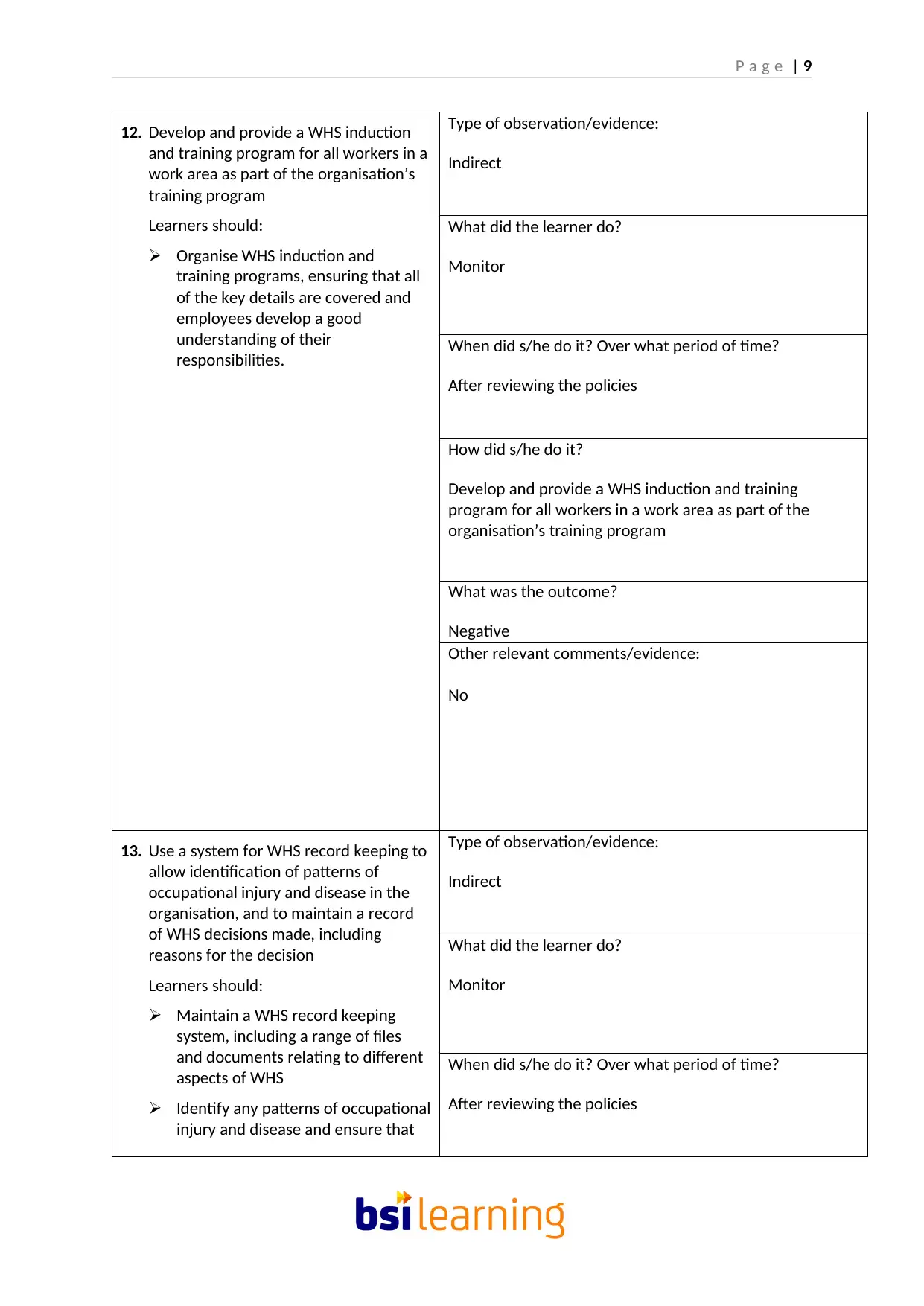
P a g e | 9
12. Develop and provide a WHS induction
and training program for all workers in a
work area as part of the organisation’s
training program
Learners should:
Organise WHS induction and
training programs, ensuring that all
of the key details are covered and
employees develop a good
understanding of their
responsibilities.
Type of observation/evidence:
Indirect
What did the learner do?
Monitor
When did s/he do it? Over what period of time?
After reviewing the policies
How did s/he do it?
Develop and provide a WHS induction and training
program for all workers in a work area as part of the
organisation’s training program
What was the outcome?
Negative
Other relevant comments/evidence:
No
13. Use a system for WHS record keeping to
allow identification of patterns of
occupational injury and disease in the
organisation, and to maintain a record
of WHS decisions made, including
reasons for the decision
Learners should:
Maintain a WHS record keeping
system, including a range of files
and documents relating to different
aspects of WHS
Identify any patterns of occupational
injury and disease and ensure that
Type of observation/evidence:
Indirect
What did the learner do?
Monitor
When did s/he do it? Over what period of time?
After reviewing the policies
12. Develop and provide a WHS induction
and training program for all workers in a
work area as part of the organisation’s
training program
Learners should:
Organise WHS induction and
training programs, ensuring that all
of the key details are covered and
employees develop a good
understanding of their
responsibilities.
Type of observation/evidence:
Indirect
What did the learner do?
Monitor
When did s/he do it? Over what period of time?
After reviewing the policies
How did s/he do it?
Develop and provide a WHS induction and training
program for all workers in a work area as part of the
organisation’s training program
What was the outcome?
Negative
Other relevant comments/evidence:
No
13. Use a system for WHS record keeping to
allow identification of patterns of
occupational injury and disease in the
organisation, and to maintain a record
of WHS decisions made, including
reasons for the decision
Learners should:
Maintain a WHS record keeping
system, including a range of files
and documents relating to different
aspects of WHS
Identify any patterns of occupational
injury and disease and ensure that
Type of observation/evidence:
Indirect
What did the learner do?
Monitor
When did s/he do it? Over what period of time?
After reviewing the policies
Secure Best Marks with AI Grader
Need help grading? Try our AI Grader for instant feedback on your assignments.
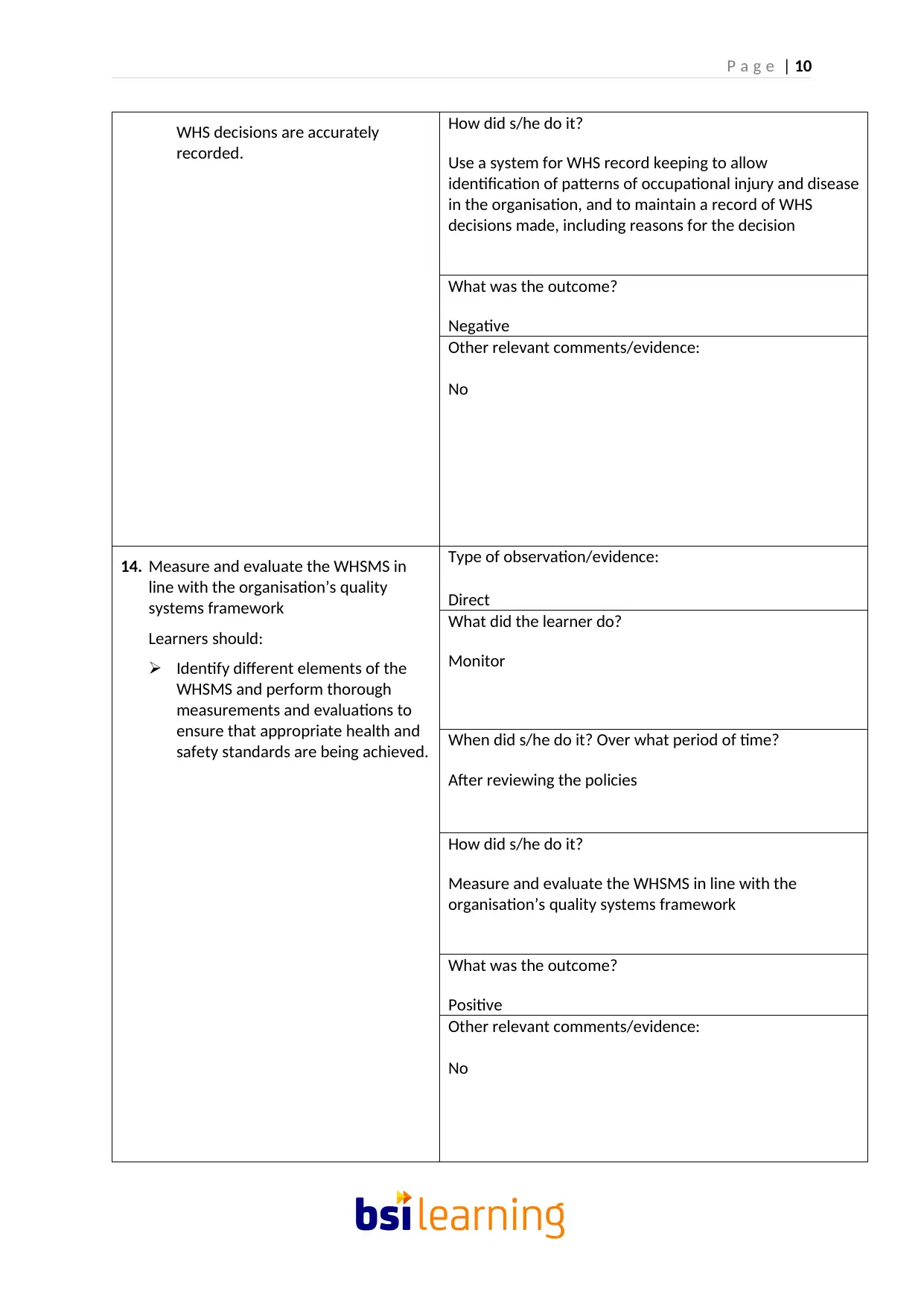
P a g e | 10
WHS decisions are accurately
recorded.
How did s/he do it?
Use a system for WHS record keeping to allow
identification of patterns of occupational injury and disease
in the organisation, and to maintain a record of WHS
decisions made, including reasons for the decision
What was the outcome?
Negative
Other relevant comments/evidence:
No
14. Measure and evaluate the WHSMS in
line with the organisation’s quality
systems framework
Learners should:
Identify different elements of the
WHSMS and perform thorough
measurements and evaluations to
ensure that appropriate health and
safety standards are being achieved.
Type of observation/evidence:
Direct
What did the learner do?
Monitor
When did s/he do it? Over what period of time?
After reviewing the policies
How did s/he do it?
Measure and evaluate the WHSMS in line with the
organisation’s quality systems framework
What was the outcome?
Positive
Other relevant comments/evidence:
No
WHS decisions are accurately
recorded.
How did s/he do it?
Use a system for WHS record keeping to allow
identification of patterns of occupational injury and disease
in the organisation, and to maintain a record of WHS
decisions made, including reasons for the decision
What was the outcome?
Negative
Other relevant comments/evidence:
No
14. Measure and evaluate the WHSMS in
line with the organisation’s quality
systems framework
Learners should:
Identify different elements of the
WHSMS and perform thorough
measurements and evaluations to
ensure that appropriate health and
safety standards are being achieved.
Type of observation/evidence:
Direct
What did the learner do?
Monitor
When did s/he do it? Over what period of time?
After reviewing the policies
How did s/he do it?
Measure and evaluate the WHSMS in line with the
organisation’s quality systems framework
What was the outcome?
Positive
Other relevant comments/evidence:
No
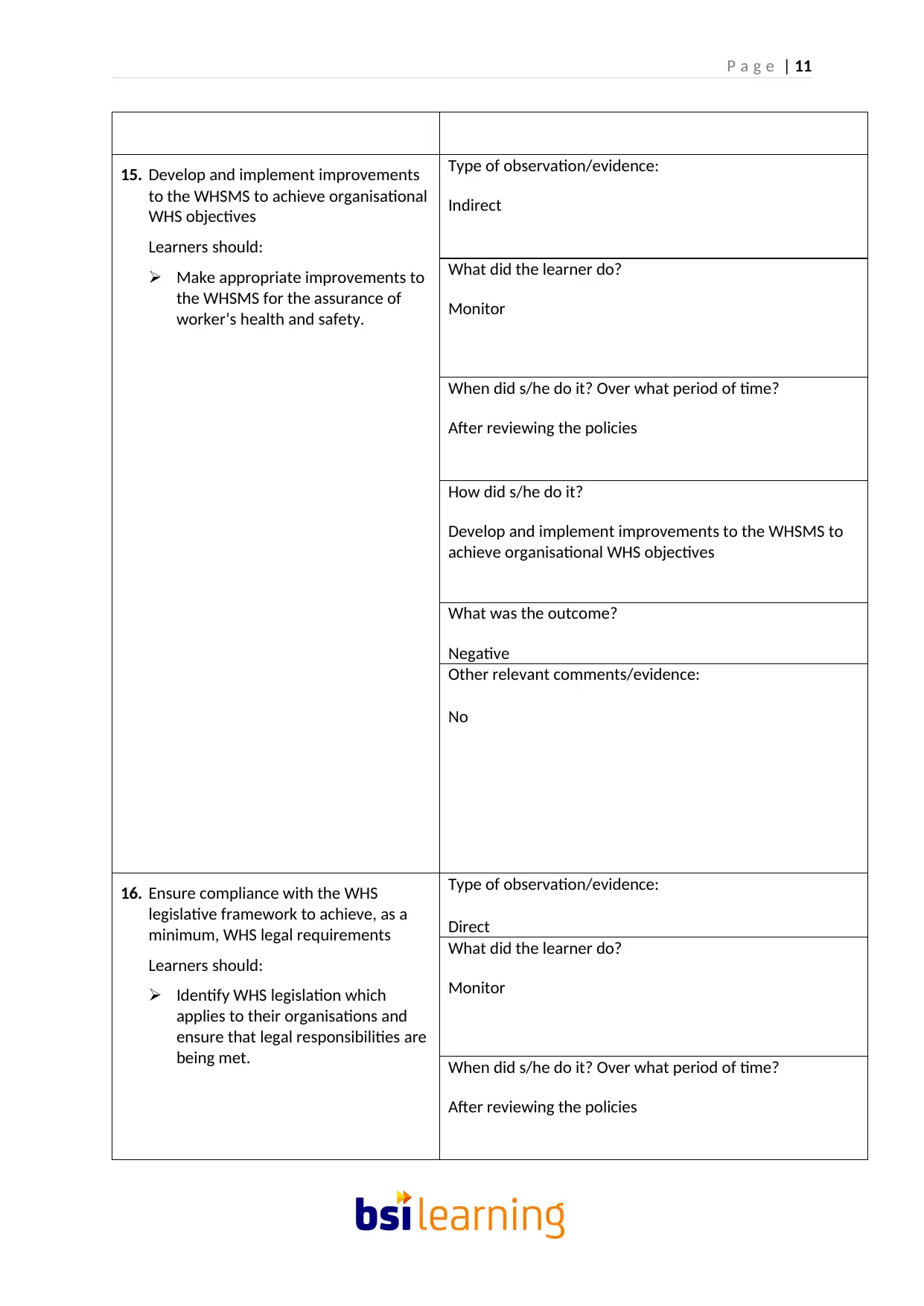
P a g e | 11
15. Develop and implement improvements
to the WHSMS to achieve organisational
WHS objectives
Learners should:
Make appropriate improvements to
the WHSMS for the assurance of
worker’s health and safety.
Type of observation/evidence:
Indirect
What did the learner do?
Monitor
When did s/he do it? Over what period of time?
After reviewing the policies
How did s/he do it?
Develop and implement improvements to the WHSMS to
achieve organisational WHS objectives
What was the outcome?
Negative
Other relevant comments/evidence:
No
16. Ensure compliance with the WHS
legislative framework to achieve, as a
minimum, WHS legal requirements
Learners should:
Identify WHS legislation which
applies to their organisations and
ensure that legal responsibilities are
being met.
Type of observation/evidence:
Direct
What did the learner do?
Monitor
When did s/he do it? Over what period of time?
After reviewing the policies
15. Develop and implement improvements
to the WHSMS to achieve organisational
WHS objectives
Learners should:
Make appropriate improvements to
the WHSMS for the assurance of
worker’s health and safety.
Type of observation/evidence:
Indirect
What did the learner do?
Monitor
When did s/he do it? Over what period of time?
After reviewing the policies
How did s/he do it?
Develop and implement improvements to the WHSMS to
achieve organisational WHS objectives
What was the outcome?
Negative
Other relevant comments/evidence:
No
16. Ensure compliance with the WHS
legislative framework to achieve, as a
minimum, WHS legal requirements
Learners should:
Identify WHS legislation which
applies to their organisations and
ensure that legal responsibilities are
being met.
Type of observation/evidence:
Direct
What did the learner do?
Monitor
When did s/he do it? Over what period of time?
After reviewing the policies
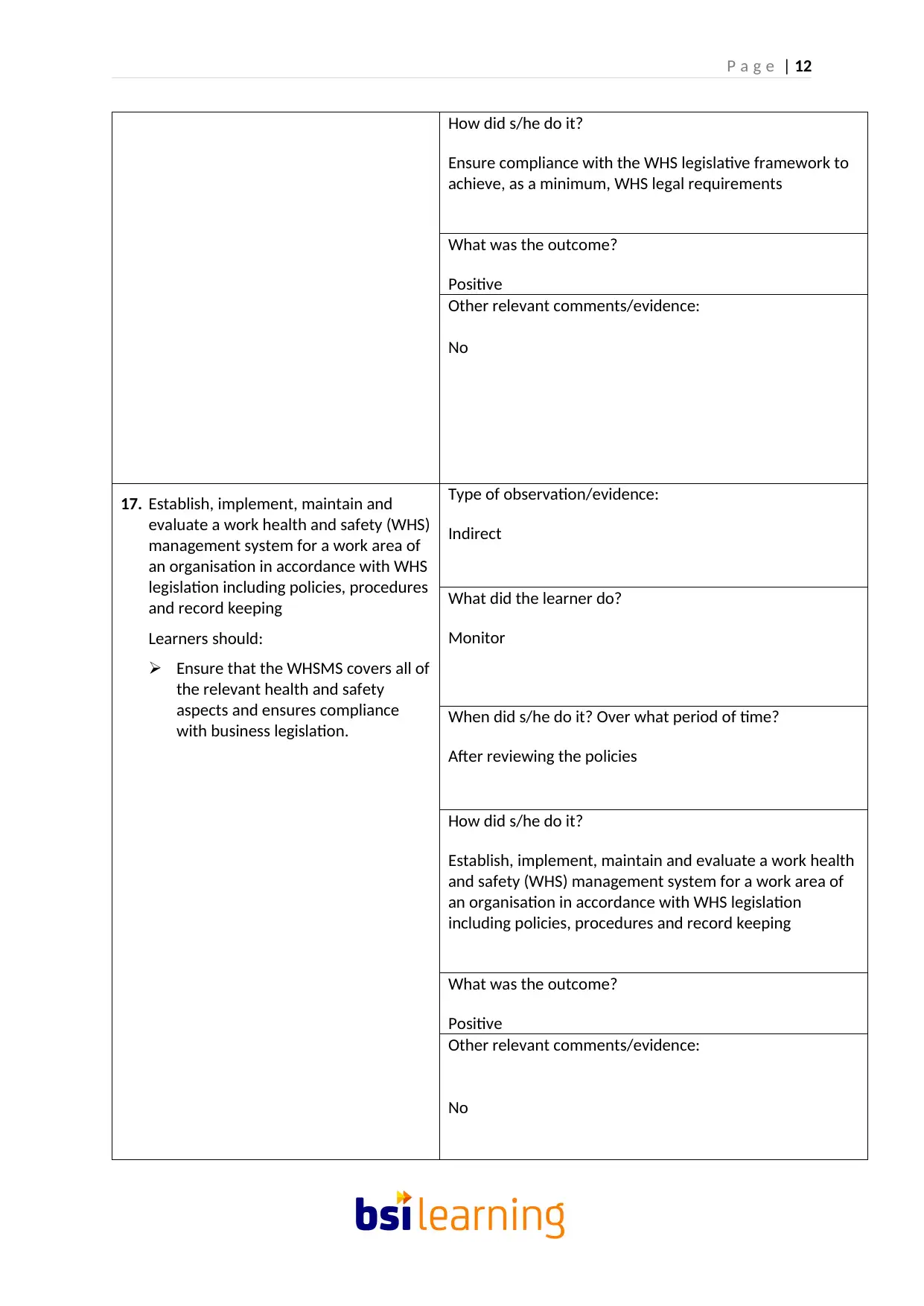
P a g e | 12
How did s/he do it?
Ensure compliance with the WHS legislative framework to
achieve, as a minimum, WHS legal requirements
What was the outcome?
Positive
Other relevant comments/evidence:
No
17. Establish, implement, maintain and
evaluate a work health and safety (WHS)
management system for a work area of
an organisation in accordance with WHS
legislation including policies, procedures
and record keeping
Learners should:
Ensure that the WHSMS covers all of
the relevant health and safety
aspects and ensures compliance
with business legislation.
Type of observation/evidence:
Indirect
What did the learner do?
Monitor
When did s/he do it? Over what period of time?
After reviewing the policies
How did s/he do it?
Establish, implement, maintain and evaluate a work health
and safety (WHS) management system for a work area of
an organisation in accordance with WHS legislation
including policies, procedures and record keeping
What was the outcome?
Positive
Other relevant comments/evidence:
No
How did s/he do it?
Ensure compliance with the WHS legislative framework to
achieve, as a minimum, WHS legal requirements
What was the outcome?
Positive
Other relevant comments/evidence:
No
17. Establish, implement, maintain and
evaluate a work health and safety (WHS)
management system for a work area of
an organisation in accordance with WHS
legislation including policies, procedures
and record keeping
Learners should:
Ensure that the WHSMS covers all of
the relevant health and safety
aspects and ensures compliance
with business legislation.
Type of observation/evidence:
Indirect
What did the learner do?
Monitor
When did s/he do it? Over what period of time?
After reviewing the policies
How did s/he do it?
Establish, implement, maintain and evaluate a work health
and safety (WHS) management system for a work area of
an organisation in accordance with WHS legislation
including policies, procedures and record keeping
What was the outcome?
Positive
Other relevant comments/evidence:
No
Paraphrase This Document
Need a fresh take? Get an instant paraphrase of this document with our AI Paraphraser
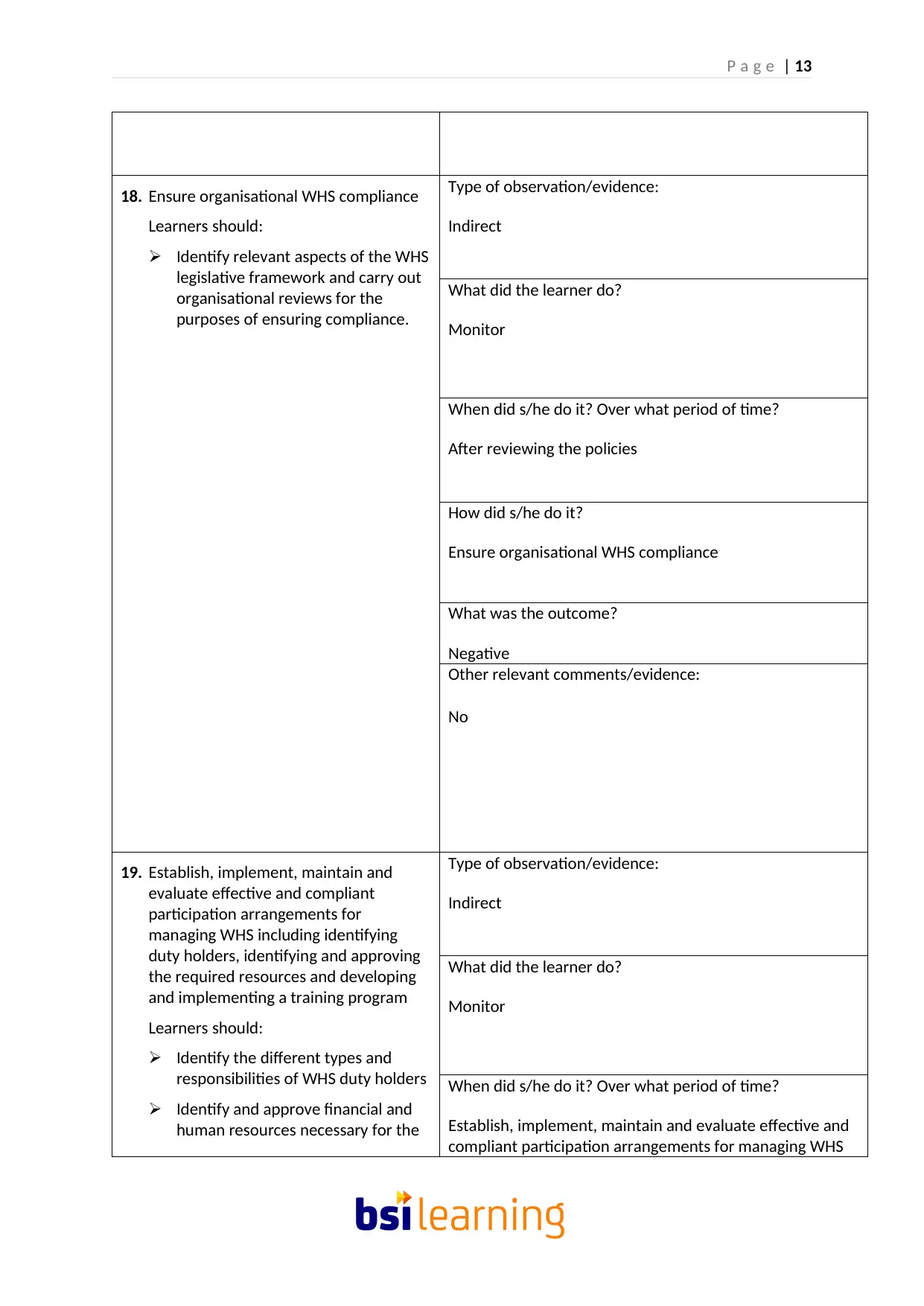
P a g e | 13
18. Ensure organisational WHS compliance
Learners should:
Identify relevant aspects of the WHS
legislative framework and carry out
organisational reviews for the
purposes of ensuring compliance.
Type of observation/evidence:
Indirect
What did the learner do?
Monitor
When did s/he do it? Over what period of time?
After reviewing the policies
How did s/he do it?
Ensure organisational WHS compliance
What was the outcome?
Negative
Other relevant comments/evidence:
No
19. Establish, implement, maintain and
evaluate effective and compliant
participation arrangements for
managing WHS including identifying
duty holders, identifying and approving
the required resources and developing
and implementing a training program
Learners should:
Identify the different types and
responsibilities of WHS duty holders
Identify and approve financial and
human resources necessary for the
Type of observation/evidence:
Indirect
What did the learner do?
Monitor
When did s/he do it? Over what period of time?
Establish, implement, maintain and evaluate effective and
compliant participation arrangements for managing WHS
18. Ensure organisational WHS compliance
Learners should:
Identify relevant aspects of the WHS
legislative framework and carry out
organisational reviews for the
purposes of ensuring compliance.
Type of observation/evidence:
Indirect
What did the learner do?
Monitor
When did s/he do it? Over what period of time?
After reviewing the policies
How did s/he do it?
Ensure organisational WHS compliance
What was the outcome?
Negative
Other relevant comments/evidence:
No
19. Establish, implement, maintain and
evaluate effective and compliant
participation arrangements for
managing WHS including identifying
duty holders, identifying and approving
the required resources and developing
and implementing a training program
Learners should:
Identify the different types and
responsibilities of WHS duty holders
Identify and approve financial and
human resources necessary for the
Type of observation/evidence:
Indirect
What did the learner do?
Monitor
When did s/he do it? Over what period of time?
Establish, implement, maintain and evaluate effective and
compliant participation arrangements for managing WHS
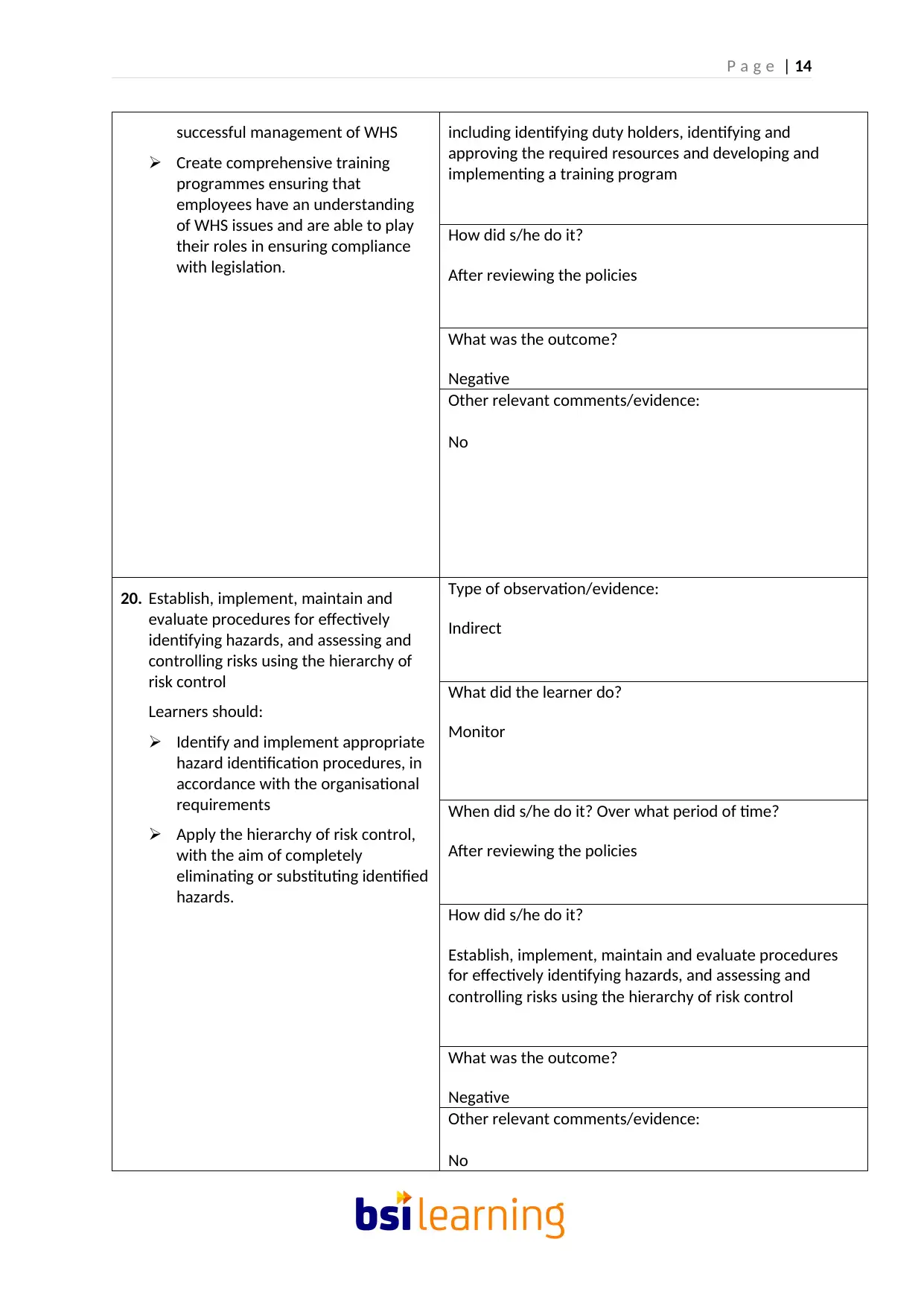
P a g e | 14
successful management of WHS
Create comprehensive training
programmes ensuring that
employees have an understanding
of WHS issues and are able to play
their roles in ensuring compliance
with legislation.
including identifying duty holders, identifying and
approving the required resources and developing and
implementing a training program
How did s/he do it?
After reviewing the policies
What was the outcome?
Negative
Other relevant comments/evidence:
No
20. Establish, implement, maintain and
evaluate procedures for effectively
identifying hazards, and assessing and
controlling risks using the hierarchy of
risk control
Learners should:
Identify and implement appropriate
hazard identification procedures, in
accordance with the organisational
requirements
Apply the hierarchy of risk control,
with the aim of completely
eliminating or substituting identified
hazards.
Type of observation/evidence:
Indirect
What did the learner do?
Monitor
When did s/he do it? Over what period of time?
After reviewing the policies
How did s/he do it?
Establish, implement, maintain and evaluate procedures
for effectively identifying hazards, and assessing and
controlling risks using the hierarchy of risk control
What was the outcome?
Negative
Other relevant comments/evidence:
No
successful management of WHS
Create comprehensive training
programmes ensuring that
employees have an understanding
of WHS issues and are able to play
their roles in ensuring compliance
with legislation.
including identifying duty holders, identifying and
approving the required resources and developing and
implementing a training program
How did s/he do it?
After reviewing the policies
What was the outcome?
Negative
Other relevant comments/evidence:
No
20. Establish, implement, maintain and
evaluate procedures for effectively
identifying hazards, and assessing and
controlling risks using the hierarchy of
risk control
Learners should:
Identify and implement appropriate
hazard identification procedures, in
accordance with the organisational
requirements
Apply the hierarchy of risk control,
with the aim of completely
eliminating or substituting identified
hazards.
Type of observation/evidence:
Indirect
What did the learner do?
Monitor
When did s/he do it? Over what period of time?
After reviewing the policies
How did s/he do it?
Establish, implement, maintain and evaluate procedures
for effectively identifying hazards, and assessing and
controlling risks using the hierarchy of risk control
What was the outcome?
Negative
Other relevant comments/evidence:
No
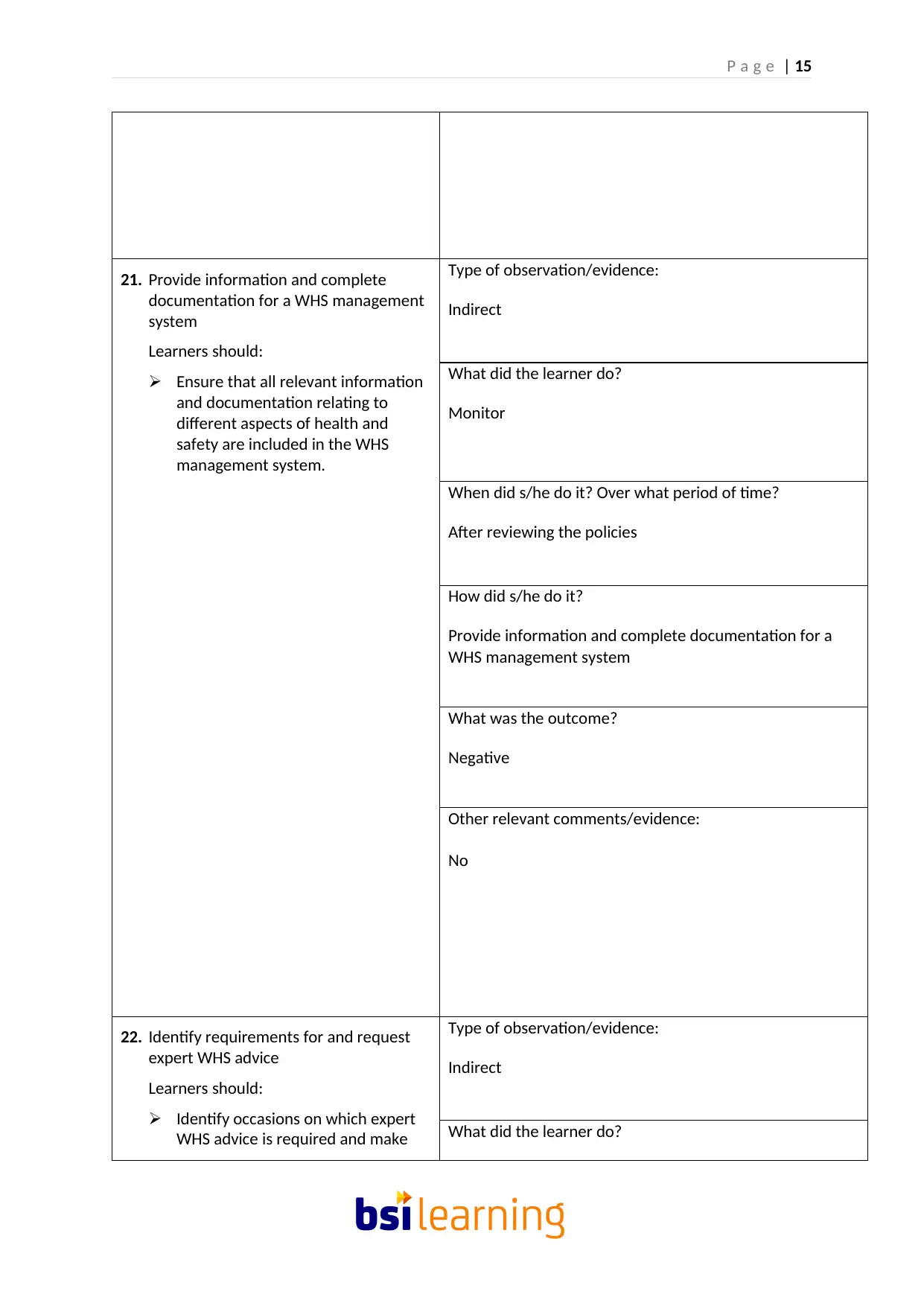
P a g e | 15
21. Provide information and complete
documentation for a WHS management
system
Learners should:
Ensure that all relevant information
and documentation relating to
different aspects of health and
safety are included in the WHS
management system.
Type of observation/evidence:
Indirect
What did the learner do?
Monitor
When did s/he do it? Over what period of time?
After reviewing the policies
How did s/he do it?
Provide information and complete documentation for a
WHS management system
What was the outcome?
Negative
Other relevant comments/evidence:
No
22. Identify requirements for and request
expert WHS advice
Learners should:
Identify occasions on which expert
WHS advice is required and make
Type of observation/evidence:
Indirect
What did the learner do?
21. Provide information and complete
documentation for a WHS management
system
Learners should:
Ensure that all relevant information
and documentation relating to
different aspects of health and
safety are included in the WHS
management system.
Type of observation/evidence:
Indirect
What did the learner do?
Monitor
When did s/he do it? Over what period of time?
After reviewing the policies
How did s/he do it?
Provide information and complete documentation for a
WHS management system
What was the outcome?
Negative
Other relevant comments/evidence:
No
22. Identify requirements for and request
expert WHS advice
Learners should:
Identify occasions on which expert
WHS advice is required and make
Type of observation/evidence:
Indirect
What did the learner do?
Secure Best Marks with AI Grader
Need help grading? Try our AI Grader for instant feedback on your assignments.
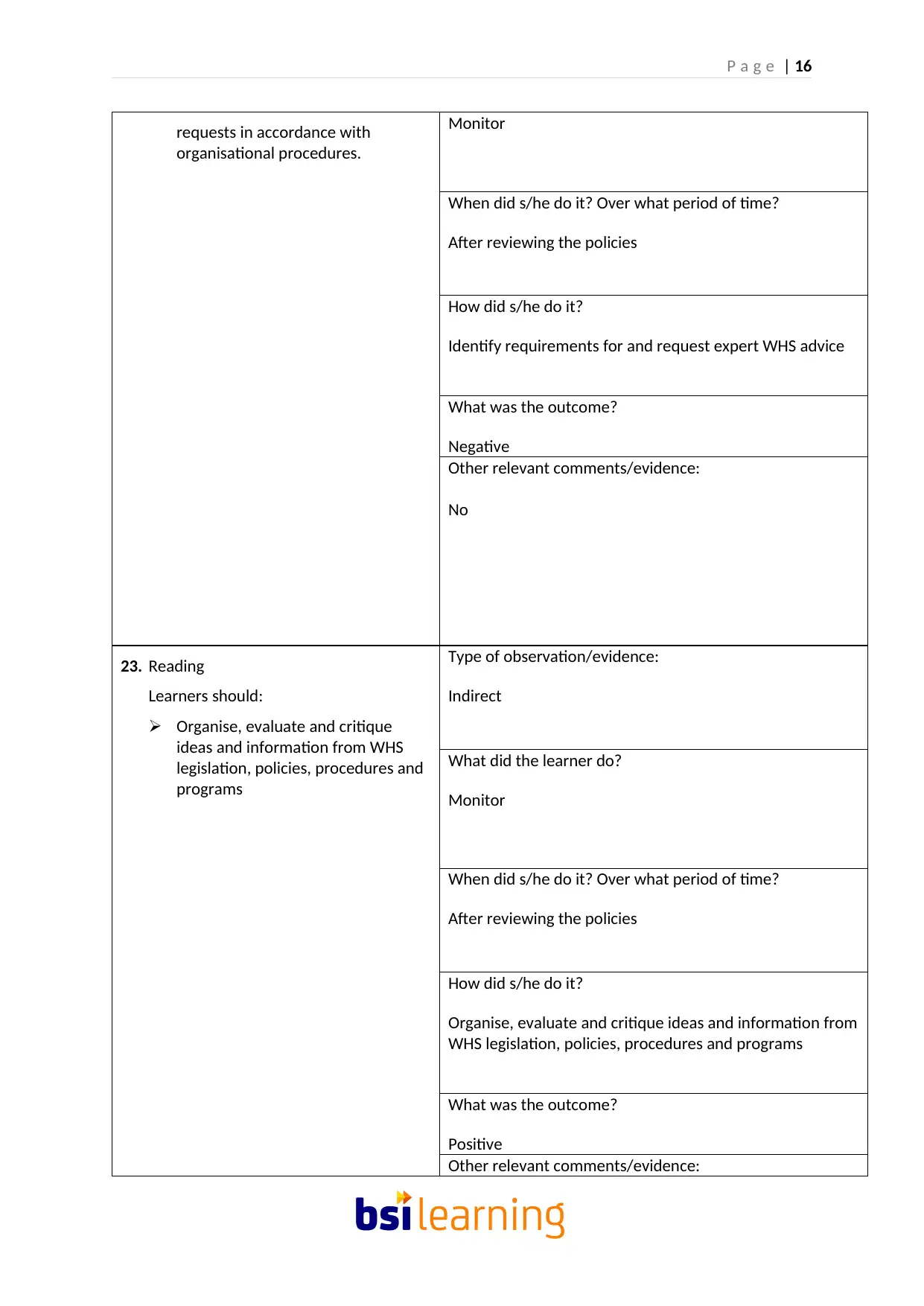
P a g e | 16
requests in accordance with
organisational procedures.
Monitor
When did s/he do it? Over what period of time?
After reviewing the policies
How did s/he do it?
Identify requirements for and request expert WHS advice
What was the outcome?
Negative
Other relevant comments/evidence:
No
23. Reading
Learners should:
Organise, evaluate and critique
ideas and information from WHS
legislation, policies, procedures and
programs
Type of observation/evidence:
Indirect
What did the learner do?
Monitor
When did s/he do it? Over what period of time?
After reviewing the policies
How did s/he do it?
Organise, evaluate and critique ideas and information from
WHS legislation, policies, procedures and programs
What was the outcome?
Positive
Other relevant comments/evidence:
requests in accordance with
organisational procedures.
Monitor
When did s/he do it? Over what period of time?
After reviewing the policies
How did s/he do it?
Identify requirements for and request expert WHS advice
What was the outcome?
Negative
Other relevant comments/evidence:
No
23. Reading
Learners should:
Organise, evaluate and critique
ideas and information from WHS
legislation, policies, procedures and
programs
Type of observation/evidence:
Indirect
What did the learner do?
Monitor
When did s/he do it? Over what period of time?
After reviewing the policies
How did s/he do it?
Organise, evaluate and critique ideas and information from
WHS legislation, policies, procedures and programs
What was the outcome?
Positive
Other relevant comments/evidence:
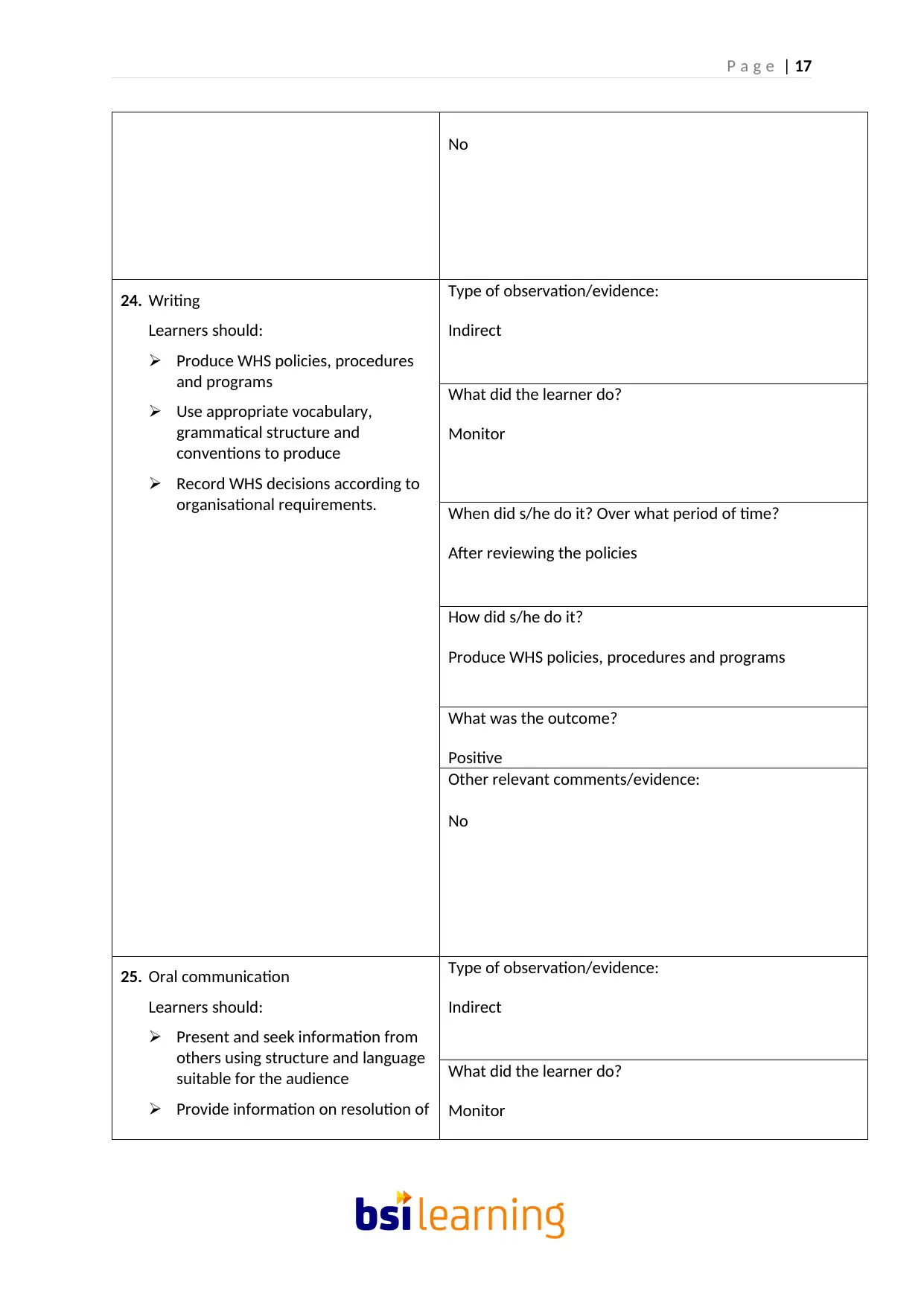
P a g e | 17
No
24. Writing
Learners should:
Produce WHS policies, procedures
and programs
Use appropriate vocabulary,
grammatical structure and
conventions to produce
Record WHS decisions according to
organisational requirements.
Type of observation/evidence:
Indirect
What did the learner do?
Monitor
When did s/he do it? Over what period of time?
After reviewing the policies
How did s/he do it?
Produce WHS policies, procedures and programs
What was the outcome?
Positive
Other relevant comments/evidence:
No
25. Oral communication
Learners should:
Present and seek information from
others using structure and language
suitable for the audience
Provide information on resolution of
Type of observation/evidence:
Indirect
What did the learner do?
Monitor
No
24. Writing
Learners should:
Produce WHS policies, procedures
and programs
Use appropriate vocabulary,
grammatical structure and
conventions to produce
Record WHS decisions according to
organisational requirements.
Type of observation/evidence:
Indirect
What did the learner do?
Monitor
When did s/he do it? Over what period of time?
After reviewing the policies
How did s/he do it?
Produce WHS policies, procedures and programs
What was the outcome?
Positive
Other relevant comments/evidence:
No
25. Oral communication
Learners should:
Present and seek information from
others using structure and language
suitable for the audience
Provide information on resolution of
Type of observation/evidence:
Indirect
What did the learner do?
Monitor
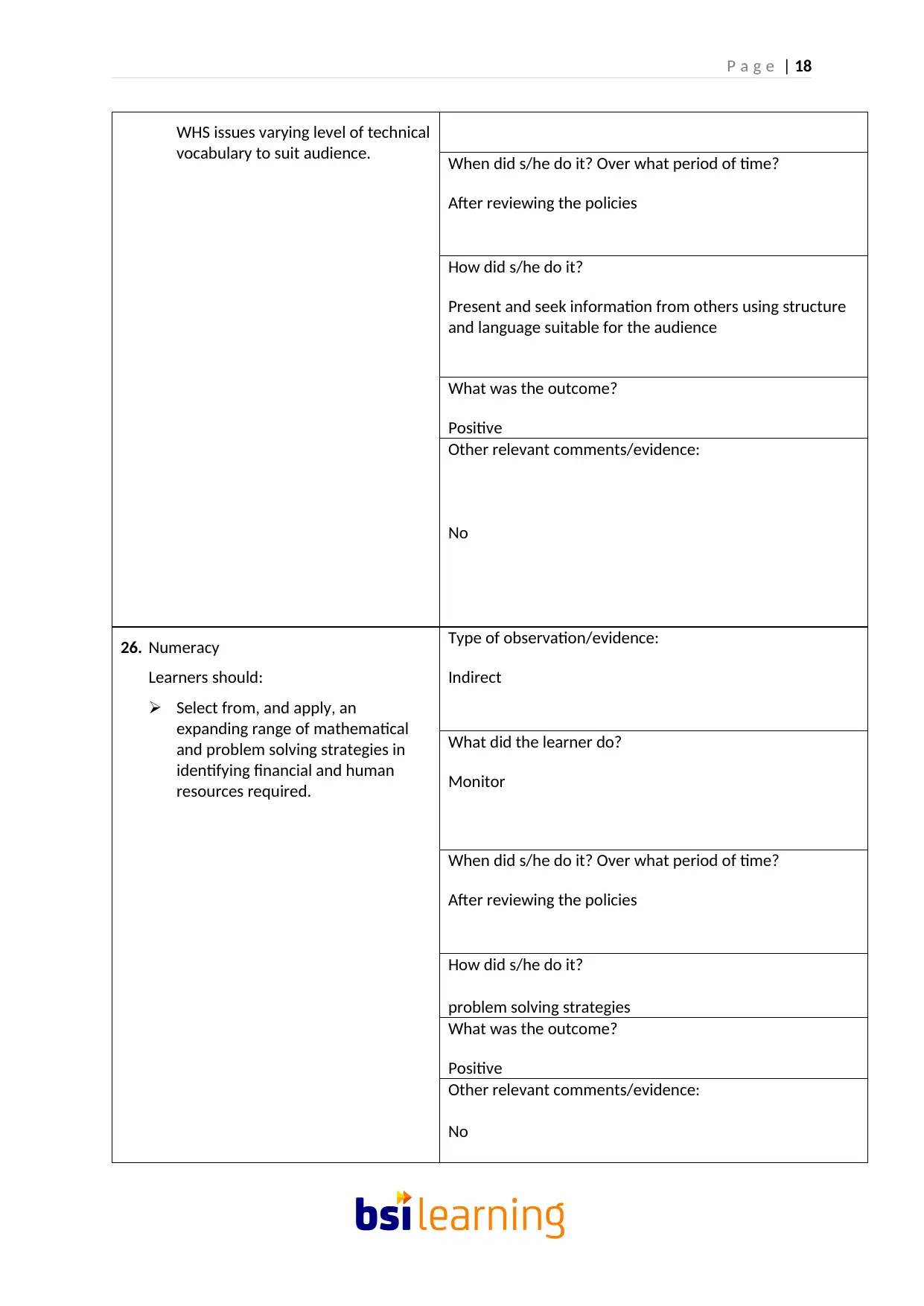
P a g e | 18
WHS issues varying level of technical
vocabulary to suit audience. When did s/he do it? Over what period of time?
After reviewing the policies
How did s/he do it?
Present and seek information from others using structure
and language suitable for the audience
What was the outcome?
Positive
Other relevant comments/evidence:
No
26. Numeracy
Learners should:
Select from, and apply, an
expanding range of mathematical
and problem solving strategies in
identifying financial and human
resources required.
Type of observation/evidence:
Indirect
What did the learner do?
Monitor
When did s/he do it? Over what period of time?
After reviewing the policies
How did s/he do it?
problem solving strategies
What was the outcome?
Positive
Other relevant comments/evidence:
No
WHS issues varying level of technical
vocabulary to suit audience. When did s/he do it? Over what period of time?
After reviewing the policies
How did s/he do it?
Present and seek information from others using structure
and language suitable for the audience
What was the outcome?
Positive
Other relevant comments/evidence:
No
26. Numeracy
Learners should:
Select from, and apply, an
expanding range of mathematical
and problem solving strategies in
identifying financial and human
resources required.
Type of observation/evidence:
Indirect
What did the learner do?
Monitor
When did s/he do it? Over what period of time?
After reviewing the policies
How did s/he do it?
problem solving strategies
What was the outcome?
Positive
Other relevant comments/evidence:
No
Paraphrase This Document
Need a fresh take? Get an instant paraphrase of this document with our AI Paraphraser
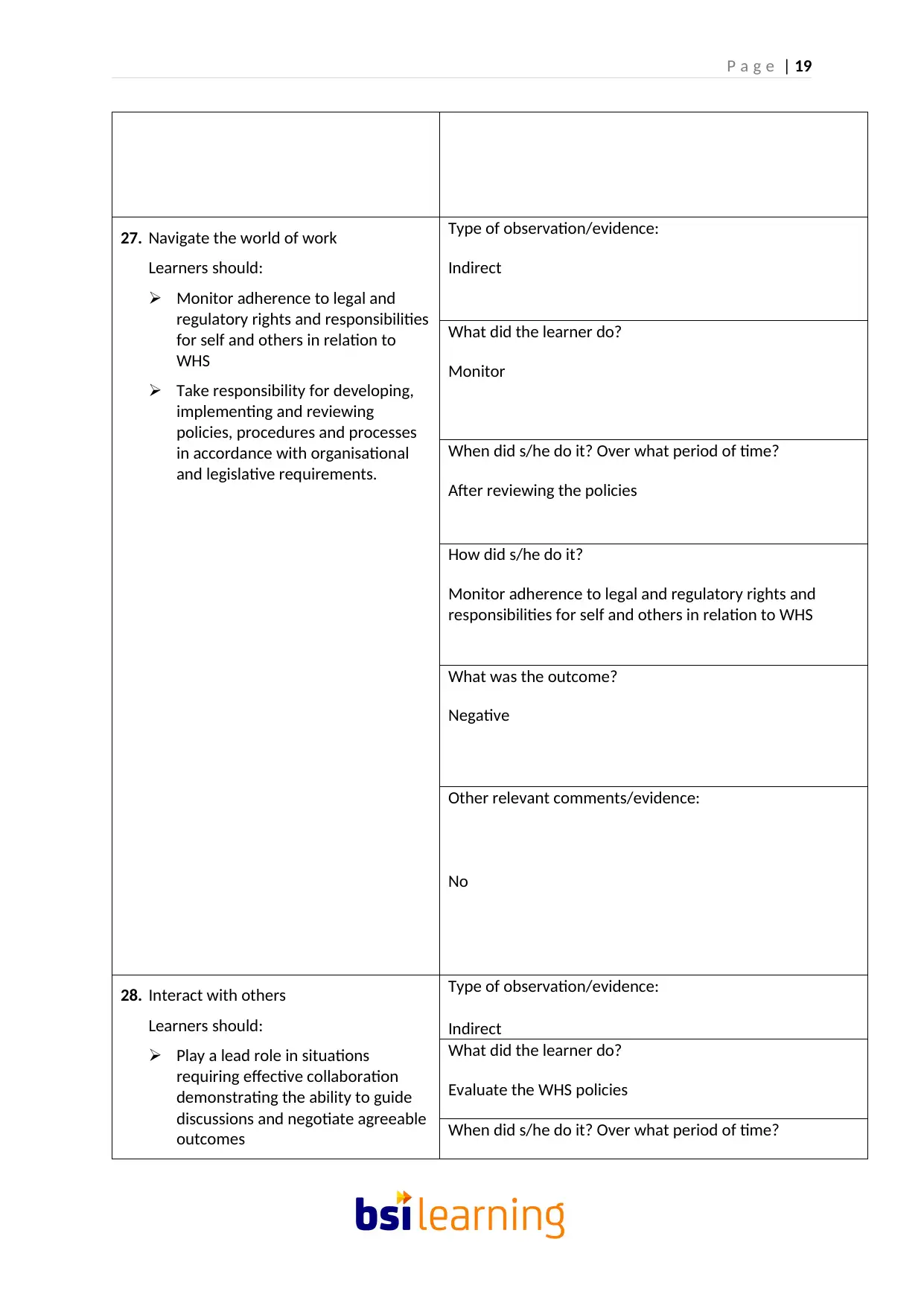
P a g e | 19
27. Navigate the world of work
Learners should:
Monitor adherence to legal and
regulatory rights and responsibilities
for self and others in relation to
WHS
Take responsibility for developing,
implementing and reviewing
policies, procedures and processes
in accordance with organisational
and legislative requirements.
Type of observation/evidence:
Indirect
What did the learner do?
Monitor
When did s/he do it? Over what period of time?
After reviewing the policies
How did s/he do it?
Monitor adherence to legal and regulatory rights and
responsibilities for self and others in relation to WHS
What was the outcome?
Negative
Other relevant comments/evidence:
No
28. Interact with others
Learners should:
Play a lead role in situations
requiring effective collaboration
demonstrating the ability to guide
discussions and negotiate agreeable
outcomes
Type of observation/evidence:
Indirect
What did the learner do?
Evaluate the WHS policies
When did s/he do it? Over what period of time?
27. Navigate the world of work
Learners should:
Monitor adherence to legal and
regulatory rights and responsibilities
for self and others in relation to
WHS
Take responsibility for developing,
implementing and reviewing
policies, procedures and processes
in accordance with organisational
and legislative requirements.
Type of observation/evidence:
Indirect
What did the learner do?
Monitor
When did s/he do it? Over what period of time?
After reviewing the policies
How did s/he do it?
Monitor adherence to legal and regulatory rights and
responsibilities for self and others in relation to WHS
What was the outcome?
Negative
Other relevant comments/evidence:
No
28. Interact with others
Learners should:
Play a lead role in situations
requiring effective collaboration
demonstrating the ability to guide
discussions and negotiate agreeable
outcomes
Type of observation/evidence:
Indirect
What did the learner do?
Evaluate the WHS policies
When did s/he do it? Over what period of time?
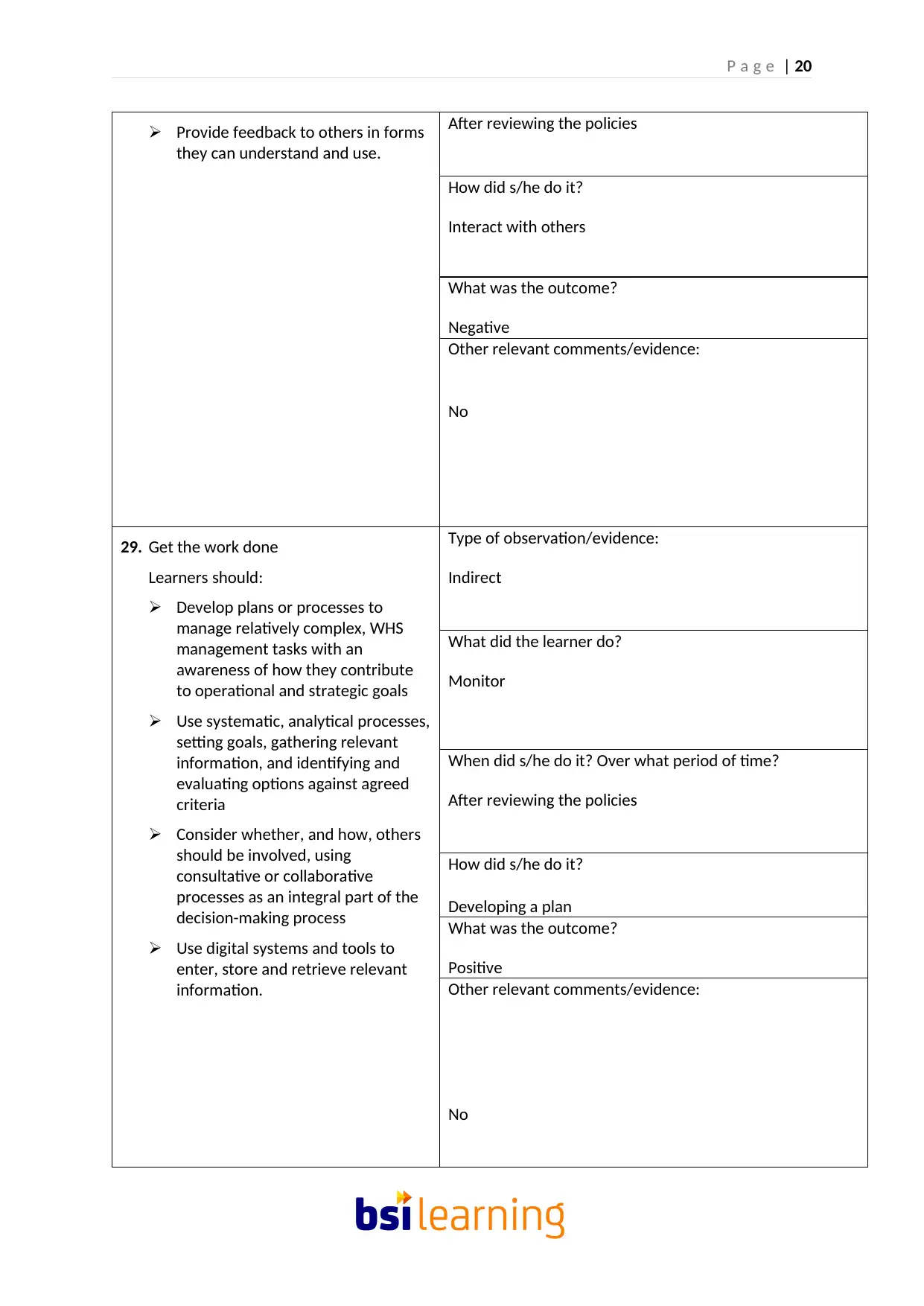
P a g e | 20
Provide feedback to others in forms
they can understand and use.
After reviewing the policies
How did s/he do it?
Interact with others
What was the outcome?
Negative
Other relevant comments/evidence:
No
29. Get the work done
Learners should:
Develop plans or processes to
manage relatively complex, WHS
management tasks with an
awareness of how they contribute
to operational and strategic goals
Use systematic, analytical processes,
setting goals, gathering relevant
information, and identifying and
evaluating options against agreed
criteria
Consider whether, and how, others
should be involved, using
consultative or collaborative
processes as an integral part of the
decision-making process
Use digital systems and tools to
enter, store and retrieve relevant
information.
Type of observation/evidence:
Indirect
What did the learner do?
Monitor
When did s/he do it? Over what period of time?
After reviewing the policies
How did s/he do it?
Developing a plan
What was the outcome?
Positive
Other relevant comments/evidence:
No
Provide feedback to others in forms
they can understand and use.
After reviewing the policies
How did s/he do it?
Interact with others
What was the outcome?
Negative
Other relevant comments/evidence:
No
29. Get the work done
Learners should:
Develop plans or processes to
manage relatively complex, WHS
management tasks with an
awareness of how they contribute
to operational and strategic goals
Use systematic, analytical processes,
setting goals, gathering relevant
information, and identifying and
evaluating options against agreed
criteria
Consider whether, and how, others
should be involved, using
consultative or collaborative
processes as an integral part of the
decision-making process
Use digital systems and tools to
enter, store and retrieve relevant
information.
Type of observation/evidence:
Indirect
What did the learner do?
Monitor
When did s/he do it? Over what period of time?
After reviewing the policies
How did s/he do it?
Developing a plan
What was the outcome?
Positive
Other relevant comments/evidence:
No
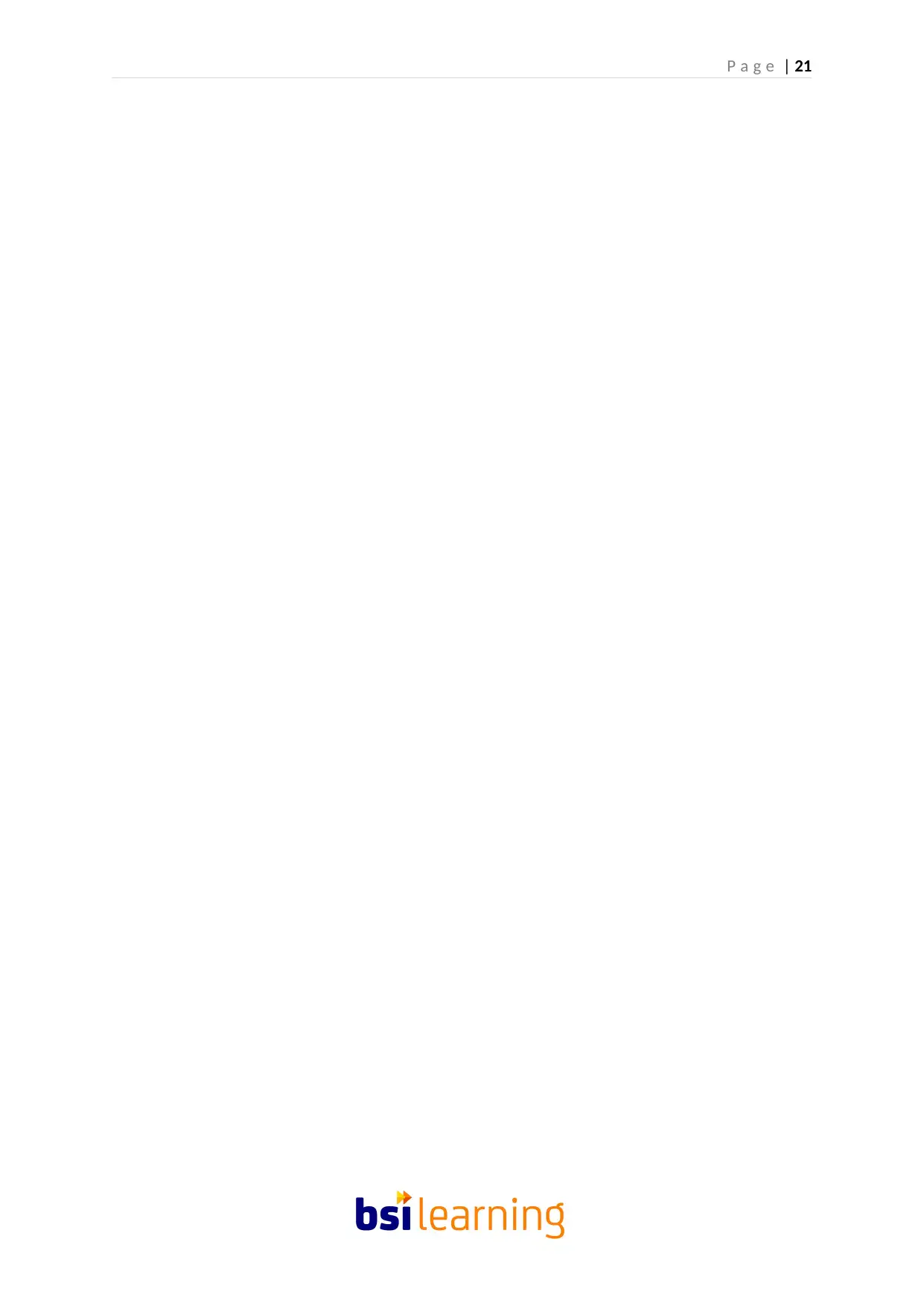
P a g e | 21
Secure Best Marks with AI Grader
Need help grading? Try our AI Grader for instant feedback on your assignments.
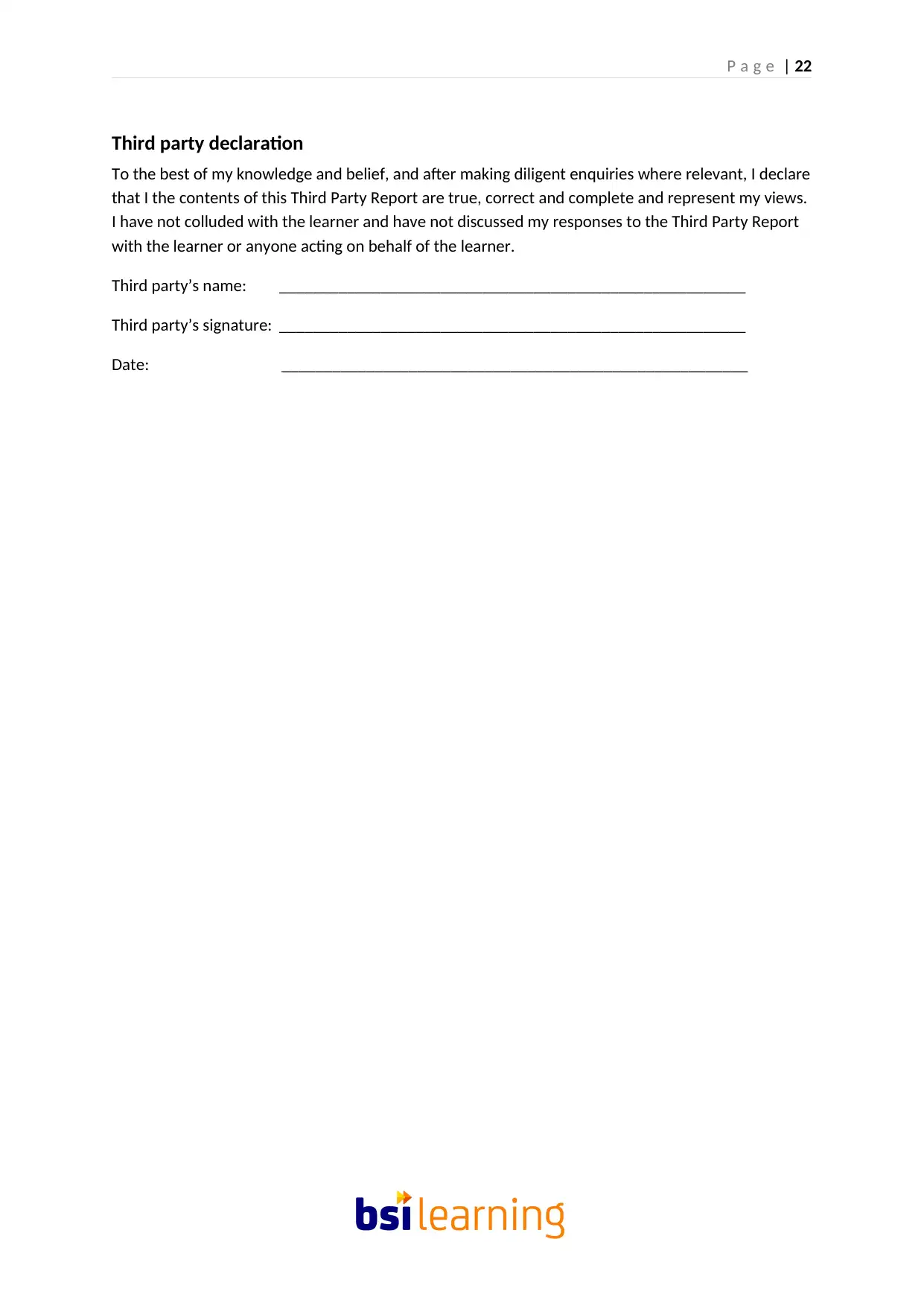
P a g e | 22
Third party declaration
To the best of my knowledge and belief, and after making diligent enquiries where relevant, I declare
that I the contents of this Third Party Report are true, correct and complete and represent my views.
I have not colluded with the learner and have not discussed my responses to the Third Party Report
with the learner or anyone acting on behalf of the learner.
Third party’s name: _______________________________________________________
Third party’s signature: _______________________________________________________
Date: _______________________________________________________
Third party declaration
To the best of my knowledge and belief, and after making diligent enquiries where relevant, I declare
that I the contents of this Third Party Report are true, correct and complete and represent my views.
I have not colluded with the learner and have not discussed my responses to the Third Party Report
with the learner or anyone acting on behalf of the learner.
Third party’s name: _______________________________________________________
Third party’s signature: _______________________________________________________
Date: _______________________________________________________
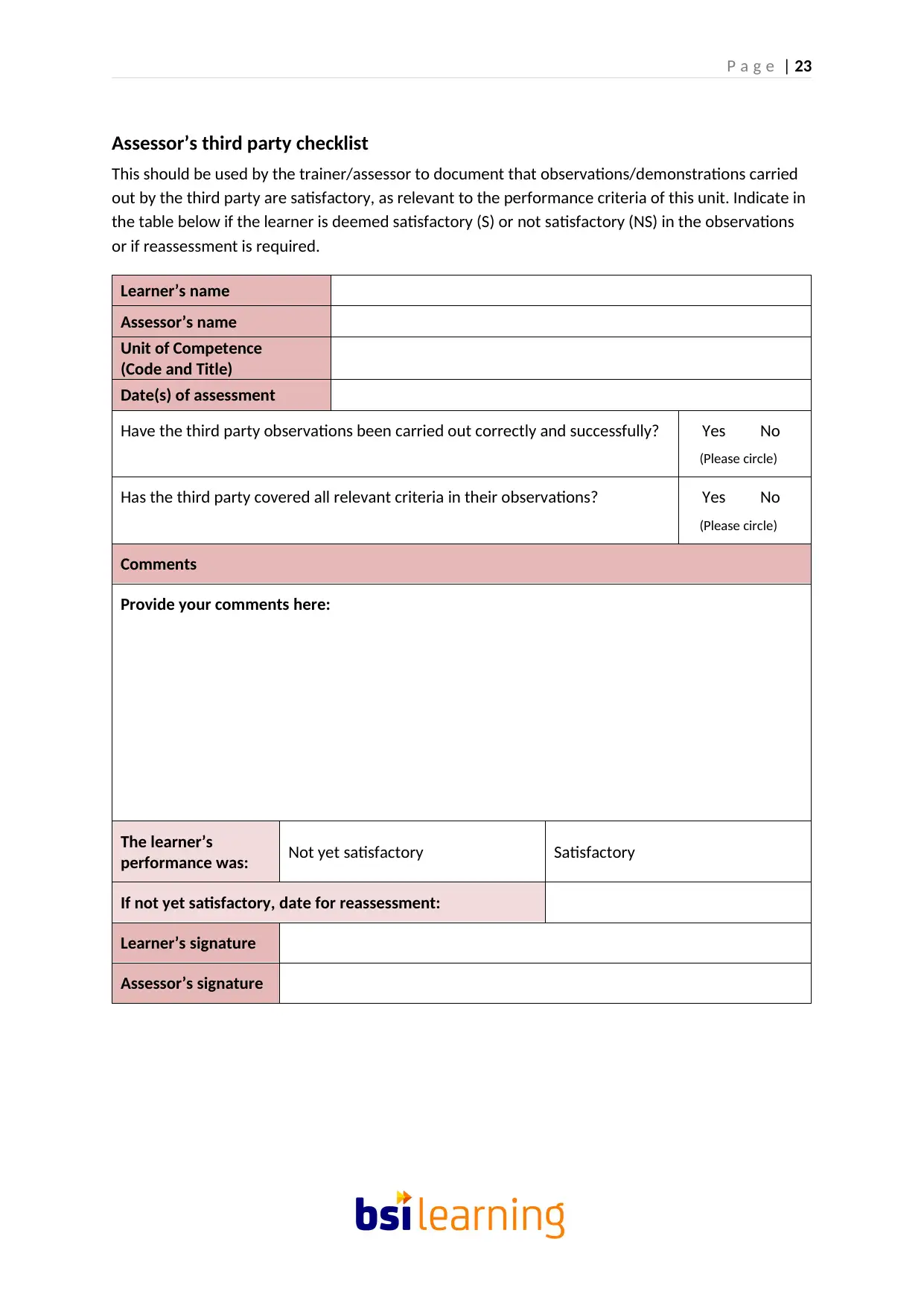
P a g e | 23
Assessor’s third party checklist
This should be used by the trainer/assessor to document that observations/demonstrations carried
out by the third party are satisfactory, as relevant to the performance criteria of this unit. Indicate in
the table below if the learner is deemed satisfactory (S) or not satisfactory (NS) in the observations
or if reassessment is required.
Learner’s name
Assessor’s name
Unit of Competence
(Code and Title)
Date(s) of assessment
Have the third party observations been carried out correctly and successfully? Yes No
(Please circle)
Has the third party covered all relevant criteria in their observations? Yes No
(Please circle)
Comments
Provide your comments here:
The learner’s
performance was: Not yet satisfactory Satisfactory
If not yet satisfactory, date for reassessment:
Learner’s signature
Assessor’s signature
Assessor’s third party checklist
This should be used by the trainer/assessor to document that observations/demonstrations carried
out by the third party are satisfactory, as relevant to the performance criteria of this unit. Indicate in
the table below if the learner is deemed satisfactory (S) or not satisfactory (NS) in the observations
or if reassessment is required.
Learner’s name
Assessor’s name
Unit of Competence
(Code and Title)
Date(s) of assessment
Have the third party observations been carried out correctly and successfully? Yes No
(Please circle)
Has the third party covered all relevant criteria in their observations? Yes No
(Please circle)
Comments
Provide your comments here:
The learner’s
performance was: Not yet satisfactory Satisfactory
If not yet satisfactory, date for reassessment:
Learner’s signature
Assessor’s signature
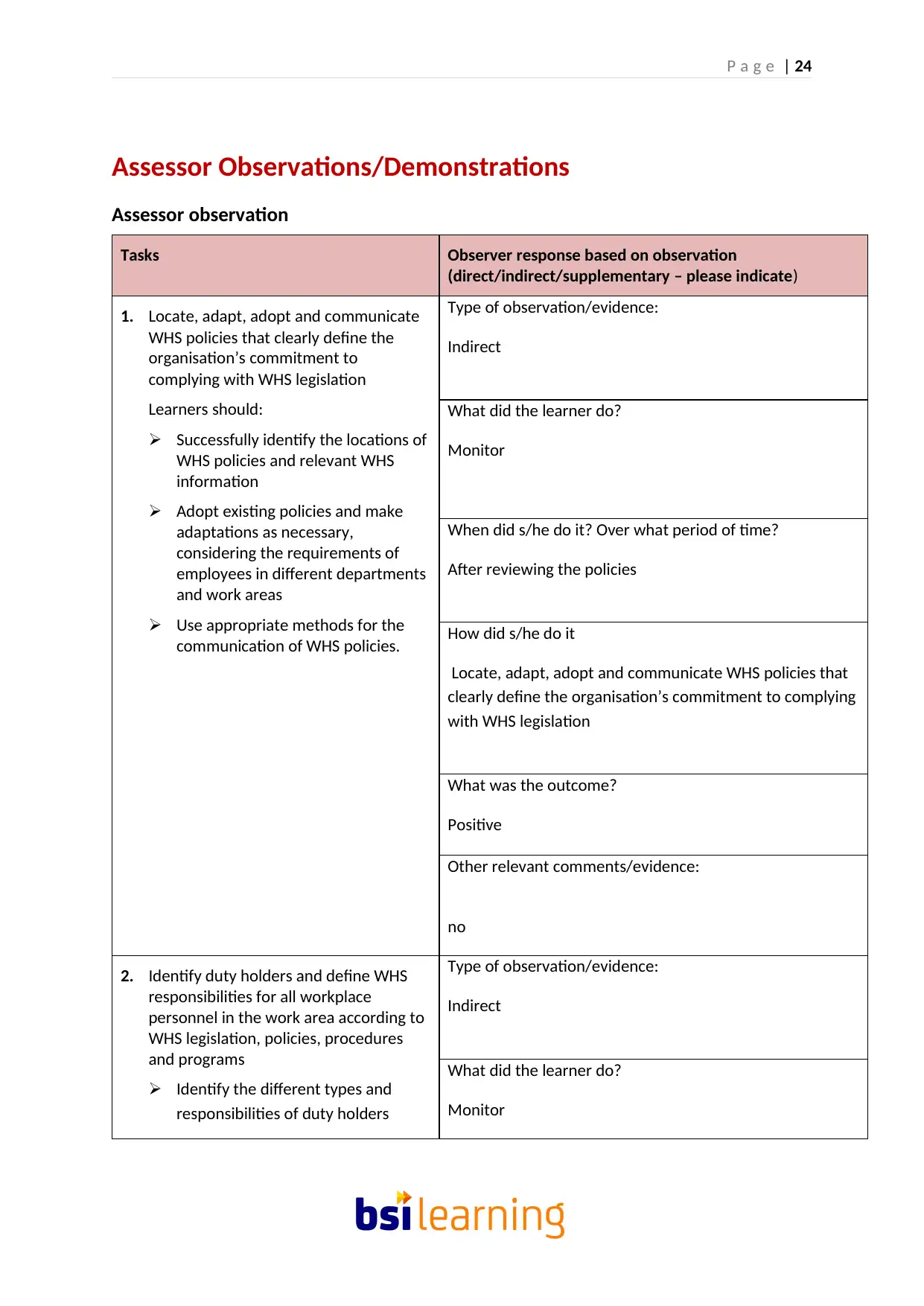
P a g e | 24
Assessor Observations/Demonstrations
Assessor observation
Tasks Observer response based on observation
(direct/indirect/supplementary – please indicate)
1. Locate, adapt, adopt and communicate
WHS policies that clearly define the
organisation’s commitment to
complying with WHS legislation
Learners should:
Successfully identify the locations of
WHS policies and relevant WHS
information
Adopt existing policies and make
adaptations as necessary,
considering the requirements of
employees in different departments
and work areas
Use appropriate methods for the
communication of WHS policies.
Type of observation/evidence:
Indirect
What did the learner do?
Monitor
When did s/he do it? Over what period of time?
After reviewing the policies
How did s/he do it
Locate, adapt, adopt and communicate WHS policies that
clearly define the organisation’s commitment to complying
with WHS legislation
What was the outcome?
Positive
Other relevant comments/evidence:
no
2. Identify duty holders and define WHS
responsibilities for all workplace
personnel in the work area according to
WHS legislation, policies, procedures
and programs
Identify the different types and
responsibilities of duty holders
Type of observation/evidence:
Indirect
What did the learner do?
Monitor
Assessor Observations/Demonstrations
Assessor observation
Tasks Observer response based on observation
(direct/indirect/supplementary – please indicate)
1. Locate, adapt, adopt and communicate
WHS policies that clearly define the
organisation’s commitment to
complying with WHS legislation
Learners should:
Successfully identify the locations of
WHS policies and relevant WHS
information
Adopt existing policies and make
adaptations as necessary,
considering the requirements of
employees in different departments
and work areas
Use appropriate methods for the
communication of WHS policies.
Type of observation/evidence:
Indirect
What did the learner do?
Monitor
When did s/he do it? Over what period of time?
After reviewing the policies
How did s/he do it
Locate, adapt, adopt and communicate WHS policies that
clearly define the organisation’s commitment to complying
with WHS legislation
What was the outcome?
Positive
Other relevant comments/evidence:
no
2. Identify duty holders and define WHS
responsibilities for all workplace
personnel in the work area according to
WHS legislation, policies, procedures
and programs
Identify the different types and
responsibilities of duty holders
Type of observation/evidence:
Indirect
What did the learner do?
Monitor
Paraphrase This Document
Need a fresh take? Get an instant paraphrase of this document with our AI Paraphraser
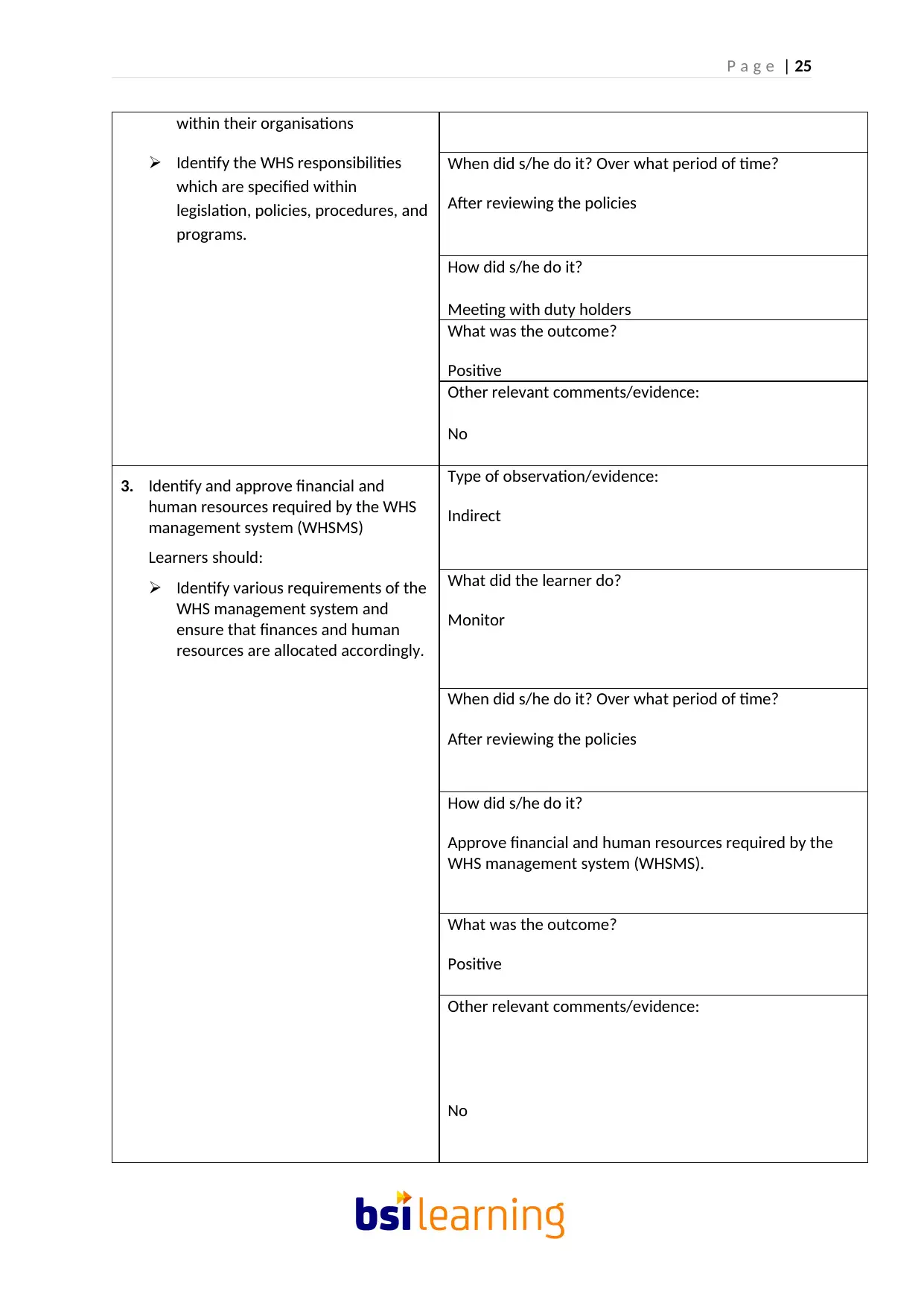
P a g e | 25
within their organisations
Identify the WHS responsibilities
which are specified within
legislation, policies, procedures, and
programs.
When did s/he do it? Over what period of time?
After reviewing the policies
How did s/he do it?
Meeting with duty holders
What was the outcome?
Positive
Other relevant comments/evidence:
No
3. Identify and approve financial and
human resources required by the WHS
management system (WHSMS)
Learners should:
Identify various requirements of the
WHS management system and
ensure that finances and human
resources are allocated accordingly.
Type of observation/evidence:
Indirect
What did the learner do?
Monitor
When did s/he do it? Over what period of time?
After reviewing the policies
How did s/he do it?
Approve financial and human resources required by the
WHS management system (WHSMS).
What was the outcome?
Positive
Other relevant comments/evidence:
No
within their organisations
Identify the WHS responsibilities
which are specified within
legislation, policies, procedures, and
programs.
When did s/he do it? Over what period of time?
After reviewing the policies
How did s/he do it?
Meeting with duty holders
What was the outcome?
Positive
Other relevant comments/evidence:
No
3. Identify and approve financial and
human resources required by the WHS
management system (WHSMS)
Learners should:
Identify various requirements of the
WHS management system and
ensure that finances and human
resources are allocated accordingly.
Type of observation/evidence:
Indirect
What did the learner do?
Monitor
When did s/he do it? Over what period of time?
After reviewing the policies
How did s/he do it?
Approve financial and human resources required by the
WHS management system (WHSMS).
What was the outcome?
Positive
Other relevant comments/evidence:
No
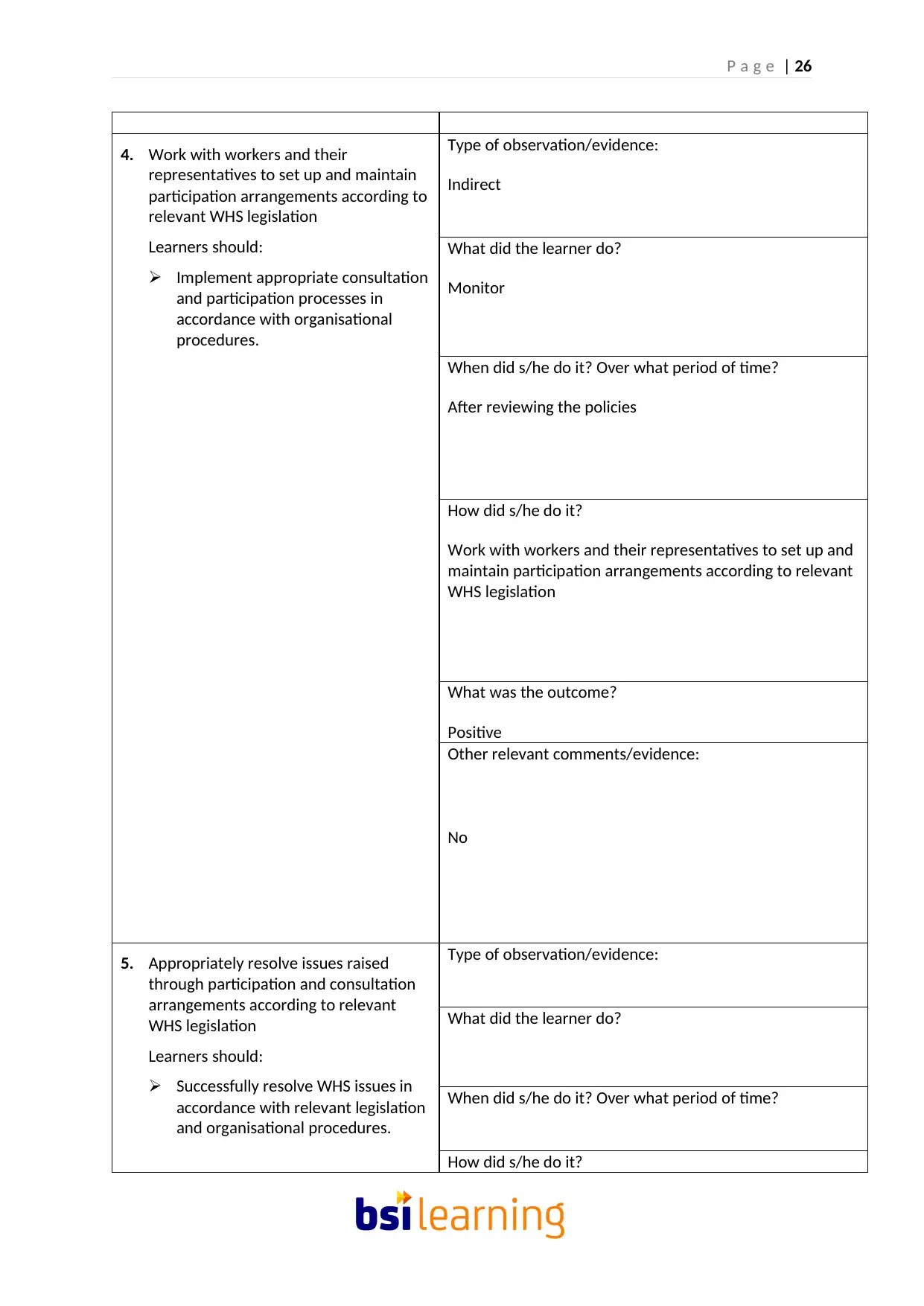
P a g e | 26
4. Work with workers and their
representatives to set up and maintain
participation arrangements according to
relevant WHS legislation
Learners should:
Implement appropriate consultation
and participation processes in
accordance with organisational
procedures.
Type of observation/evidence:
Indirect
What did the learner do?
Monitor
When did s/he do it? Over what period of time?
After reviewing the policies
How did s/he do it?
Work with workers and their representatives to set up and
maintain participation arrangements according to relevant
WHS legislation
What was the outcome?
Positive
Other relevant comments/evidence:
No
5. Appropriately resolve issues raised
through participation and consultation
arrangements according to relevant
WHS legislation
Learners should:
Successfully resolve WHS issues in
accordance with relevant legislation
and organisational procedures.
Type of observation/evidence:
What did the learner do?
When did s/he do it? Over what period of time?
How did s/he do it?
4. Work with workers and their
representatives to set up and maintain
participation arrangements according to
relevant WHS legislation
Learners should:
Implement appropriate consultation
and participation processes in
accordance with organisational
procedures.
Type of observation/evidence:
Indirect
What did the learner do?
Monitor
When did s/he do it? Over what period of time?
After reviewing the policies
How did s/he do it?
Work with workers and their representatives to set up and
maintain participation arrangements according to relevant
WHS legislation
What was the outcome?
Positive
Other relevant comments/evidence:
No
5. Appropriately resolve issues raised
through participation and consultation
arrangements according to relevant
WHS legislation
Learners should:
Successfully resolve WHS issues in
accordance with relevant legislation
and organisational procedures.
Type of observation/evidence:
What did the learner do?
When did s/he do it? Over what period of time?
How did s/he do it?
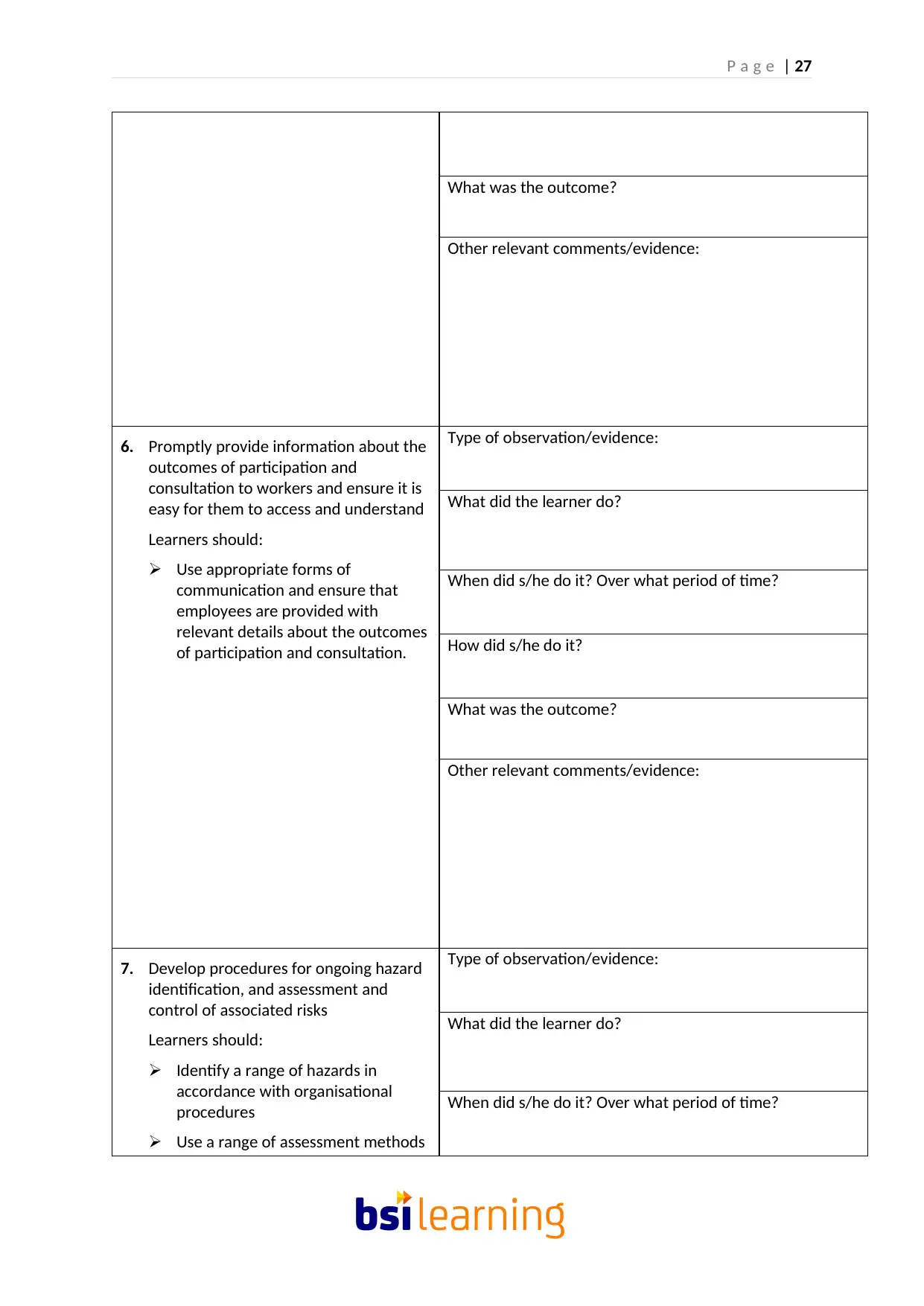
P a g e | 27
What was the outcome?
Other relevant comments/evidence:
6. Promptly provide information about the
outcomes of participation and
consultation to workers and ensure it is
easy for them to access and understand
Learners should:
Use appropriate forms of
communication and ensure that
employees are provided with
relevant details about the outcomes
of participation and consultation.
Type of observation/evidence:
What did the learner do?
When did s/he do it? Over what period of time?
How did s/he do it?
What was the outcome?
Other relevant comments/evidence:
7. Develop procedures for ongoing hazard
identification, and assessment and
control of associated risks
Learners should:
Identify a range of hazards in
accordance with organisational
procedures
Use a range of assessment methods
Type of observation/evidence:
What did the learner do?
When did s/he do it? Over what period of time?
What was the outcome?
Other relevant comments/evidence:
6. Promptly provide information about the
outcomes of participation and
consultation to workers and ensure it is
easy for them to access and understand
Learners should:
Use appropriate forms of
communication and ensure that
employees are provided with
relevant details about the outcomes
of participation and consultation.
Type of observation/evidence:
What did the learner do?
When did s/he do it? Over what period of time?
How did s/he do it?
What was the outcome?
Other relevant comments/evidence:
7. Develop procedures for ongoing hazard
identification, and assessment and
control of associated risks
Learners should:
Identify a range of hazards in
accordance with organisational
procedures
Use a range of assessment methods
Type of observation/evidence:
What did the learner do?
When did s/he do it? Over what period of time?
Secure Best Marks with AI Grader
Need help grading? Try our AI Grader for instant feedback on your assignments.
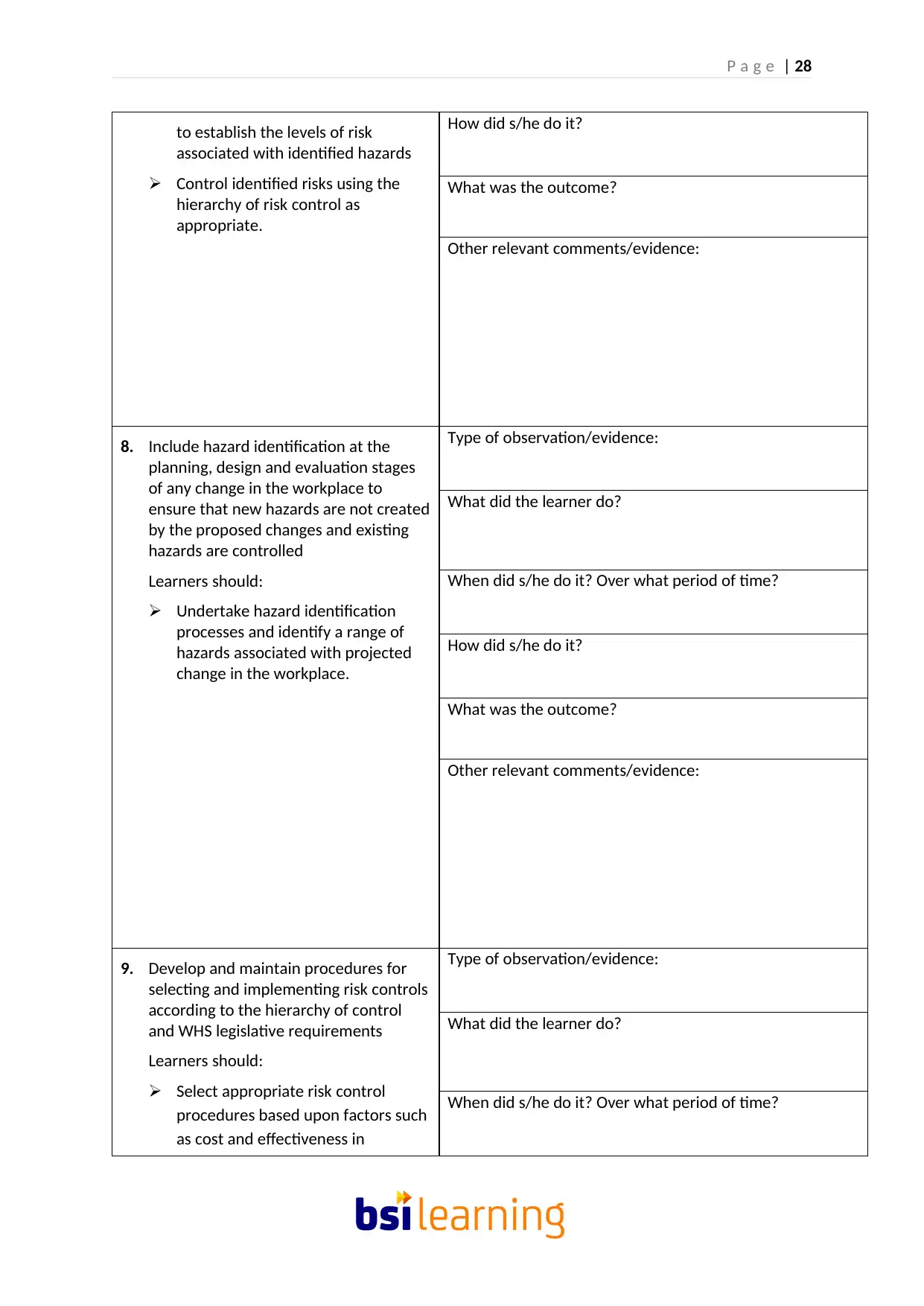
P a g e | 28
to establish the levels of risk
associated with identified hazards
Control identified risks using the
hierarchy of risk control as
appropriate.
How did s/he do it?
What was the outcome?
Other relevant comments/evidence:
8. Include hazard identification at the
planning, design and evaluation stages
of any change in the workplace to
ensure that new hazards are not created
by the proposed changes and existing
hazards are controlled
Learners should:
Undertake hazard identification
processes and identify a range of
hazards associated with projected
change in the workplace.
Type of observation/evidence:
What did the learner do?
When did s/he do it? Over what period of time?
How did s/he do it?
What was the outcome?
Other relevant comments/evidence:
9. Develop and maintain procedures for
selecting and implementing risk controls
according to the hierarchy of control
and WHS legislative requirements
Learners should:
Select appropriate risk control
procedures based upon factors such
as cost and effectiveness in
Type of observation/evidence:
What did the learner do?
When did s/he do it? Over what period of time?
to establish the levels of risk
associated with identified hazards
Control identified risks using the
hierarchy of risk control as
appropriate.
How did s/he do it?
What was the outcome?
Other relevant comments/evidence:
8. Include hazard identification at the
planning, design and evaluation stages
of any change in the workplace to
ensure that new hazards are not created
by the proposed changes and existing
hazards are controlled
Learners should:
Undertake hazard identification
processes and identify a range of
hazards associated with projected
change in the workplace.
Type of observation/evidence:
What did the learner do?
When did s/he do it? Over what period of time?
How did s/he do it?
What was the outcome?
Other relevant comments/evidence:
9. Develop and maintain procedures for
selecting and implementing risk controls
according to the hierarchy of control
and WHS legislative requirements
Learners should:
Select appropriate risk control
procedures based upon factors such
as cost and effectiveness in
Type of observation/evidence:
What did the learner do?
When did s/he do it? Over what period of time?
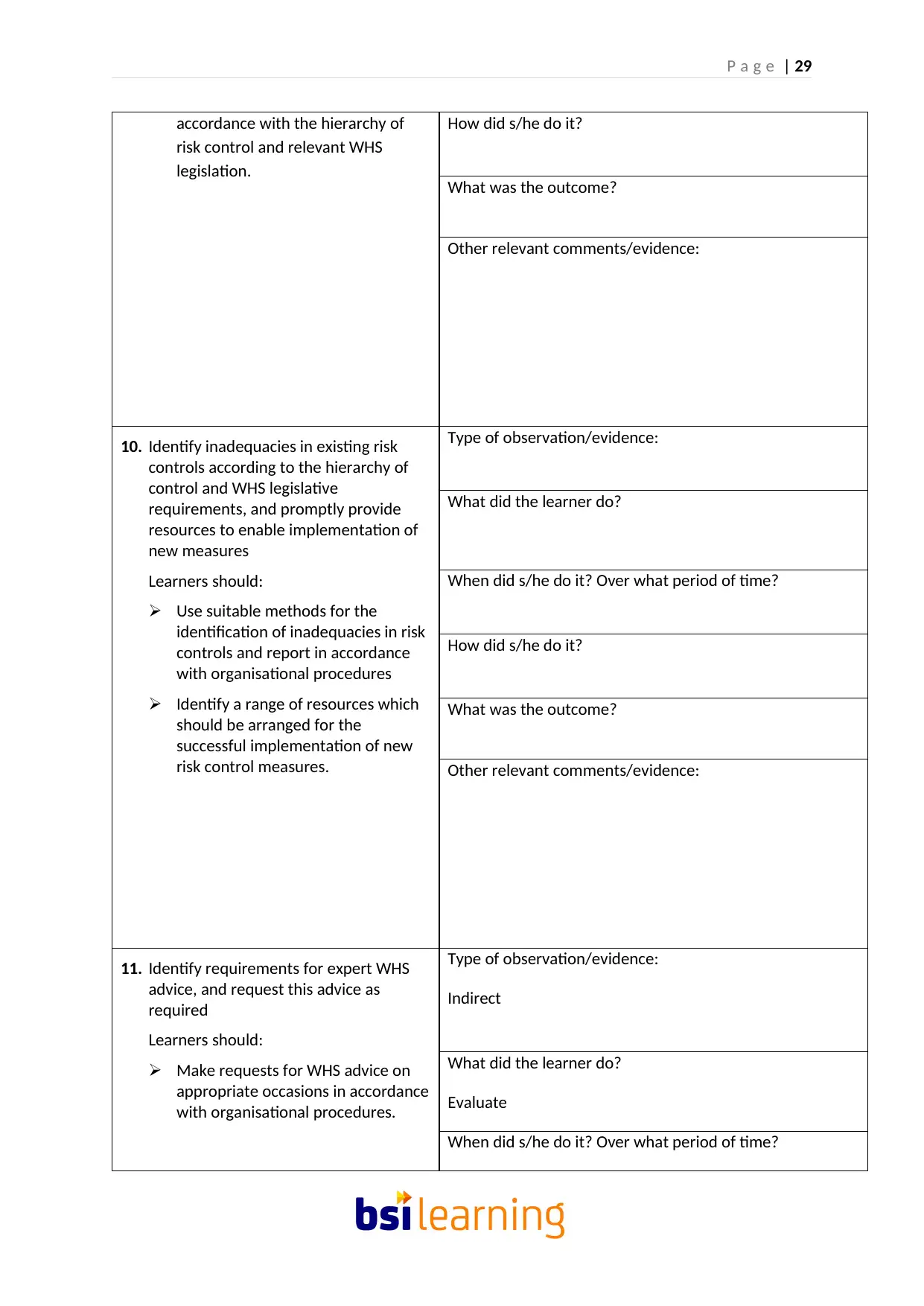
P a g e | 29
accordance with the hierarchy of
risk control and relevant WHS
legislation.
How did s/he do it?
What was the outcome?
Other relevant comments/evidence:
10. Identify inadequacies in existing risk
controls according to the hierarchy of
control and WHS legislative
requirements, and promptly provide
resources to enable implementation of
new measures
Learners should:
Use suitable methods for the
identification of inadequacies in risk
controls and report in accordance
with organisational procedures
Identify a range of resources which
should be arranged for the
successful implementation of new
risk control measures.
Type of observation/evidence:
What did the learner do?
When did s/he do it? Over what period of time?
How did s/he do it?
What was the outcome?
Other relevant comments/evidence:
11. Identify requirements for expert WHS
advice, and request this advice as
required
Learners should:
Make requests for WHS advice on
appropriate occasions in accordance
with organisational procedures.
Type of observation/evidence:
Indirect
What did the learner do?
Evaluate
When did s/he do it? Over what period of time?
accordance with the hierarchy of
risk control and relevant WHS
legislation.
How did s/he do it?
What was the outcome?
Other relevant comments/evidence:
10. Identify inadequacies in existing risk
controls according to the hierarchy of
control and WHS legislative
requirements, and promptly provide
resources to enable implementation of
new measures
Learners should:
Use suitable methods for the
identification of inadequacies in risk
controls and report in accordance
with organisational procedures
Identify a range of resources which
should be arranged for the
successful implementation of new
risk control measures.
Type of observation/evidence:
What did the learner do?
When did s/he do it? Over what period of time?
How did s/he do it?
What was the outcome?
Other relevant comments/evidence:
11. Identify requirements for expert WHS
advice, and request this advice as
required
Learners should:
Make requests for WHS advice on
appropriate occasions in accordance
with organisational procedures.
Type of observation/evidence:
Indirect
What did the learner do?
Evaluate
When did s/he do it? Over what period of time?
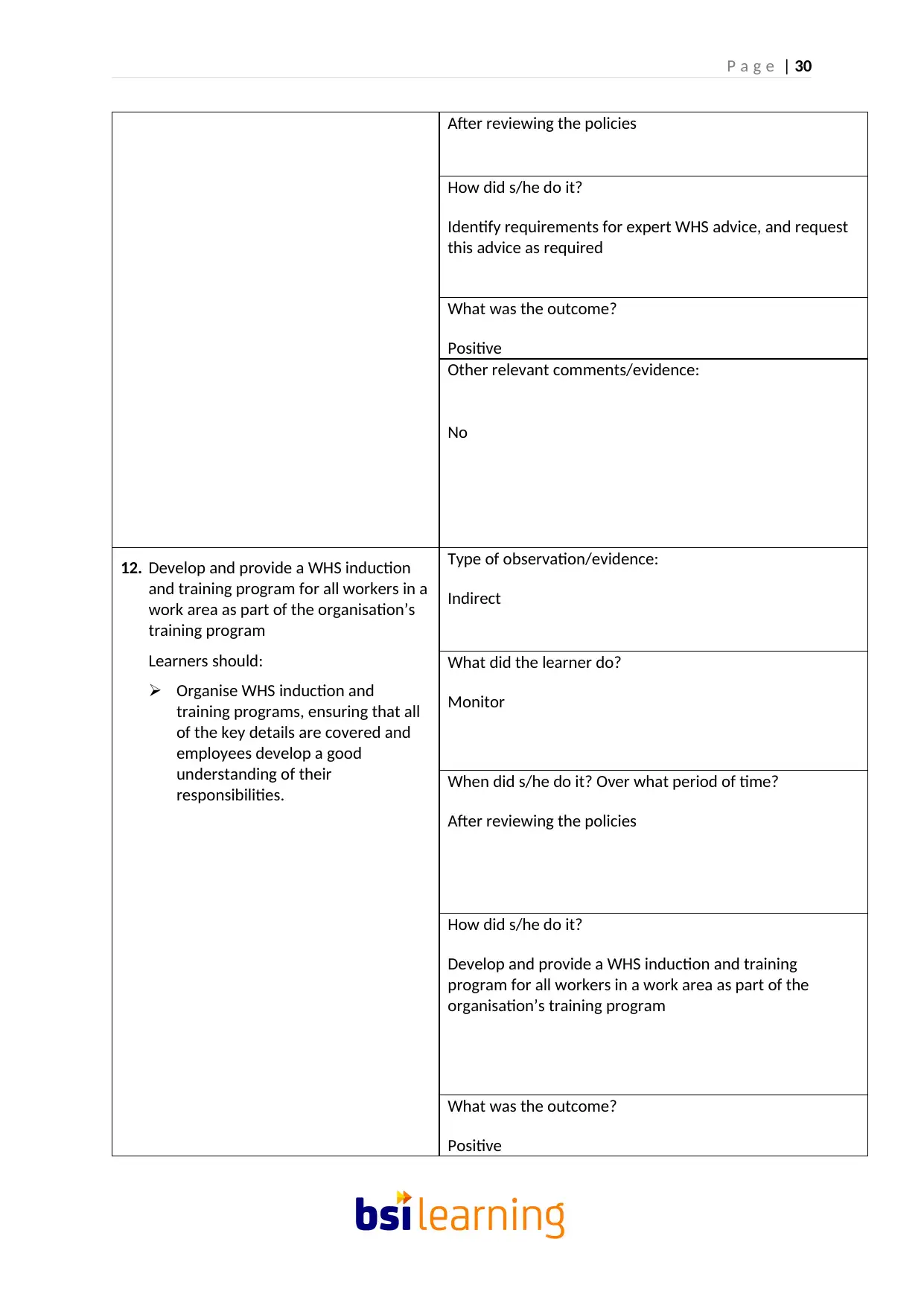
P a g e | 30
After reviewing the policies
How did s/he do it?
Identify requirements for expert WHS advice, and request
this advice as required
What was the outcome?
Positive
Other relevant comments/evidence:
No
12. Develop and provide a WHS induction
and training program for all workers in a
work area as part of the organisation’s
training program
Learners should:
Organise WHS induction and
training programs, ensuring that all
of the key details are covered and
employees develop a good
understanding of their
responsibilities.
Type of observation/evidence:
Indirect
What did the learner do?
Monitor
When did s/he do it? Over what period of time?
After reviewing the policies
How did s/he do it?
Develop and provide a WHS induction and training
program for all workers in a work area as part of the
organisation’s training program
What was the outcome?
Positive
After reviewing the policies
How did s/he do it?
Identify requirements for expert WHS advice, and request
this advice as required
What was the outcome?
Positive
Other relevant comments/evidence:
No
12. Develop and provide a WHS induction
and training program for all workers in a
work area as part of the organisation’s
training program
Learners should:
Organise WHS induction and
training programs, ensuring that all
of the key details are covered and
employees develop a good
understanding of their
responsibilities.
Type of observation/evidence:
Indirect
What did the learner do?
Monitor
When did s/he do it? Over what period of time?
After reviewing the policies
How did s/he do it?
Develop and provide a WHS induction and training
program for all workers in a work area as part of the
organisation’s training program
What was the outcome?
Positive
Paraphrase This Document
Need a fresh take? Get an instant paraphrase of this document with our AI Paraphraser
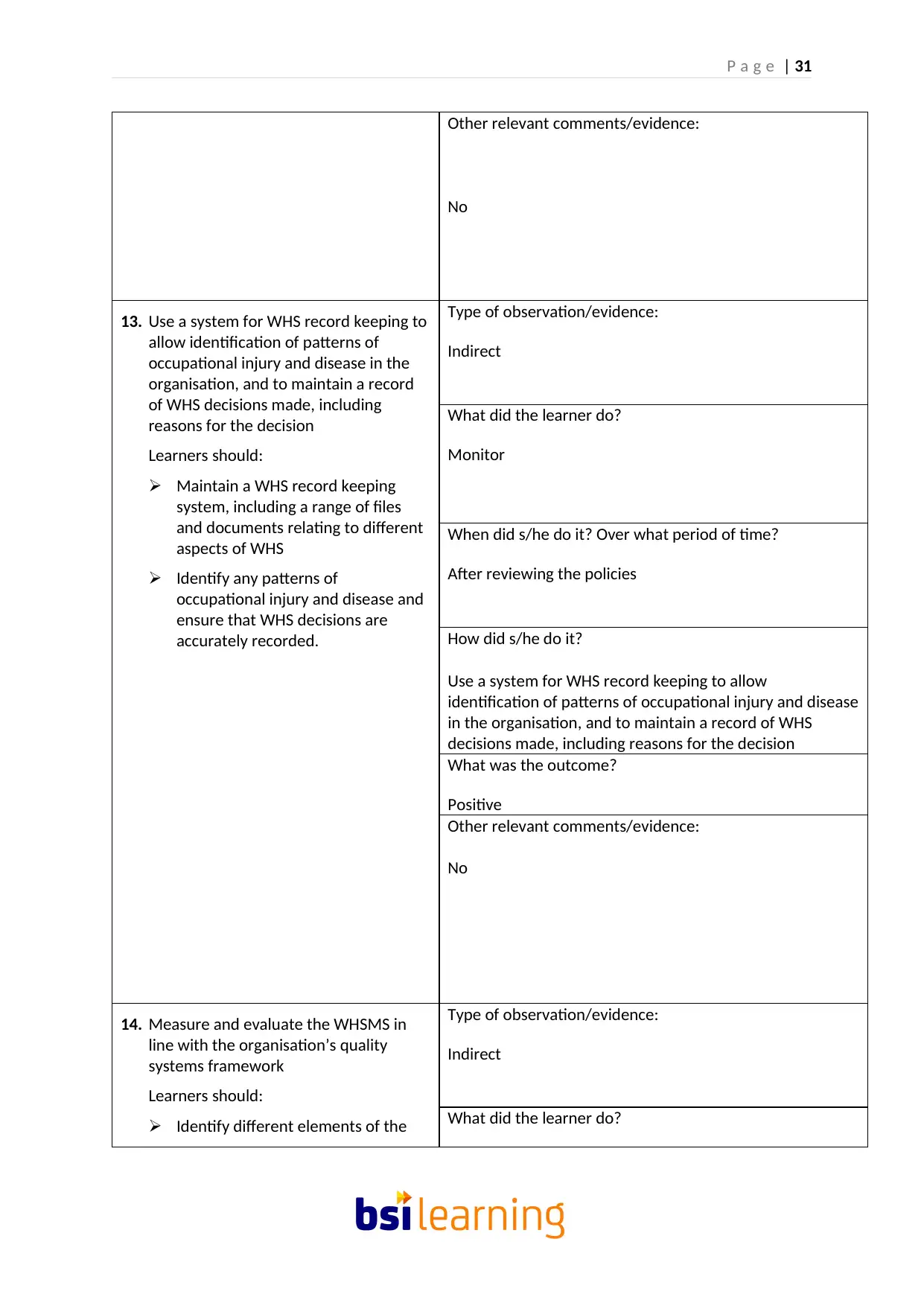
P a g e | 31
Other relevant comments/evidence:
No
13. Use a system for WHS record keeping to
allow identification of patterns of
occupational injury and disease in the
organisation, and to maintain a record
of WHS decisions made, including
reasons for the decision
Learners should:
Maintain a WHS record keeping
system, including a range of files
and documents relating to different
aspects of WHS
Identify any patterns of
occupational injury and disease and
ensure that WHS decisions are
accurately recorded.
Type of observation/evidence:
Indirect
What did the learner do?
Monitor
When did s/he do it? Over what period of time?
After reviewing the policies
How did s/he do it?
Use a system for WHS record keeping to allow
identification of patterns of occupational injury and disease
in the organisation, and to maintain a record of WHS
decisions made, including reasons for the decision
What was the outcome?
Positive
Other relevant comments/evidence:
No
14. Measure and evaluate the WHSMS in
line with the organisation’s quality
systems framework
Learners should:
Identify different elements of the
Type of observation/evidence:
Indirect
What did the learner do?
Other relevant comments/evidence:
No
13. Use a system for WHS record keeping to
allow identification of patterns of
occupational injury and disease in the
organisation, and to maintain a record
of WHS decisions made, including
reasons for the decision
Learners should:
Maintain a WHS record keeping
system, including a range of files
and documents relating to different
aspects of WHS
Identify any patterns of
occupational injury and disease and
ensure that WHS decisions are
accurately recorded.
Type of observation/evidence:
Indirect
What did the learner do?
Monitor
When did s/he do it? Over what period of time?
After reviewing the policies
How did s/he do it?
Use a system for WHS record keeping to allow
identification of patterns of occupational injury and disease
in the organisation, and to maintain a record of WHS
decisions made, including reasons for the decision
What was the outcome?
Positive
Other relevant comments/evidence:
No
14. Measure and evaluate the WHSMS in
line with the organisation’s quality
systems framework
Learners should:
Identify different elements of the
Type of observation/evidence:
Indirect
What did the learner do?
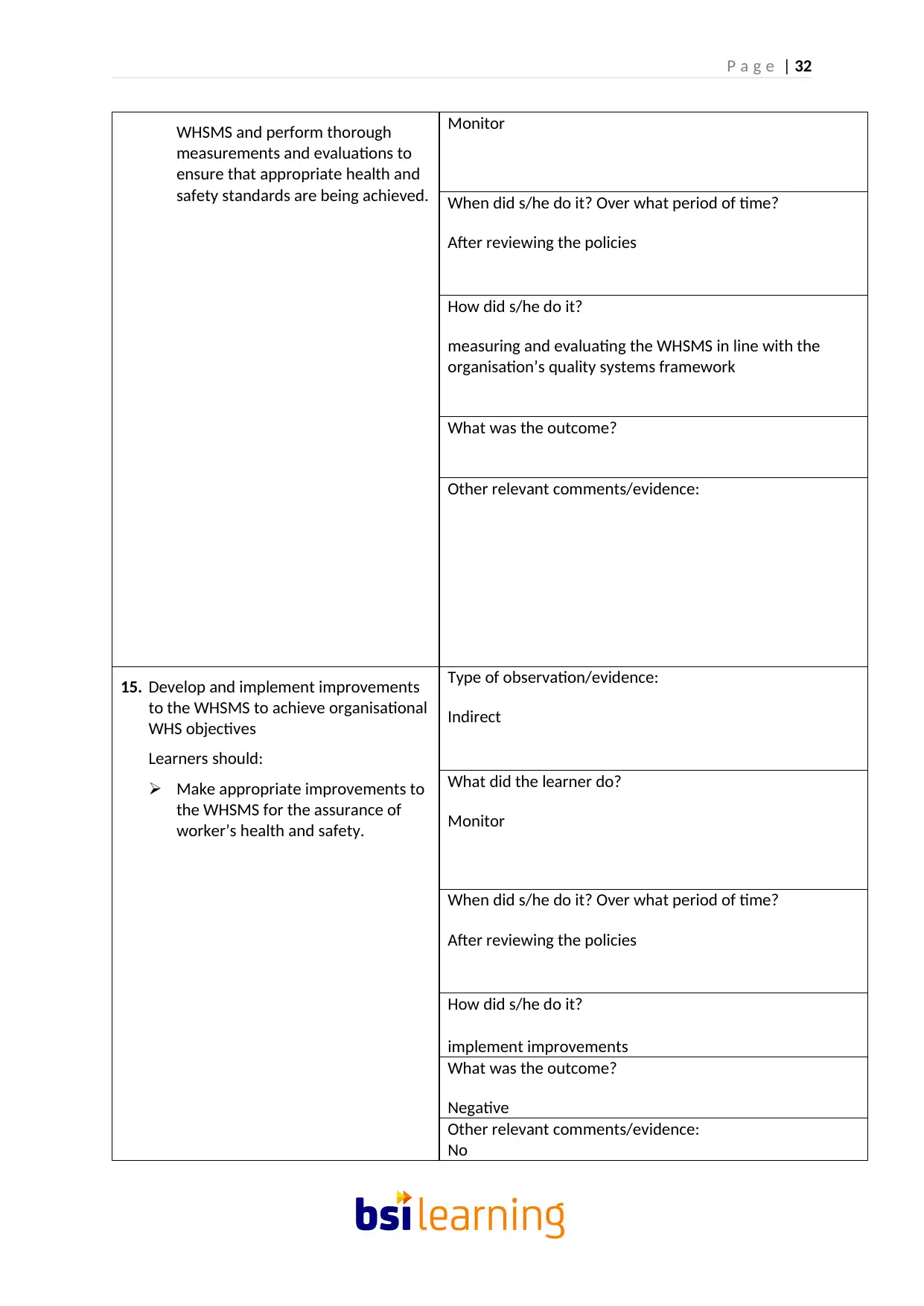
P a g e | 32
WHSMS and perform thorough
measurements and evaluations to
ensure that appropriate health and
safety standards are being achieved.
Monitor
When did s/he do it? Over what period of time?
After reviewing the policies
How did s/he do it?
measuring and evaluating the WHSMS in line with the
organisation’s quality systems framework
What was the outcome?
Other relevant comments/evidence:
15. Develop and implement improvements
to the WHSMS to achieve organisational
WHS objectives
Learners should:
Make appropriate improvements to
the WHSMS for the assurance of
worker’s health and safety.
Type of observation/evidence:
Indirect
What did the learner do?
Monitor
When did s/he do it? Over what period of time?
After reviewing the policies
How did s/he do it?
implement improvements
What was the outcome?
Negative
Other relevant comments/evidence:
No
WHSMS and perform thorough
measurements and evaluations to
ensure that appropriate health and
safety standards are being achieved.
Monitor
When did s/he do it? Over what period of time?
After reviewing the policies
How did s/he do it?
measuring and evaluating the WHSMS in line with the
organisation’s quality systems framework
What was the outcome?
Other relevant comments/evidence:
15. Develop and implement improvements
to the WHSMS to achieve organisational
WHS objectives
Learners should:
Make appropriate improvements to
the WHSMS for the assurance of
worker’s health and safety.
Type of observation/evidence:
Indirect
What did the learner do?
Monitor
When did s/he do it? Over what period of time?
After reviewing the policies
How did s/he do it?
implement improvements
What was the outcome?
Negative
Other relevant comments/evidence:
No
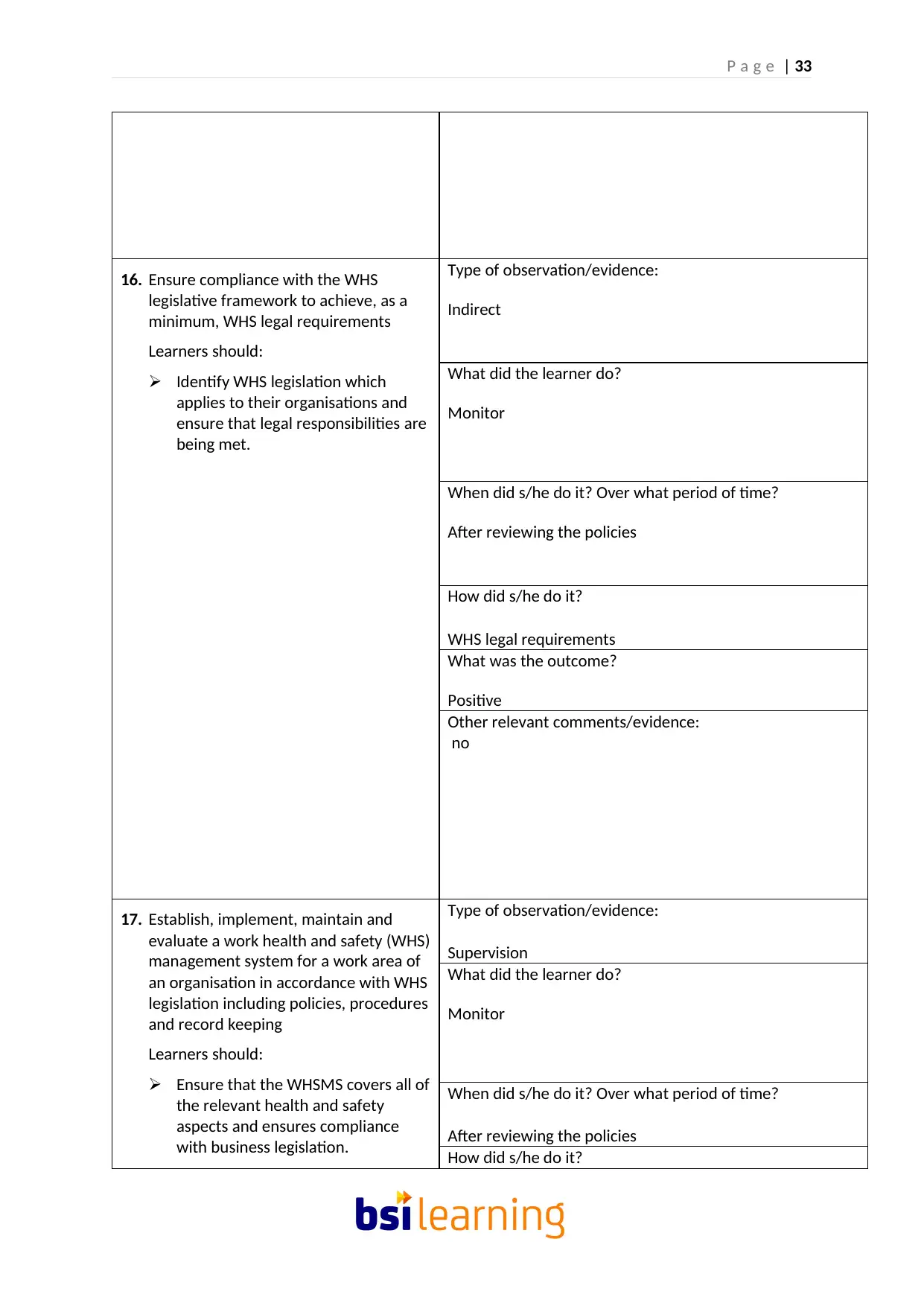
P a g e | 33
16. Ensure compliance with the WHS
legislative framework to achieve, as a
minimum, WHS legal requirements
Learners should:
Identify WHS legislation which
applies to their organisations and
ensure that legal responsibilities are
being met.
Type of observation/evidence:
Indirect
What did the learner do?
Monitor
When did s/he do it? Over what period of time?
After reviewing the policies
How did s/he do it?
WHS legal requirements
What was the outcome?
Positive
Other relevant comments/evidence:
no
17. Establish, implement, maintain and
evaluate a work health and safety (WHS)
management system for a work area of
an organisation in accordance with WHS
legislation including policies, procedures
and record keeping
Learners should:
Ensure that the WHSMS covers all of
the relevant health and safety
aspects and ensures compliance
with business legislation.
Type of observation/evidence:
Supervision
What did the learner do?
Monitor
When did s/he do it? Over what period of time?
After reviewing the policies
How did s/he do it?
16. Ensure compliance with the WHS
legislative framework to achieve, as a
minimum, WHS legal requirements
Learners should:
Identify WHS legislation which
applies to their organisations and
ensure that legal responsibilities are
being met.
Type of observation/evidence:
Indirect
What did the learner do?
Monitor
When did s/he do it? Over what period of time?
After reviewing the policies
How did s/he do it?
WHS legal requirements
What was the outcome?
Positive
Other relevant comments/evidence:
no
17. Establish, implement, maintain and
evaluate a work health and safety (WHS)
management system for a work area of
an organisation in accordance with WHS
legislation including policies, procedures
and record keeping
Learners should:
Ensure that the WHSMS covers all of
the relevant health and safety
aspects and ensures compliance
with business legislation.
Type of observation/evidence:
Supervision
What did the learner do?
Monitor
When did s/he do it? Over what period of time?
After reviewing the policies
How did s/he do it?
Secure Best Marks with AI Grader
Need help grading? Try our AI Grader for instant feedback on your assignments.
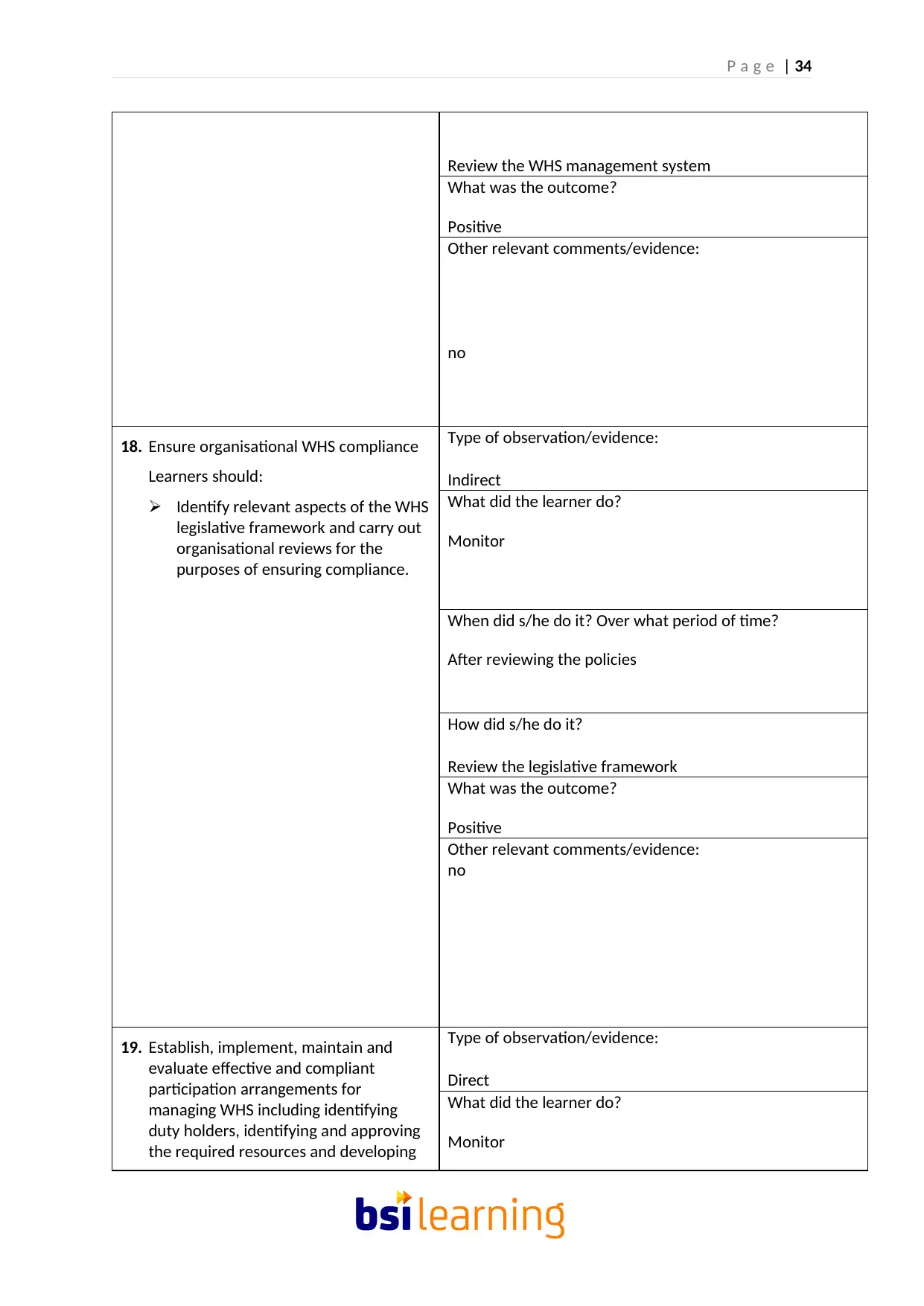
P a g e | 34
Review the WHS management system
What was the outcome?
Positive
Other relevant comments/evidence:
no
18. Ensure organisational WHS compliance
Learners should:
Identify relevant aspects of the WHS
legislative framework and carry out
organisational reviews for the
purposes of ensuring compliance.
Type of observation/evidence:
Indirect
What did the learner do?
Monitor
When did s/he do it? Over what period of time?
After reviewing the policies
How did s/he do it?
Review the legislative framework
What was the outcome?
Positive
Other relevant comments/evidence:
no
19. Establish, implement, maintain and
evaluate effective and compliant
participation arrangements for
managing WHS including identifying
duty holders, identifying and approving
the required resources and developing
Type of observation/evidence:
Direct
What did the learner do?
Monitor
Review the WHS management system
What was the outcome?
Positive
Other relevant comments/evidence:
no
18. Ensure organisational WHS compliance
Learners should:
Identify relevant aspects of the WHS
legislative framework and carry out
organisational reviews for the
purposes of ensuring compliance.
Type of observation/evidence:
Indirect
What did the learner do?
Monitor
When did s/he do it? Over what period of time?
After reviewing the policies
How did s/he do it?
Review the legislative framework
What was the outcome?
Positive
Other relevant comments/evidence:
no
19. Establish, implement, maintain and
evaluate effective and compliant
participation arrangements for
managing WHS including identifying
duty holders, identifying and approving
the required resources and developing
Type of observation/evidence:
Direct
What did the learner do?
Monitor
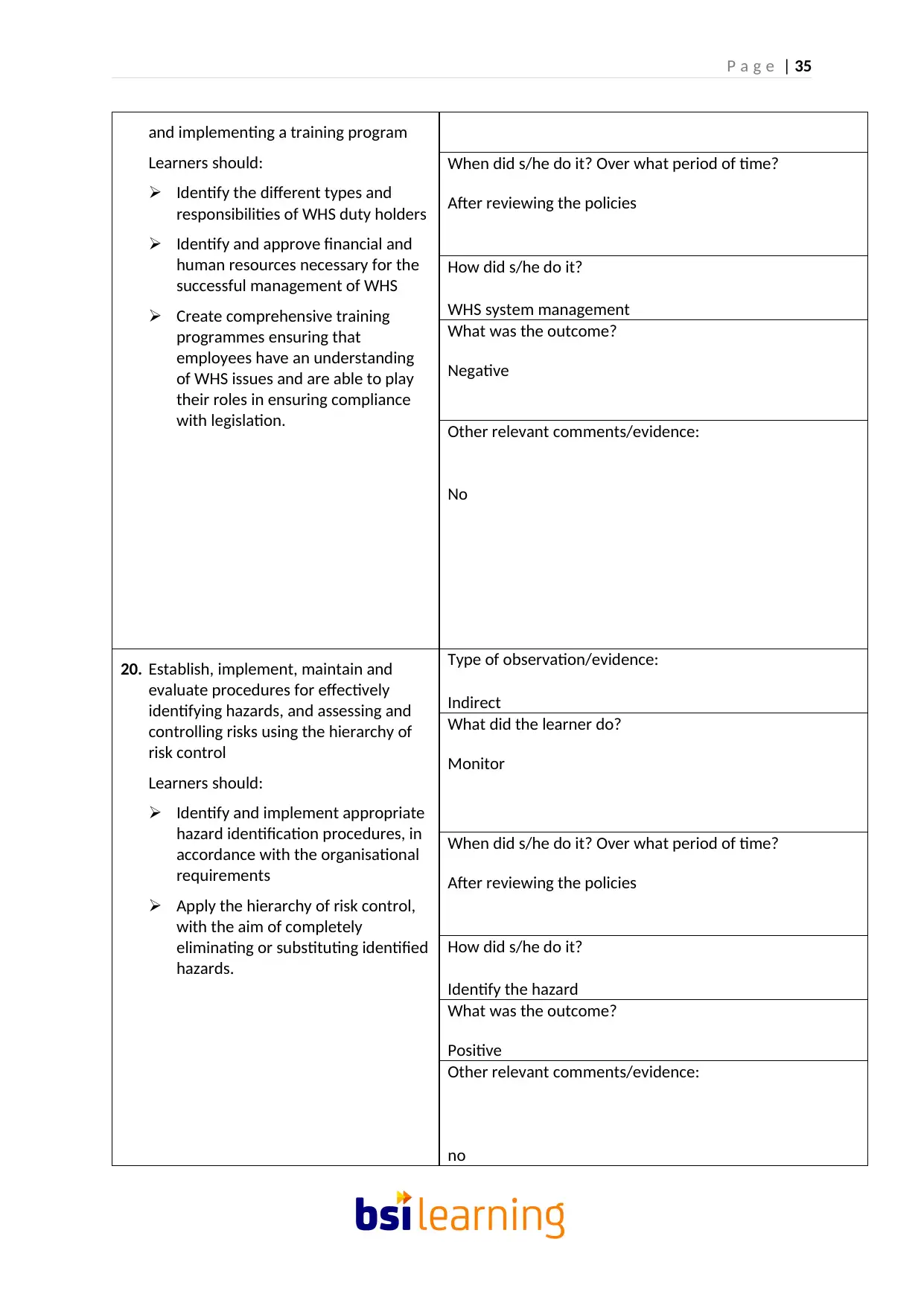
P a g e | 35
and implementing a training program
Learners should:
Identify the different types and
responsibilities of WHS duty holders
Identify and approve financial and
human resources necessary for the
successful management of WHS
Create comprehensive training
programmes ensuring that
employees have an understanding
of WHS issues and are able to play
their roles in ensuring compliance
with legislation.
When did s/he do it? Over what period of time?
After reviewing the policies
How did s/he do it?
WHS system management
What was the outcome?
Negative
Other relevant comments/evidence:
No
20. Establish, implement, maintain and
evaluate procedures for effectively
identifying hazards, and assessing and
controlling risks using the hierarchy of
risk control
Learners should:
Identify and implement appropriate
hazard identification procedures, in
accordance with the organisational
requirements
Apply the hierarchy of risk control,
with the aim of completely
eliminating or substituting identified
hazards.
Type of observation/evidence:
Indirect
What did the learner do?
Monitor
When did s/he do it? Over what period of time?
After reviewing the policies
How did s/he do it?
Identify the hazard
What was the outcome?
Positive
Other relevant comments/evidence:
no
and implementing a training program
Learners should:
Identify the different types and
responsibilities of WHS duty holders
Identify and approve financial and
human resources necessary for the
successful management of WHS
Create comprehensive training
programmes ensuring that
employees have an understanding
of WHS issues and are able to play
their roles in ensuring compliance
with legislation.
When did s/he do it? Over what period of time?
After reviewing the policies
How did s/he do it?
WHS system management
What was the outcome?
Negative
Other relevant comments/evidence:
No
20. Establish, implement, maintain and
evaluate procedures for effectively
identifying hazards, and assessing and
controlling risks using the hierarchy of
risk control
Learners should:
Identify and implement appropriate
hazard identification procedures, in
accordance with the organisational
requirements
Apply the hierarchy of risk control,
with the aim of completely
eliminating or substituting identified
hazards.
Type of observation/evidence:
Indirect
What did the learner do?
Monitor
When did s/he do it? Over what period of time?
After reviewing the policies
How did s/he do it?
Identify the hazard
What was the outcome?
Positive
Other relevant comments/evidence:
no
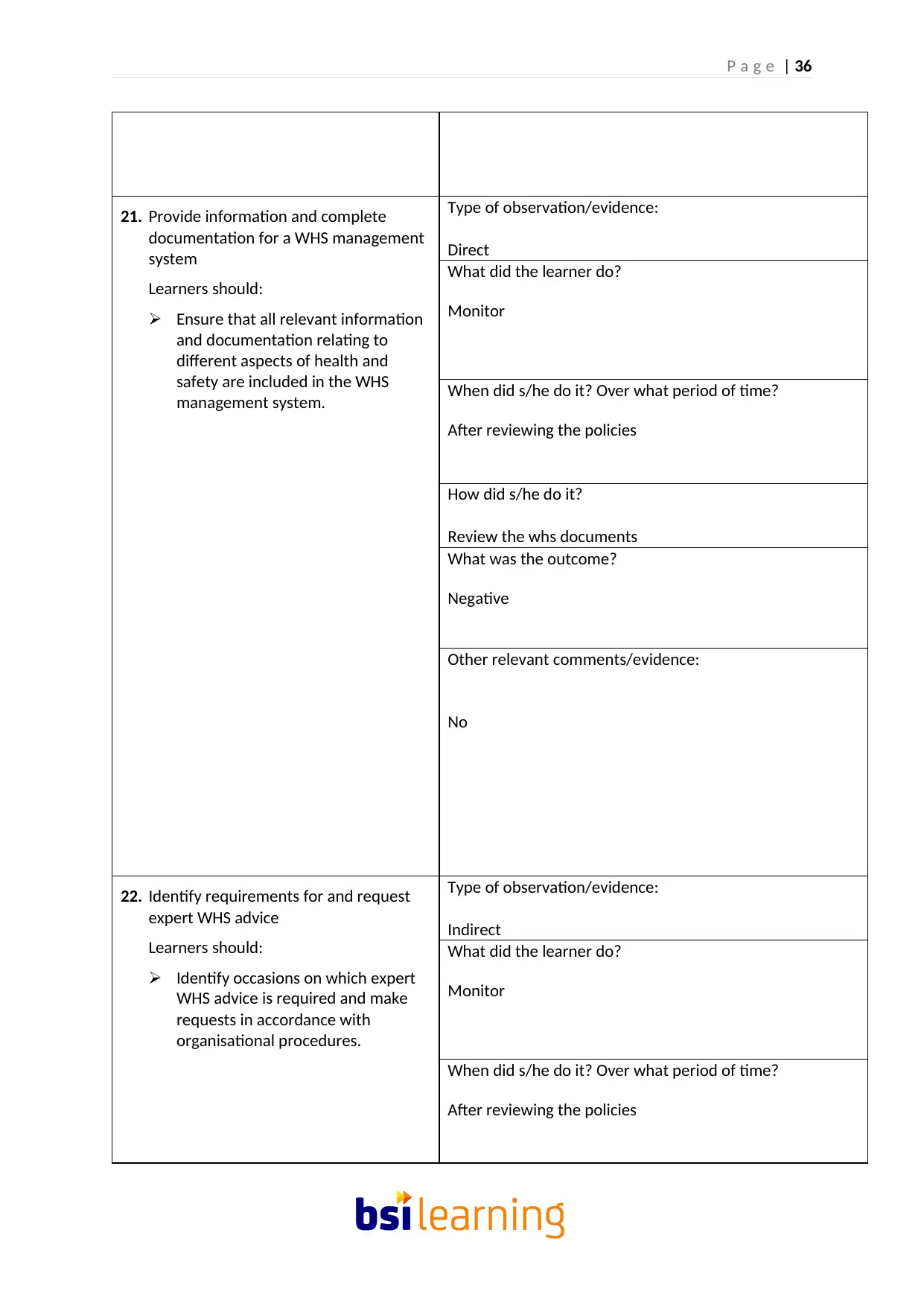
P a g e | 36
21. Provide information and complete
documentation for a WHS management
system
Learners should:
Ensure that all relevant information
and documentation relating to
different aspects of health and
safety are included in the WHS
management system.
Type of observation/evidence:
Direct
What did the learner do?
Monitor
When did s/he do it? Over what period of time?
After reviewing the policies
How did s/he do it?
Review the whs documents
What was the outcome?
Negative
Other relevant comments/evidence:
No
22. Identify requirements for and request
expert WHS advice
Learners should:
Identify occasions on which expert
WHS advice is required and make
requests in accordance with
organisational procedures.
Type of observation/evidence:
Indirect
What did the learner do?
Monitor
When did s/he do it? Over what period of time?
After reviewing the policies
21. Provide information and complete
documentation for a WHS management
system
Learners should:
Ensure that all relevant information
and documentation relating to
different aspects of health and
safety are included in the WHS
management system.
Type of observation/evidence:
Direct
What did the learner do?
Monitor
When did s/he do it? Over what period of time?
After reviewing the policies
How did s/he do it?
Review the whs documents
What was the outcome?
Negative
Other relevant comments/evidence:
No
22. Identify requirements for and request
expert WHS advice
Learners should:
Identify occasions on which expert
WHS advice is required and make
requests in accordance with
organisational procedures.
Type of observation/evidence:
Indirect
What did the learner do?
Monitor
When did s/he do it? Over what period of time?
After reviewing the policies
Paraphrase This Document
Need a fresh take? Get an instant paraphrase of this document with our AI Paraphraser
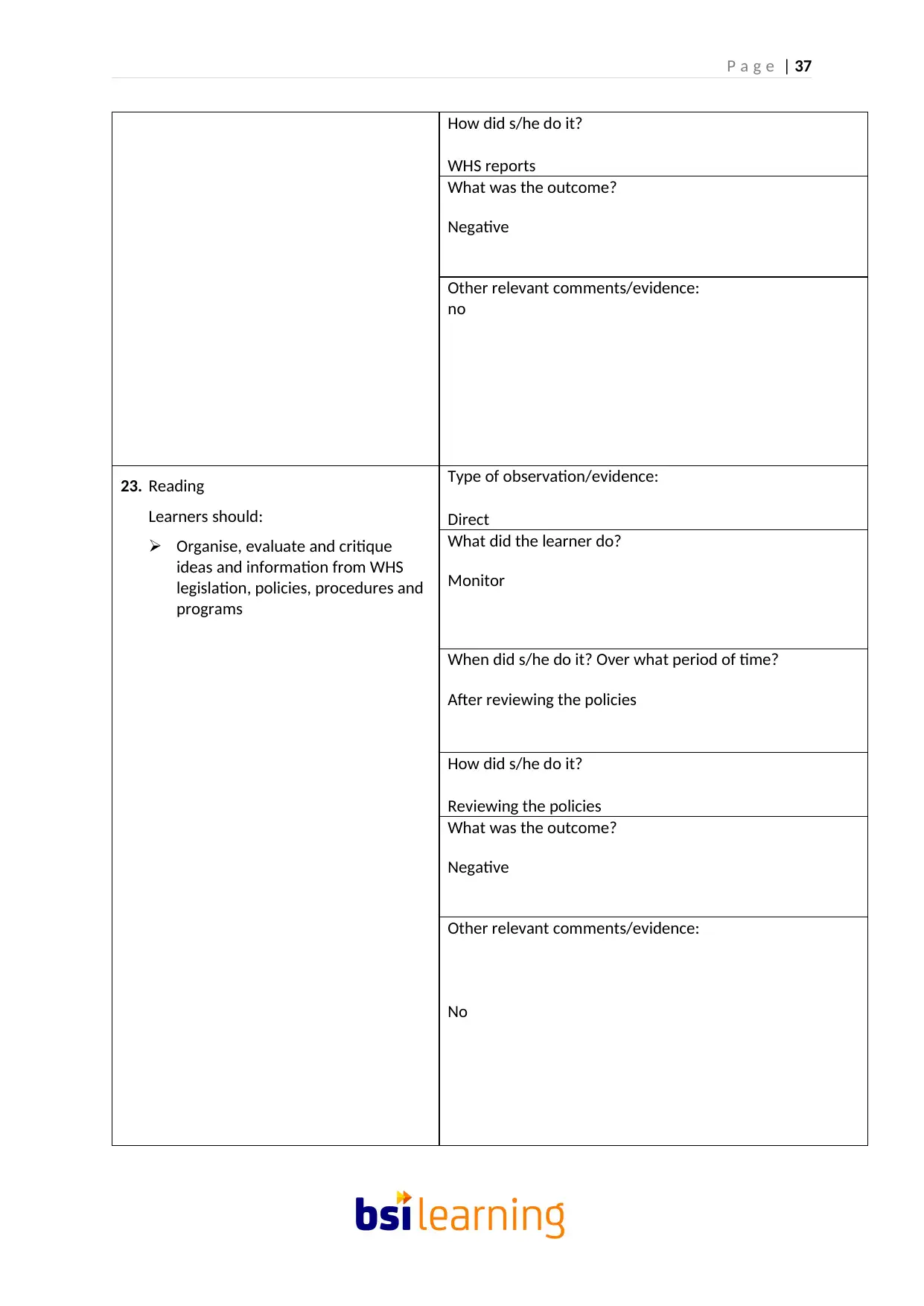
P a g e | 37
How did s/he do it?
WHS reports
What was the outcome?
Negative
Other relevant comments/evidence:
no
23. Reading
Learners should:
Organise, evaluate and critique
ideas and information from WHS
legislation, policies, procedures and
programs
Type of observation/evidence:
Direct
What did the learner do?
Monitor
When did s/he do it? Over what period of time?
After reviewing the policies
How did s/he do it?
Reviewing the policies
What was the outcome?
Negative
Other relevant comments/evidence:
No
How did s/he do it?
WHS reports
What was the outcome?
Negative
Other relevant comments/evidence:
no
23. Reading
Learners should:
Organise, evaluate and critique
ideas and information from WHS
legislation, policies, procedures and
programs
Type of observation/evidence:
Direct
What did the learner do?
Monitor
When did s/he do it? Over what period of time?
After reviewing the policies
How did s/he do it?
Reviewing the policies
What was the outcome?
Negative
Other relevant comments/evidence:
No
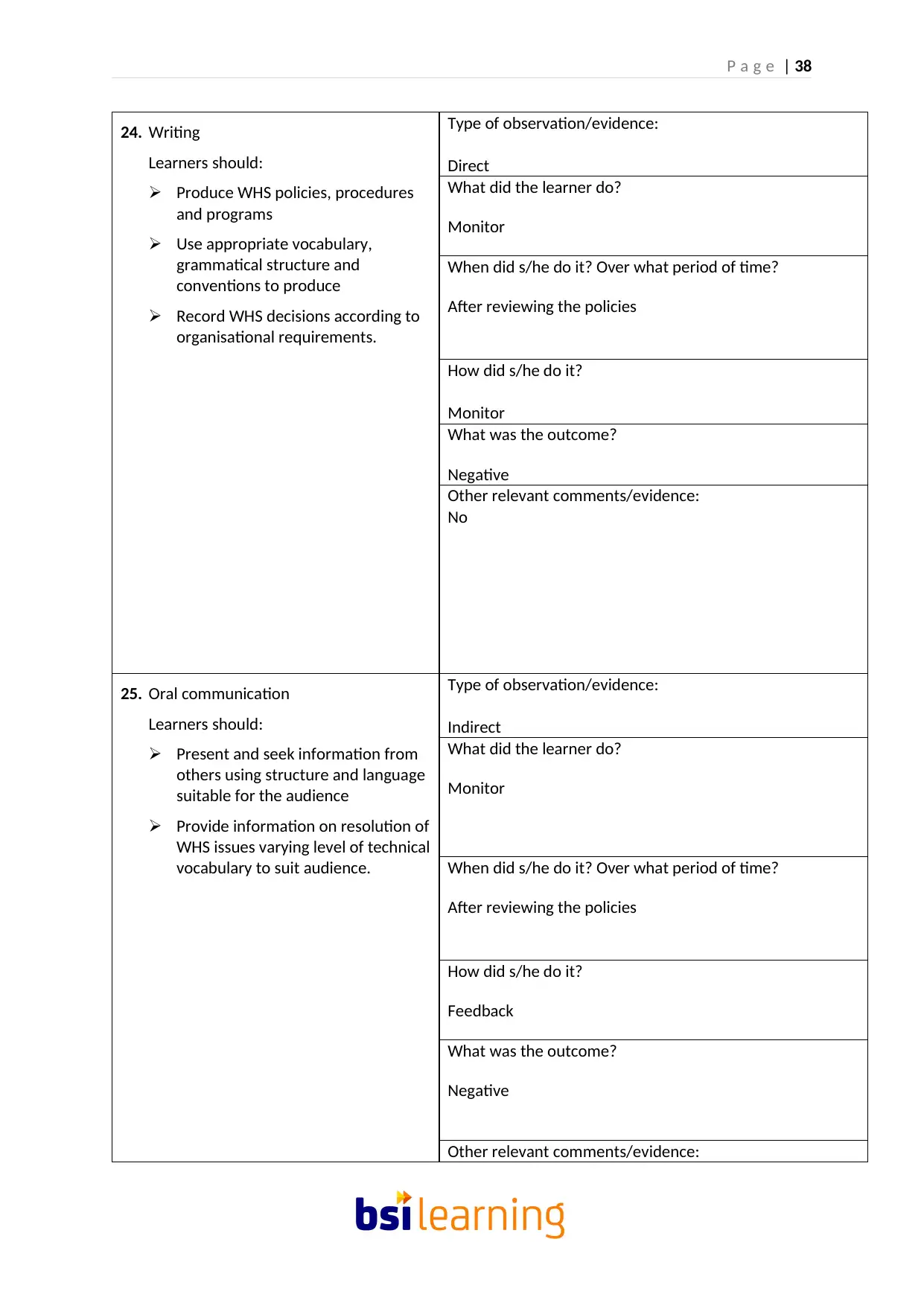
P a g e | 38
24. Writing
Learners should:
Produce WHS policies, procedures
and programs
Use appropriate vocabulary,
grammatical structure and
conventions to produce
Record WHS decisions according to
organisational requirements.
Type of observation/evidence:
Direct
What did the learner do?
Monitor
When did s/he do it? Over what period of time?
After reviewing the policies
How did s/he do it?
Monitor
What was the outcome?
Negative
Other relevant comments/evidence:
No
25. Oral communication
Learners should:
Present and seek information from
others using structure and language
suitable for the audience
Provide information on resolution of
WHS issues varying level of technical
vocabulary to suit audience.
Type of observation/evidence:
Indirect
What did the learner do?
Monitor
When did s/he do it? Over what period of time?
After reviewing the policies
How did s/he do it?
Feedback
What was the outcome?
Negative
Other relevant comments/evidence:
24. Writing
Learners should:
Produce WHS policies, procedures
and programs
Use appropriate vocabulary,
grammatical structure and
conventions to produce
Record WHS decisions according to
organisational requirements.
Type of observation/evidence:
Direct
What did the learner do?
Monitor
When did s/he do it? Over what period of time?
After reviewing the policies
How did s/he do it?
Monitor
What was the outcome?
Negative
Other relevant comments/evidence:
No
25. Oral communication
Learners should:
Present and seek information from
others using structure and language
suitable for the audience
Provide information on resolution of
WHS issues varying level of technical
vocabulary to suit audience.
Type of observation/evidence:
Indirect
What did the learner do?
Monitor
When did s/he do it? Over what period of time?
After reviewing the policies
How did s/he do it?
Feedback
What was the outcome?
Negative
Other relevant comments/evidence:
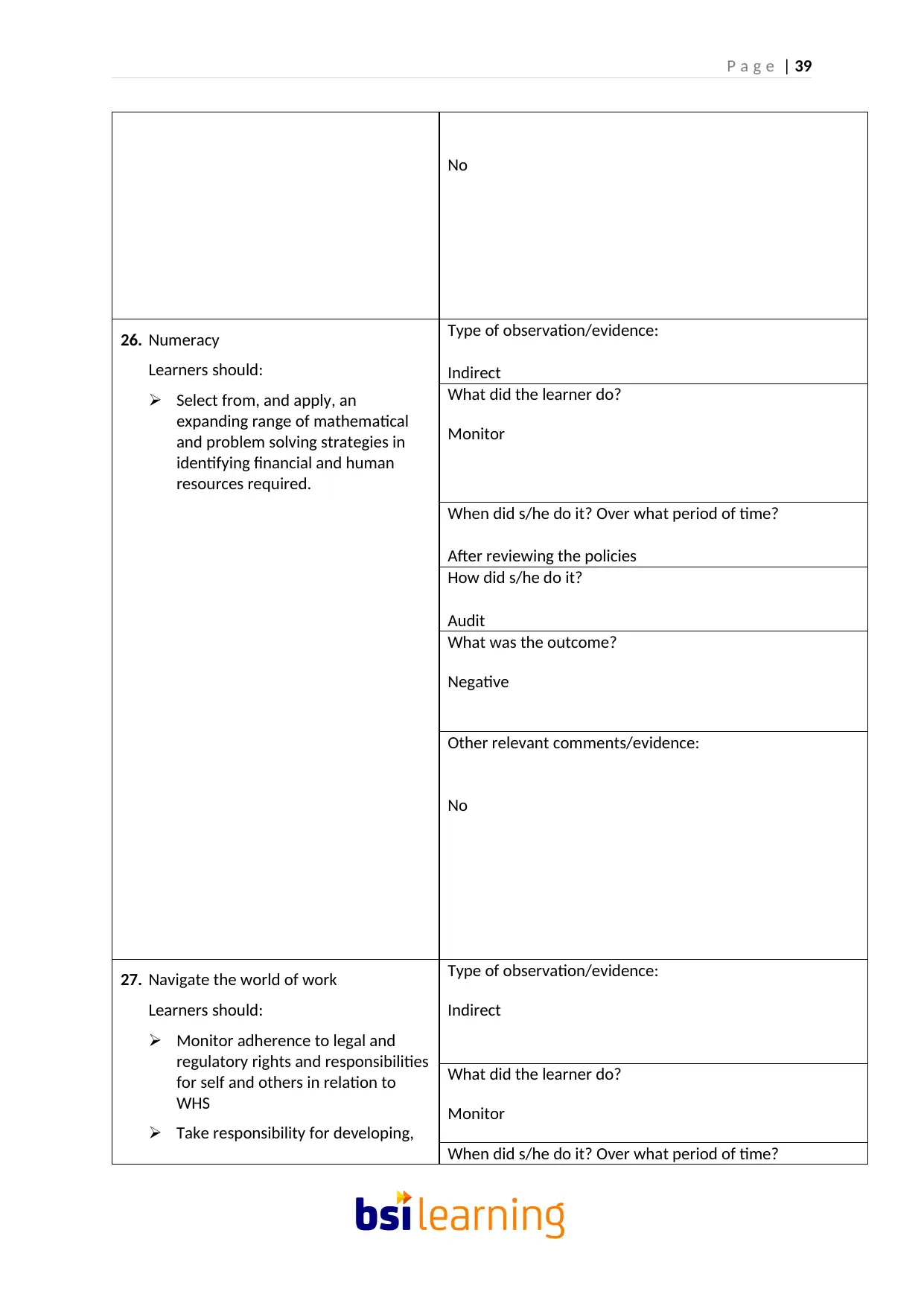
P a g e | 39
No
26. Numeracy
Learners should:
Select from, and apply, an
expanding range of mathematical
and problem solving strategies in
identifying financial and human
resources required.
Type of observation/evidence:
Indirect
What did the learner do?
Monitor
When did s/he do it? Over what period of time?
After reviewing the policies
How did s/he do it?
Audit
What was the outcome?
Negative
Other relevant comments/evidence:
No
27. Navigate the world of work
Learners should:
Monitor adherence to legal and
regulatory rights and responsibilities
for self and others in relation to
WHS
Take responsibility for developing,
Type of observation/evidence:
Indirect
What did the learner do?
Monitor
When did s/he do it? Over what period of time?
No
26. Numeracy
Learners should:
Select from, and apply, an
expanding range of mathematical
and problem solving strategies in
identifying financial and human
resources required.
Type of observation/evidence:
Indirect
What did the learner do?
Monitor
When did s/he do it? Over what period of time?
After reviewing the policies
How did s/he do it?
Audit
What was the outcome?
Negative
Other relevant comments/evidence:
No
27. Navigate the world of work
Learners should:
Monitor adherence to legal and
regulatory rights and responsibilities
for self and others in relation to
WHS
Take responsibility for developing,
Type of observation/evidence:
Indirect
What did the learner do?
Monitor
When did s/he do it? Over what period of time?
Secure Best Marks with AI Grader
Need help grading? Try our AI Grader for instant feedback on your assignments.
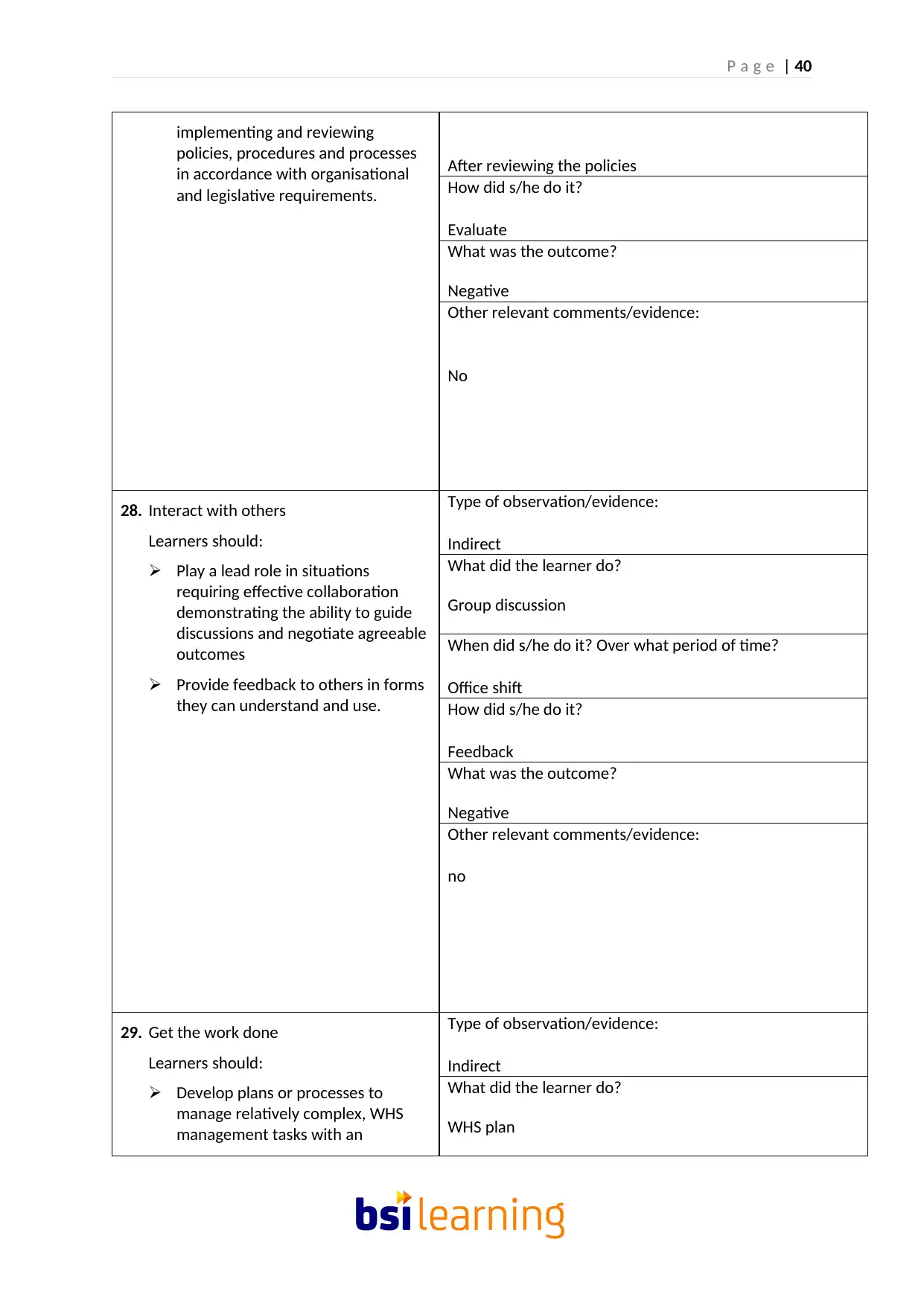
P a g e | 40
implementing and reviewing
policies, procedures and processes
in accordance with organisational
and legislative requirements.
After reviewing the policies
How did s/he do it?
Evaluate
What was the outcome?
Negative
Other relevant comments/evidence:
No
28. Interact with others
Learners should:
Play a lead role in situations
requiring effective collaboration
demonstrating the ability to guide
discussions and negotiate agreeable
outcomes
Provide feedback to others in forms
they can understand and use.
Type of observation/evidence:
Indirect
What did the learner do?
Group discussion
When did s/he do it? Over what period of time?
Office shift
How did s/he do it?
Feedback
What was the outcome?
Negative
Other relevant comments/evidence:
no
29. Get the work done
Learners should:
Develop plans or processes to
manage relatively complex, WHS
management tasks with an
Type of observation/evidence:
Indirect
What did the learner do?
WHS plan
implementing and reviewing
policies, procedures and processes
in accordance with organisational
and legislative requirements.
After reviewing the policies
How did s/he do it?
Evaluate
What was the outcome?
Negative
Other relevant comments/evidence:
No
28. Interact with others
Learners should:
Play a lead role in situations
requiring effective collaboration
demonstrating the ability to guide
discussions and negotiate agreeable
outcomes
Provide feedback to others in forms
they can understand and use.
Type of observation/evidence:
Indirect
What did the learner do?
Group discussion
When did s/he do it? Over what period of time?
Office shift
How did s/he do it?
Feedback
What was the outcome?
Negative
Other relevant comments/evidence:
no
29. Get the work done
Learners should:
Develop plans or processes to
manage relatively complex, WHS
management tasks with an
Type of observation/evidence:
Indirect
What did the learner do?
WHS plan
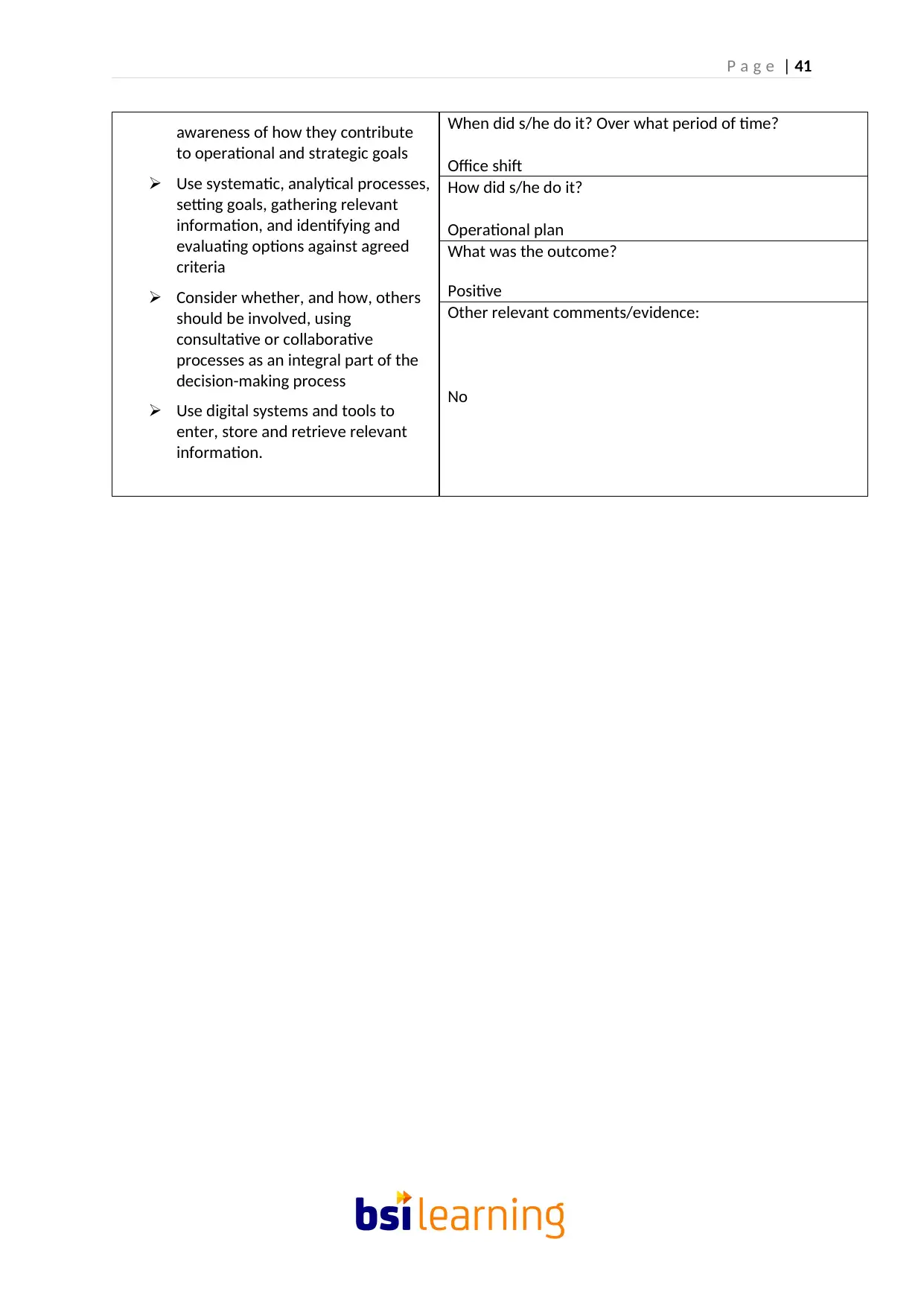
P a g e | 41
awareness of how they contribute
to operational and strategic goals
Use systematic, analytical processes,
setting goals, gathering relevant
information, and identifying and
evaluating options against agreed
criteria
Consider whether, and how, others
should be involved, using
consultative or collaborative
processes as an integral part of the
decision-making process
Use digital systems and tools to
enter, store and retrieve relevant
information.
When did s/he do it? Over what period of time?
Office shift
How did s/he do it?
Operational plan
What was the outcome?
Positive
Other relevant comments/evidence:
No
awareness of how they contribute
to operational and strategic goals
Use systematic, analytical processes,
setting goals, gathering relevant
information, and identifying and
evaluating options against agreed
criteria
Consider whether, and how, others
should be involved, using
consultative or collaborative
processes as an integral part of the
decision-making process
Use digital systems and tools to
enter, store and retrieve relevant
information.
When did s/he do it? Over what period of time?
Office shift
How did s/he do it?
Operational plan
What was the outcome?
Positive
Other relevant comments/evidence:
No
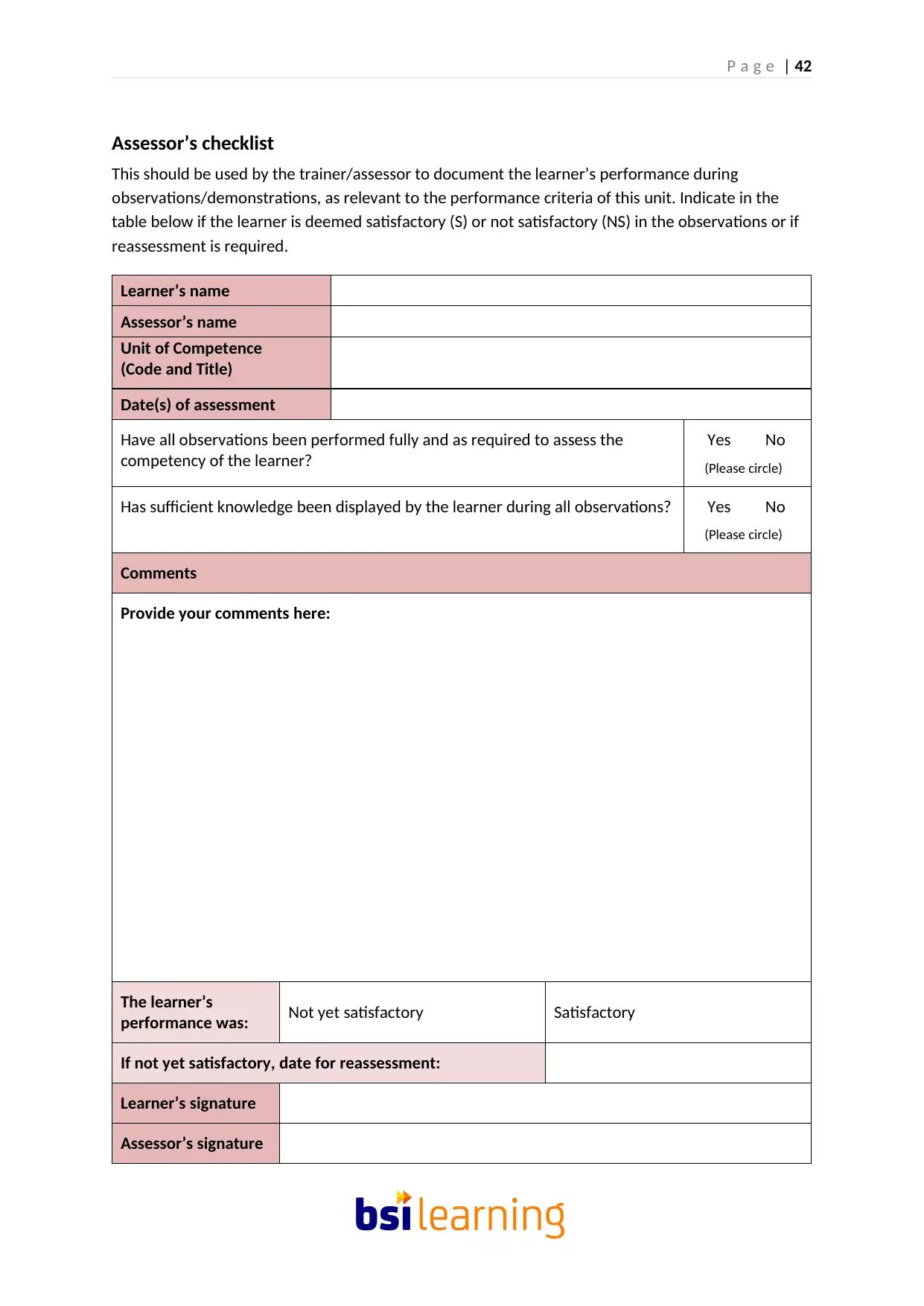
P a g e | 42
Assessor’s checklist
This should be used by the trainer/assessor to document the learner’s performance during
observations/demonstrations, as relevant to the performance criteria of this unit. Indicate in the
table below if the learner is deemed satisfactory (S) or not satisfactory (NS) in the observations or if
reassessment is required.
Learner’s name
Assessor’s name
Unit of Competence
(Code and Title)
Date(s) of assessment
Have all observations been performed fully and as required to assess the
competency of the learner?
Yes No
(Please circle)
Has sufficient knowledge been displayed by the learner during all observations? Yes No
(Please circle)
Comments
Provide your comments here:
The learner’s
performance was: Not yet satisfactory Satisfactory
If not yet satisfactory, date for reassessment:
Learner’s signature
Assessor’s signature
Assessor’s checklist
This should be used by the trainer/assessor to document the learner’s performance during
observations/demonstrations, as relevant to the performance criteria of this unit. Indicate in the
table below if the learner is deemed satisfactory (S) or not satisfactory (NS) in the observations or if
reassessment is required.
Learner’s name
Assessor’s name
Unit of Competence
(Code and Title)
Date(s) of assessment
Have all observations been performed fully and as required to assess the
competency of the learner?
Yes No
(Please circle)
Has sufficient knowledge been displayed by the learner during all observations? Yes No
(Please circle)
Comments
Provide your comments here:
The learner’s
performance was: Not yet satisfactory Satisfactory
If not yet satisfactory, date for reassessment:
Learner’s signature
Assessor’s signature
Paraphrase This Document
Need a fresh take? Get an instant paraphrase of this document with our AI Paraphraser
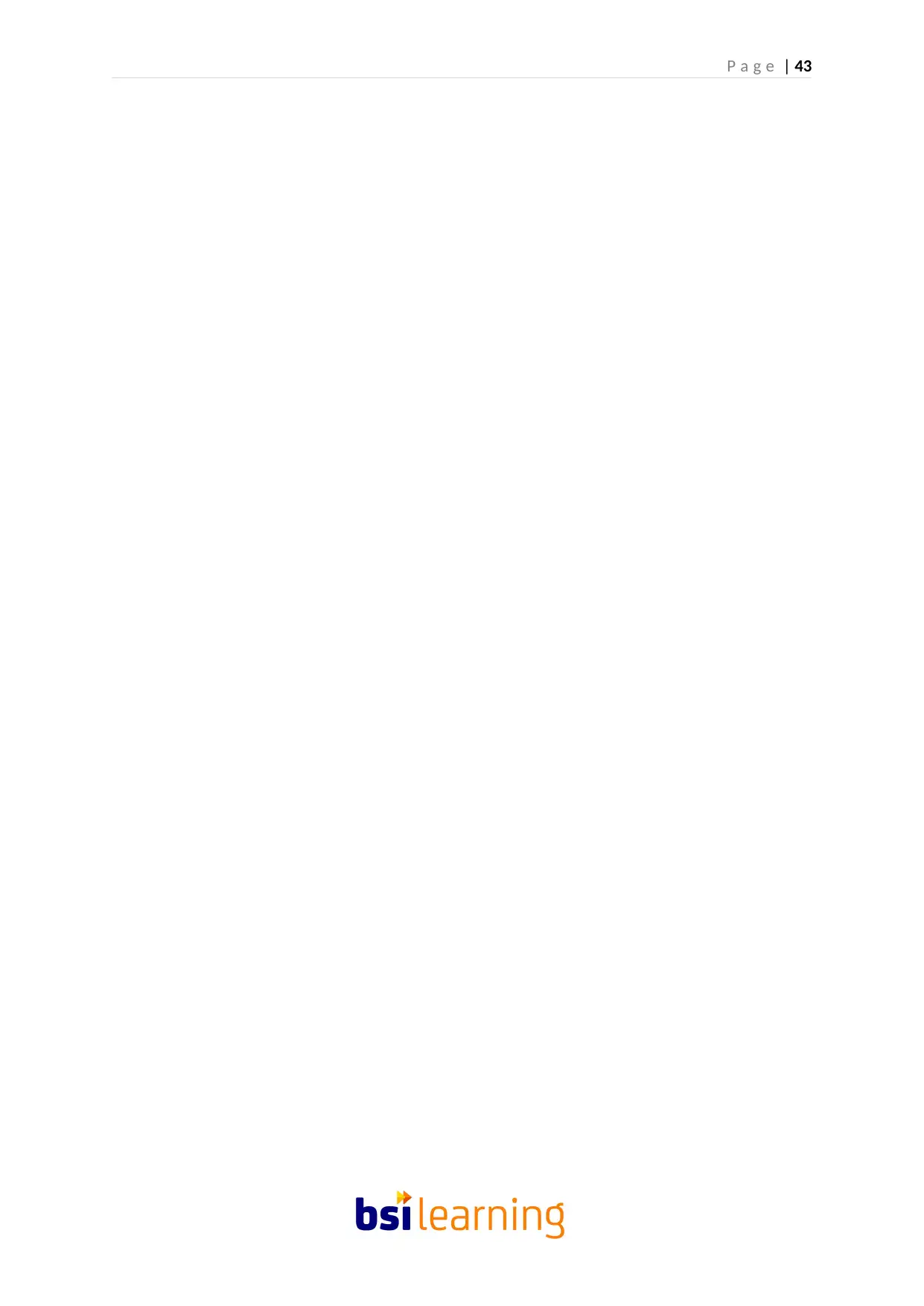
P a g e | 43
1 out of 44
Related Documents
Your All-in-One AI-Powered Toolkit for Academic Success.
+13062052269
info@desklib.com
Available 24*7 on WhatsApp / Email
![[object Object]](/_next/static/media/star-bottom.7253800d.svg)
Unlock your academic potential
© 2024 | Zucol Services PVT LTD | All rights reserved.




